One where life, family, and fulfillment comes before multi-million dollar businesses, vanity metrics, and looking perfect online.
Inside of Going Offline we explore what REAL life and REAL business can look like when we lead with intention and simplicity.
The truth is you don't need MORE in your business you need less. With simple, consistent systems you will be amazed how easy reaching all your goals can actually be.
It's time to stop sacrificing the ONLY life you have to the social media gods and finally Go Offline.
Listen on apple
Listen on Spotify
Listen on Google
whole new world
Welcome to a
of female entrepreneurship
Sell to more dream clients without selling your soul to social media
The Simple Podcast System to earn way more while doing way less
UNplugged
Profits
Register below + select the best date to attend this free masterclass!

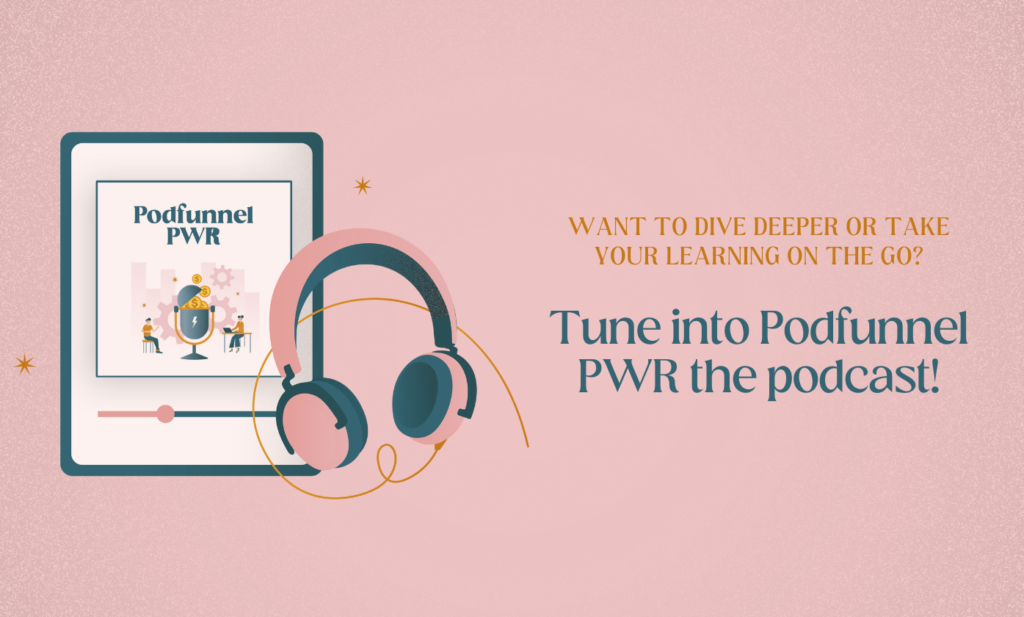
LISTEN ON SPOTIFY | LISTEN ON APPLE PODCASTS
Before we get started did you miss the first nine episodes in the series? If you did you can start at episode one here!
This is the final post of the podfunnel series! This one fully explains our done with you Podfunnel Power experience. Here, we help you create your own podfunnel – which is really the investment that keeps on giving!
This is a fluid program. When we learn things, we refine them based on action, implementation, research, and results. So as we continue to evolve this program, know that your initial investment provides you lifetime access to any updates that we make. We want this to be super effective for you in the long run.
So, let’s talk about the specifics of how our done with you service currently works. It’s already evolved so much, and we’re really proud of it.
Our Done With You Service

Our done with you service includes nine training modules that walk you through the entire process. This is a super, micro-level breakdown where we give you our knowledge and expertise to implement for yourself. You can also include your team on these learnings, which is another benefit.
These modules go over everything:
- The big picture stuff
- The sales process
- Planning and producing episodes
- Promoting your podfunnel
- Hosting and tech needs
- Naming your podfunnel
- Polishing and refining your funnel
There are also bonuses – like courses from experts on ads and copywriting, a lesson on turning episodes into blog posts to use the power of CEO, and more!
The best part is that we go step-by-step with you through the process so you can implement as you go. It’s not just about watching the training, it’s about making them work for you. The training includes examples, workbooks, slides, and video lessons.
Get Feedback from the Experts
This service includes something called feedback requests, which is the consulting element of this program. An amazing perk is that you’ll have consultants in your pockets and you can tap into us. We’ll provide you feedback throughout the process.
It’s not a coaching program – it’s about reaching a specific goal. But our expertise will be provided to you on an individual level, which I know will be extremely helpful.
This is a done with you layer of support where you’ll receive targeted and specific feedback. The people you’ll receive feedback from are those who are hands-on working with podfunnels every week. You’ll also receive access to a Slack channel so we can provide real time support.
Be a Part of The Pod Squad
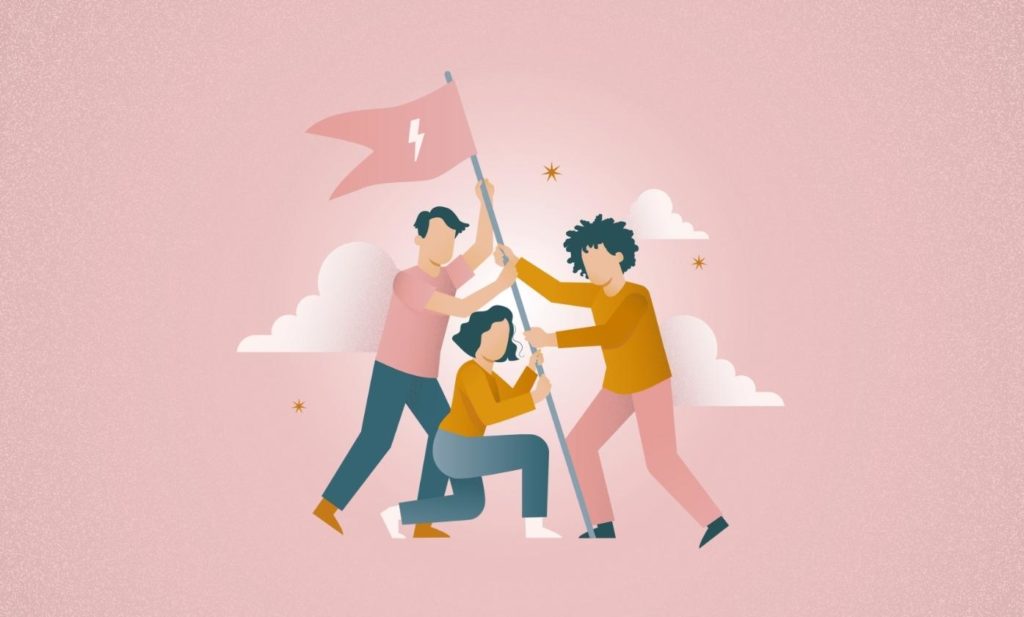
I also want to introduce you to The Pod Squad, which is part of this awesome offer. You can register for this four month journey through the program as a group, where you’ll be held accountable to getting your podfunnel off the ground.
Rachel, our Podfunnel Strategist, brings her expertise into this program along with mine. There will be support calls about all major elements you’re creating for your funnel, helping support your launch.
The Pod Squad is great for group accountability and motivation from others. You’ll receive accountability emails and follow ups from me and Rachel. This specific part of the program currently runs twice a year, and you can register for the cohort of your choice – do it whenever it works for you!
Investing In Our Done With You Service

Now’s the time where I talk about how much the program costs. The investment is $3,997. We have different payment plans you can choose from for this, which you can see on our site.
>> Check out all of the details here <<
This is a great time to get in on this offer, as after this launch, our prices are going to go up. We’ve recently revamped this program, so this point of transition is a good time to get in at an all-time low price!
Do It At Your Own Pace: The Bottom Line
Our Done With You program is all about you launching your podfunnel at your own pace. It’s still an intentional way to go about it, and it’s a Dreampro certified course. I can’t wait for you to get in on it and to start this amazing journey.
Thanks to everyone for following along on this podfunnel series – I really can’t wait to cheer on your success as you tap into this innovative and highly effective tool that’s unlike anything else that people are currently doing.
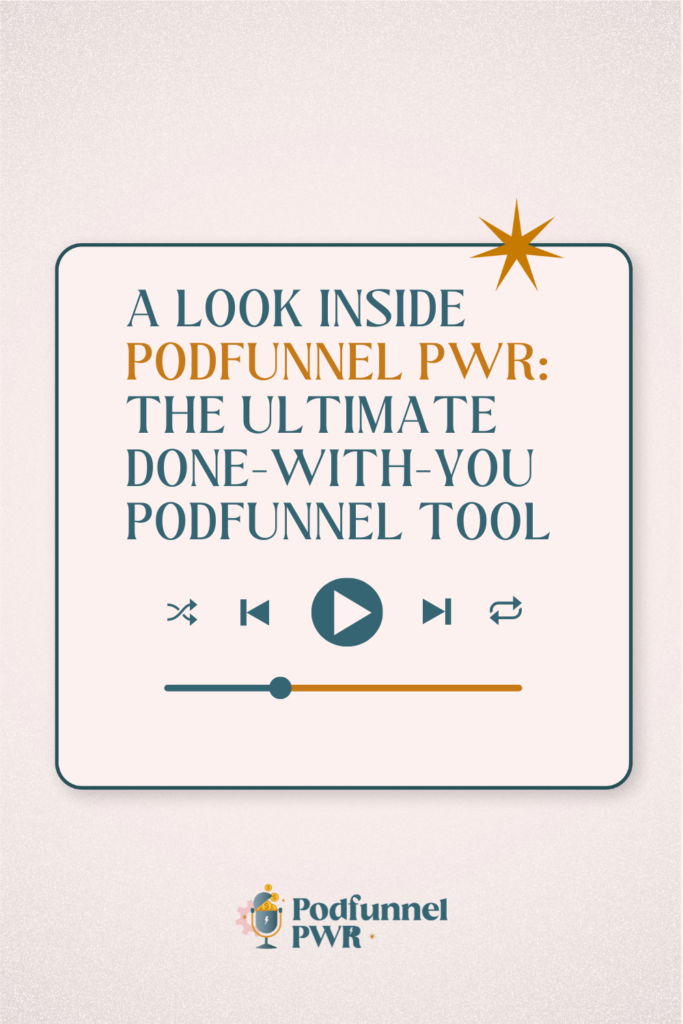
CONNECT WITH TARA:
WORK WITH US
READ MORE

I want to be really transparent with you about what offers are and aren’t ready for a Podfunnel. That’s because I want to see your Podfunnel succeed, and I know inside and out which offers are ready for that to happen.
Plus, I don’t want to see you put the time and energy into creating a Podfunnel for something that simply isn’t ready.
If your offer isn’t ready for that now – don’t worry! It doesn’t mean it never will be. Use the criteria below to understand whether the transformation you are offering is ready for this tool – and if you’re ready for us to work together!
A Proven Offer
You need to have a proven offer in order for your pod funnel to find success. If it’s not proven and ready to scale, you won’t know what the questions surrounding your transformation are. You won’t have the right market research on a brand new offer, which means that you won’t have any clue what kind of content to include in your episodes.
You need to have live-launched at least once – preferably a few times – with a good solid rate to get the most out of your Podfunnel.
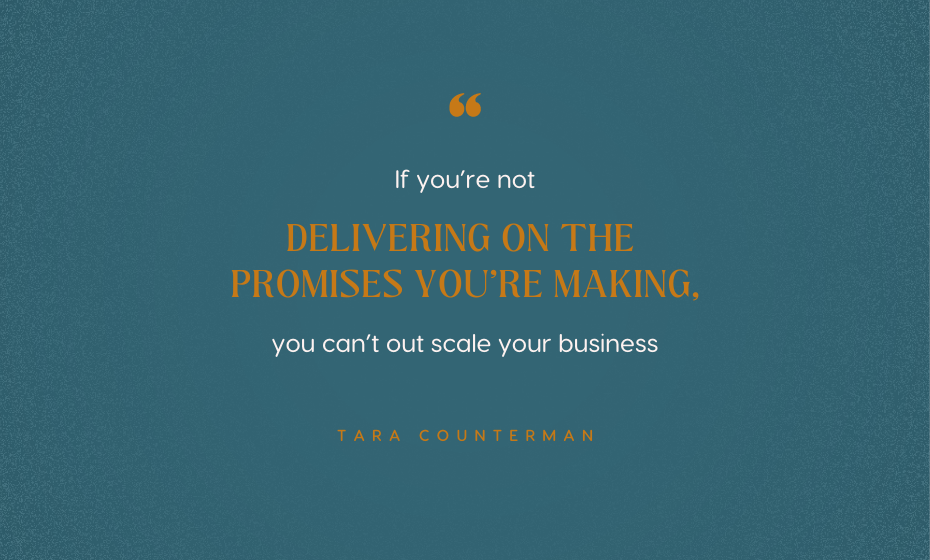
Client Testimonials
Another criterion to meet that shows you’re ready for a Podfunnel is having glowing client testimonials. You’ll want three, solid testimonials to start working on your Podfunnel.
If you’re not delivering on the promises you’re making, you can’t out scale your business. It’s as simple as that. You need to make sure that your offer is doing what it’s supposed to, and having these rave reviews from clients is a way of proving that.
Shifting Your Focus
As a note on that – if you find that your offer isn’t doing what it’s supposed to, you really shouldn’t be selling it and should focus, instead, on revamping it. Or, if you’ve tried selling it and it’s not converting successfully, put your time and energy into working on your sales, your messaging, and your marketing. Ensure your service is doing what it’s intended to before you try to scale.
To truly create a business that thrives, it’s no secret that you need a good product. If you’re struggling with this – I still want to help! I have wonderful referrals that can assist in setting you up for success and to help you make conversions. Don’t hesitate to reach out, even if it’s not to start on a Podfunnel. There are other ways we can work together, now and in the future.

LISTEN ON SPOTIFY | LISTEN ON APPLE PODCASTS | LISTEN ON GOOGLE PLAY
Tap In If You’re Ready: The Bottom Line
A Podfunnel is not as intense or as complicated as a funnel. In fact, it’s one of the easiest you’ll ever have built for you. But you shouldn’t commit to building one with us unless you are truly ready. Use the above as a guide to help you decipher if you are ready to take the plunge on your Podfunnel together.
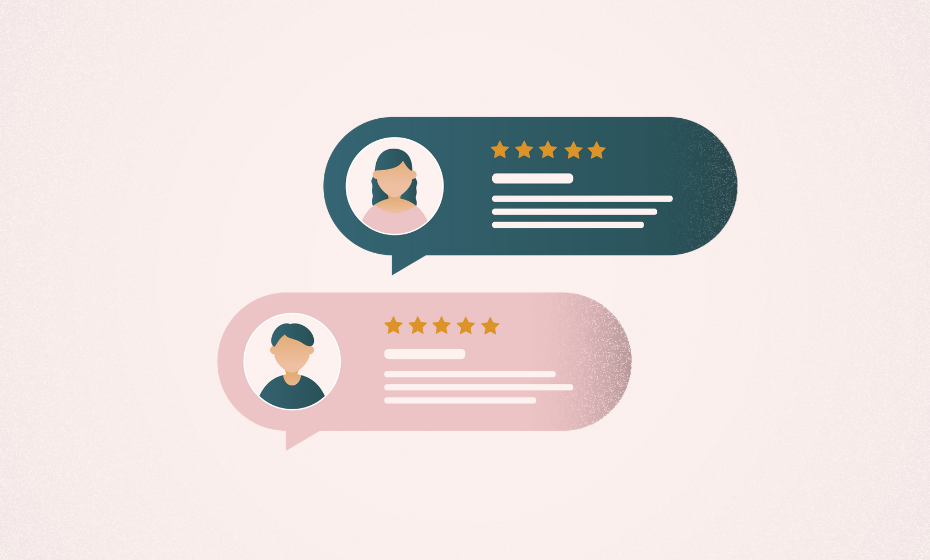
CONNECT WITH TARA:
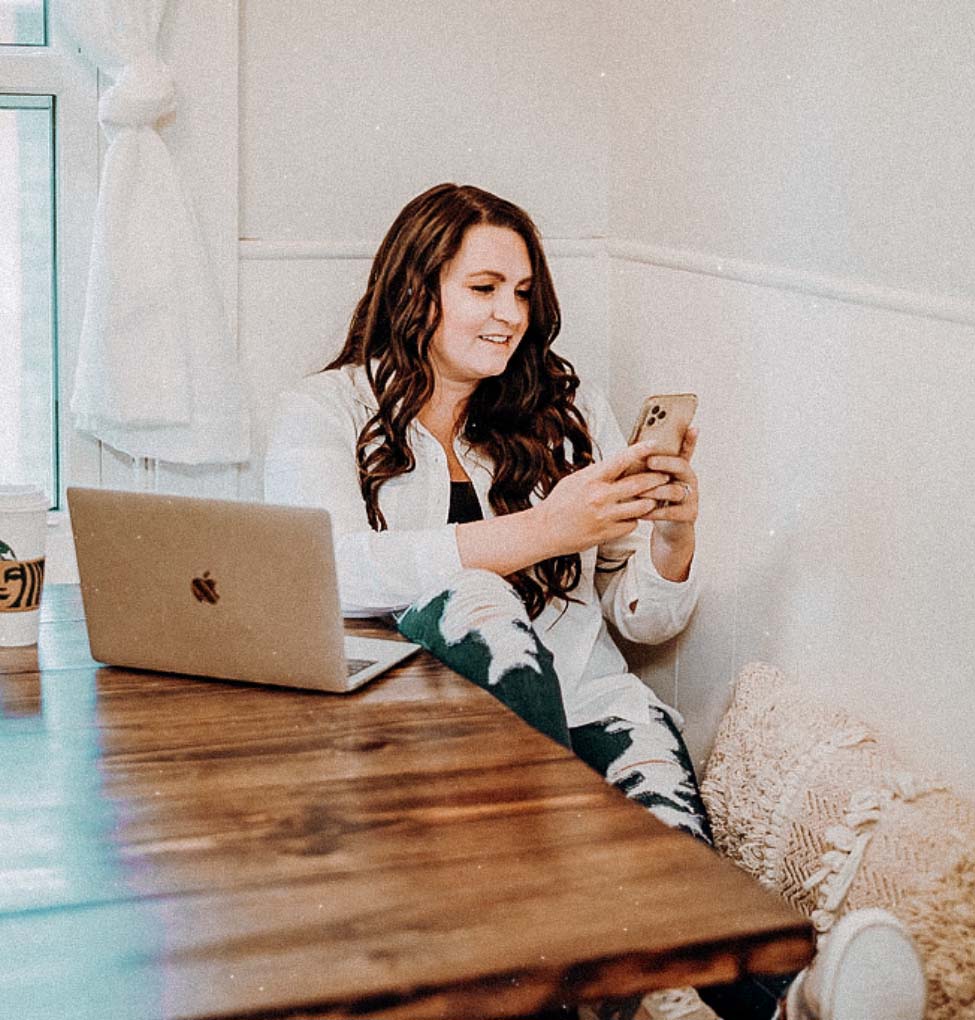
I know it can be tough to decipher if a podfunnel is the right business strategy for you. I have some qualifiers that will make it easier to determine this for you, your business, and your offer. Keep reading to learn more!
Having a Tested Offer
When you invest your time and energy into a Podfunnel, you’ll want to do so for an offer that’s been proven. So, this isn’t right for an offer that you’re currently testing or refining.
You need to have a clear idea of the transformation you’re providing and what the objections are. That means that you’ll need to have live launched your offer at least once, if not multiple times.
After each launch, send a survey out to collect feedback and build that library of information. You’ll also want to ensure that you’re delivering on your promised transformation, which can really only be done by launching a minimum of one time.
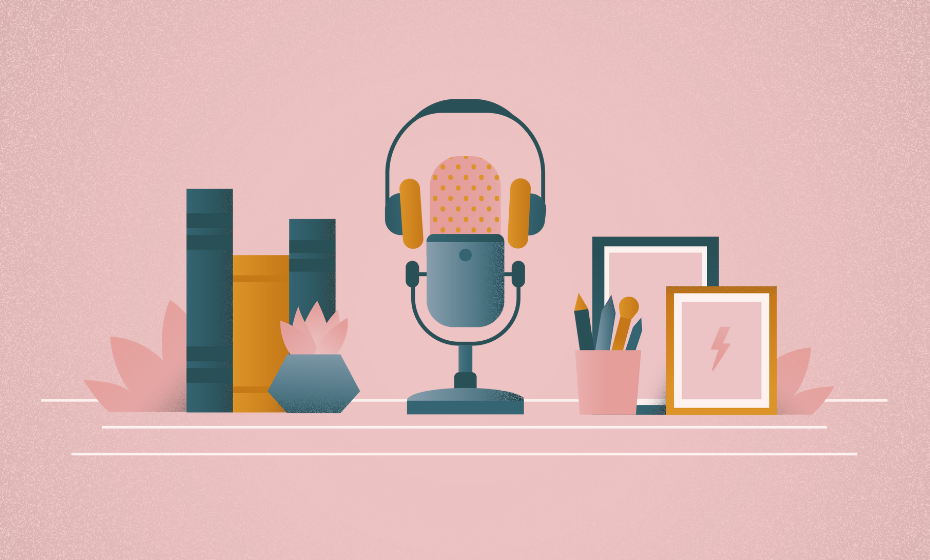
Verifying the Value of Your Offer
Next, you need to have something to back up the value of your offer. That is done well through client testimonials. You’ll want to ensure you have at least three raving fans that would be willing to sit down for a 30 to 45-minute interview for your Podfunnel.
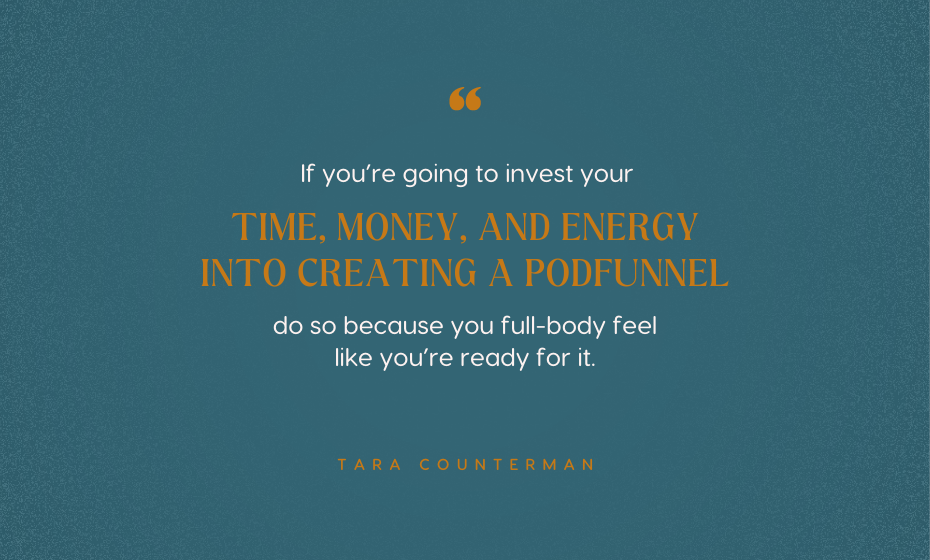
The Right Price Point
We really only work with offers that are high-ticket. That’s because low ticket offers are not something that people should have to work so hard to understand if it’s right for them, and you shouldn’t have to work so hard to sell them
We recommend offers of $997+ for a Podfunnel. This is something that your client will have to really show up for, which will make them more willing to do the work of researching the offer through a ten-episode pod funnel.

LISTEN ON SPOTIFY | LISTEN ON APPLE PODCASTS | LISTEN ON GOOGLE PLAY
The Logistics Behind Your Offer
From a logistical perspective, you need to make sure that you have the right things in place on the backend to bring on new clients. For instance, making sure you have a good onboarding process, a waitlist if you want to use one, and so on. You want to ensure that you can leverage the Podfunnel you create in a good way, and that means verifying that the systems and automation on the backend are properly in place/
Evaluate the steps of your process and optimize and refine them prior to committing to a Podfunnel. Hire people where you need to, train your people well, and just build a wonderful eco-system that allows you to serve your clients with excellence. You don’t want to fumble around in the background to keep up once you bring on new clients, so this is really important.
Invest Because You’re Ready: The Bottom Line
If you’re going to invest your time, money, and energy into creating a pod funnel, do so because you full-body feel like you’re ready for it. I know that this overview has helped you self-qualify yourself for a pod funnel – and I hope that it’s the right time for us to work together!
CONNECT WITH TARA:

When I started to work on pod funnels, I had a few important thoughts that, ultimately, led to the evolution of what I’m presenting with Podfunnel PWR.
I want you to understand my thought process behind pod funnels, learn how the concept came to be, and really dial into all that this can do for your business. Let’s dive into it!
Thought #1: I’m Over Sales Calls
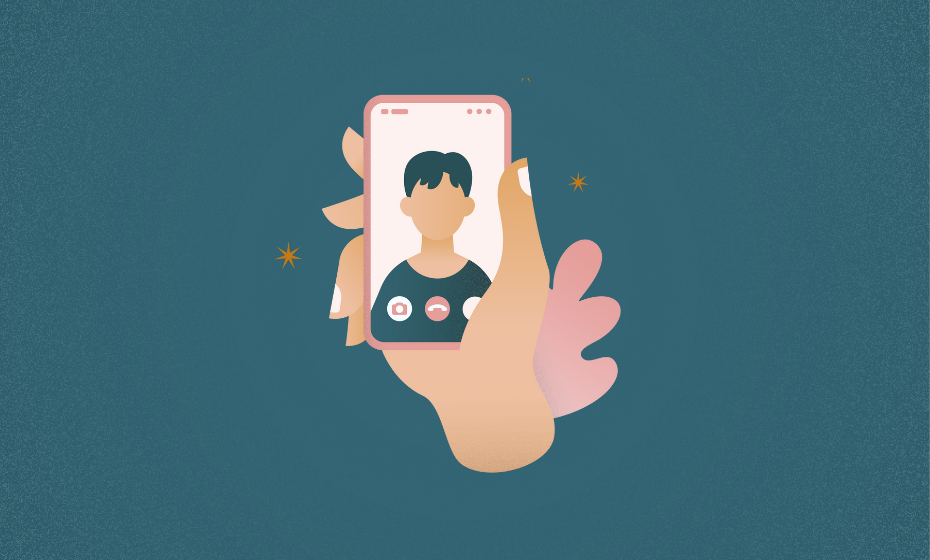
The first thought that I had when I started formatting how pod funnels would look was, “I’m over sales calls.” This doesn’t necessarily apply to ALL sales calls, but I’m over those that don’t lead to anything.
I used to think, “oh, having sales calls that don’t convert is just part of the process!” You know just as I do, we would all do the math in our heads – “if I want X number of new clients a month, I need to do X amount of sales calls.”
But that’s a lot of time on your calendar that you could be doing something more valuable to your business. Or – you know – you could be out there living your freaking life.
That led me to my next thought…
Thought #2: How Can I Convert Higher?
And then another…
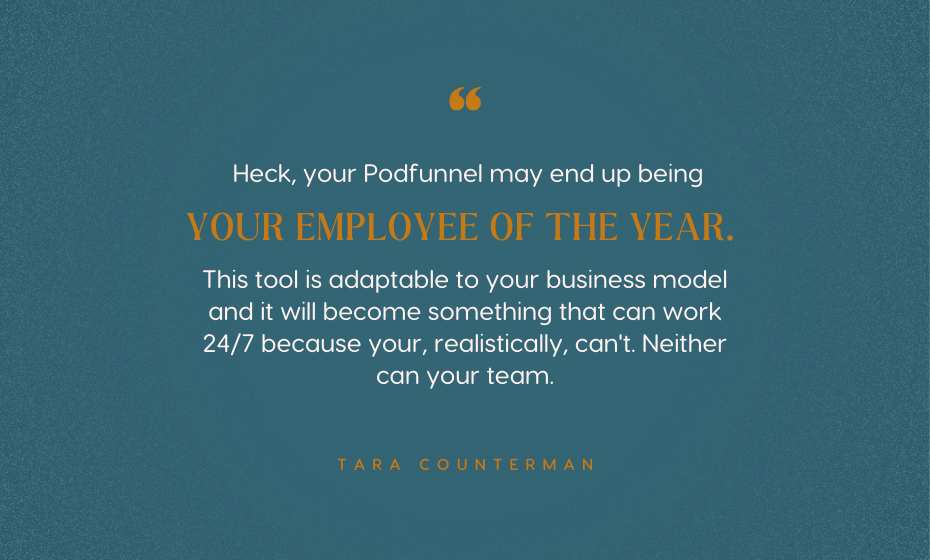
Thought #3: How Can We Save People Time?
It was then upon me! I needed to find a way to put a barrier between CEOs and the people that want to work with them. That’s because CEOs need a way to spend less time with people that are simply not a qualified lead.
And thus – the pod funnel was born!
How Does a Podfunnel Achieve This Goal?
So now YOU’RE probably thinking – how does a pod funnel help achieve this goal? Well, these short, intentional episodes truly breed success. They allow people that are interested in your offer to listen to your pod funnel and self qualify themselves.
Their questions will be answered, and this tool will filter away people that aren’t right for your offer before you ever have to get on a sales call with them. Say hello to your precious time NOT being squandered away on a sales call that won’t convert.
The New Employee of the Month: Your Podfunnel
Heck, your pod funnel may end up being your employee of the year. This tool is adaptable to your business model and it will become something that can work 24/7 because you, realistically, can’t. Neither can your team.
As CEOs, we have to position things in business and put the time and effort into the things that will work for us. Podfunnels will do that time and time again. It’ll allow you to work when you’re not REALLY working.
You know your ideal client better than anyone, so spend some intentional time in front of a mic and allow people to make an informed decision about whether your offer is right for them. All through the power of a pod funnel.

LISTEN ON SPOTIFY | LISTEN ON APPLE PODCASTS | LISTEN ON GOOGLE PLAY
A Sound Strategy: The Bottom Line

Podfunnels are a sound strategy because they take the pressure that exists in a sales call off of your potential client. They take you out of the equation, allowing your prospect to make the decision for themselves.
It’s a great strategy because you don’t need to be there to do it live. You can do it once, continuously empowering prospects to make their informed decision.
CONNECT WITH TARA:
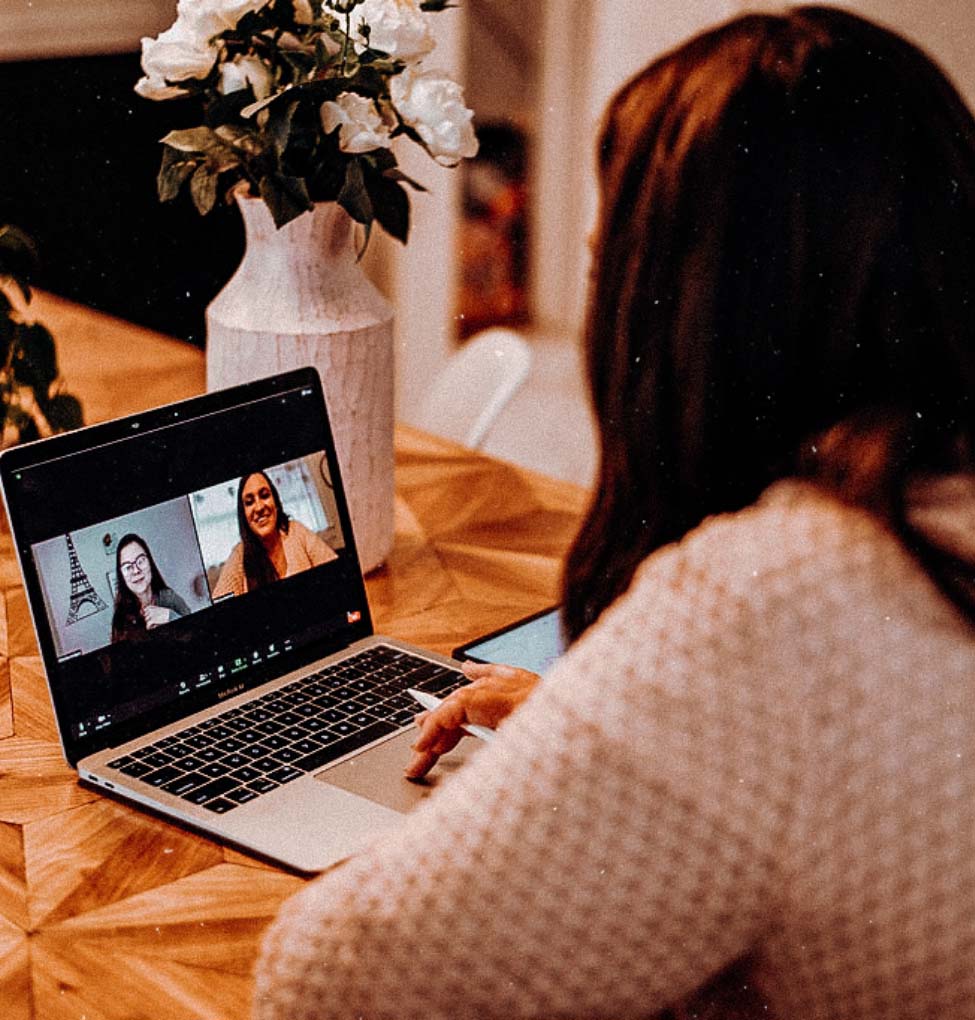
Welcome to CEO PWR The Podcast. My mission is to help you step into your CEO power!
Today I’m excited to have on Beatrice Kamau, the host of the Self Love Fix podcast. She’s a self-love and embodiment coach, an astrologer, and a lover of perfume & matcha green tea.
Ready to dive in to hear about her experiences working with CEO PWR and her work in this world?
Let’s get started on building successful partnerships!
Beatrice Kamau: Self Love Podcast Host and Coach
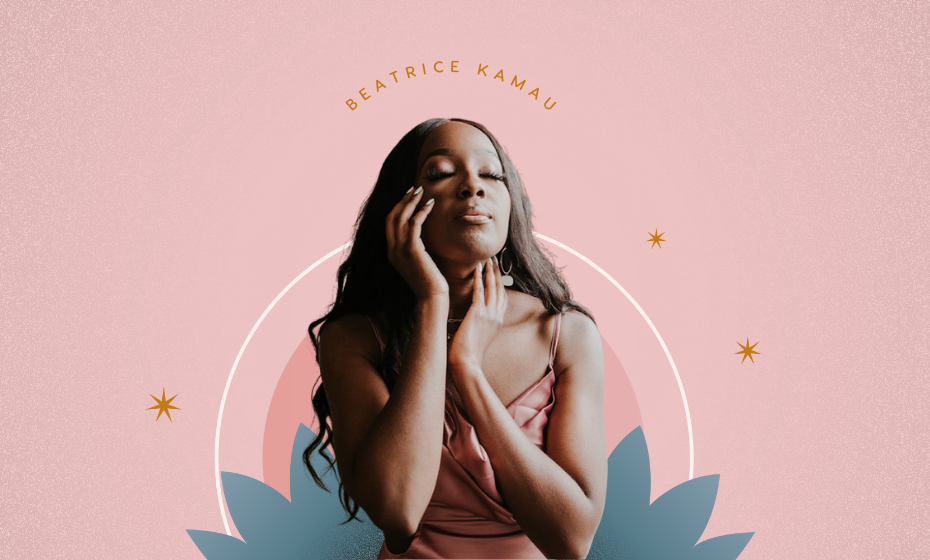
Beatrice is not only a host but a self-love embodiment coach. Her podcast was created to help people learn how to develop self-trust. Self-trust is a big embodiment and part of self-love.
Beatrice helps to understand deep levels of self-trust through intuition and facing childhood traumas that have been buried to have healthy relationships now and live thriving lives and not continue on autopilot. Her goal is to help you to trust your feelings and gain a sense of direction in your life.
Wondering why Beatrice chose the path of a self-love podcast host and coach?
In Grad school, she was a big perfectionist and didn’t fully understand why. Her desire to understand this more clearly led down a rabbit hole that brought her to her past. It brought her to her childhood and it was during this experience that she realized her childhood and her adulthood were related. Throughout her process, she discovered several tools for therapy and coaching.
“I was birthed from my own personal experiences. It changed my life and it saved my life and so I can’t just keep it to myself I have to somehow share with people.” -Beatrice
Was Podcast Host or Coaching First?
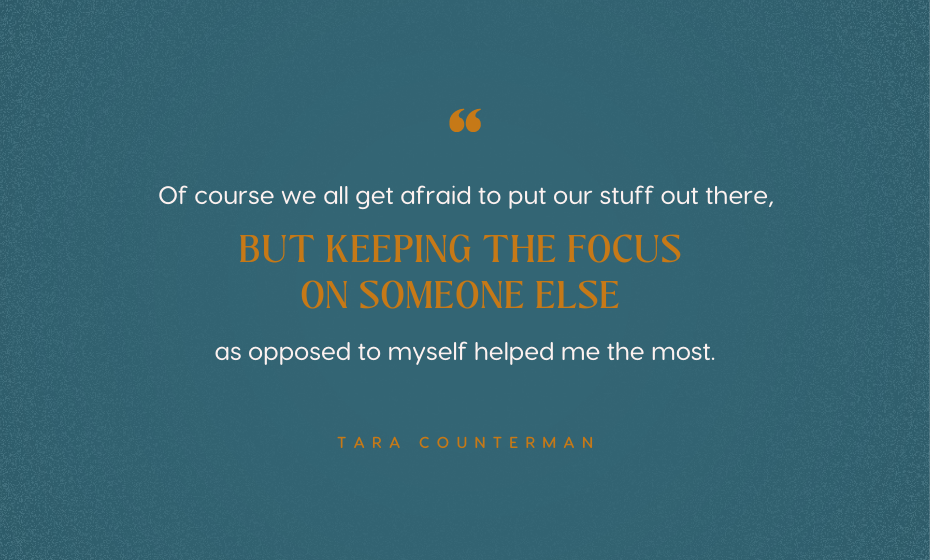
For Beatrice, these happened simultaneously, sharing knowledge with others along the way to serve others and help them.
With podcasting, it was front-facing.
“I was like, “I can figure it out”. It was all about the message and getting it out to others.” -Beatrice
What Did This Process of Starting Look and Feel Like?
Beatrice had the time at this point in her life, so she spent it on Google, reading ebooks, and was simply self-taught. She spent hours upon countless hours studying and learning. It was lots of research and lots of submitting.
What Did It Feel Like to Be Vulnerable and Open on Podcast?
In the beginning, it was hard because Beatrice didn’t feel confident so she would have little scripts. Then, she became less concerned about vulnerability and kept thinking about her message.
“I was in a bad place…I have to get “over” my fears because there are people who need some support and to know they’re not alone. This is what helped me put my stuff out there.” -Beatrice
“Keeping the focus on someone else instead of myself helped me.” -Beatrice
What is Your Heart Mission?
When we focus on our message versus being “viral” or a “billionaire”, it really helps to align with our community needs and this leads to a natural progression of purchasing offers. -Tara
“People would ask me, “How did you get so big?” I’m like “What?”. I couldn’t have cared less at the start. I believed my message had value. -Beatrice
Yes, it’s important to make a profit, but it’s not everything. It’s not what it’s really about. Remember–impacting a few people is important.
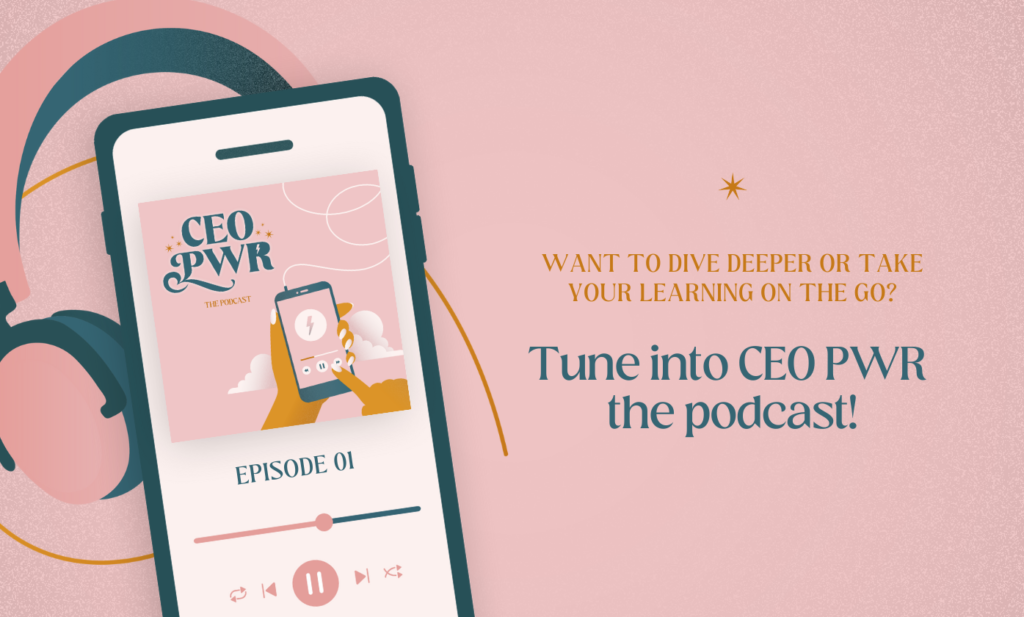
LISTEN ON SPOTIFY | LISTEN ON APPLE PODCASTS | LISTEN ON GOOGLE PLAY
What Are the Consequences When Your Motives Aren’t In Alignment With Your Mission?
“You can’t hide what your intentions are through your voice.” -Beatrice
This doesn’t mean can’t utilize podcasts for business!
Beatrice waived back and forth, for about six months before deciding to commit and coming on board with us. She had some limiting beliefs around podcasts.
“Podcasts aren’t known as being a profitable thing by nature, but I didn’t understand that it’s a vehicle. It’s a vehicle for reaching your ideal clients, for giving value, yes, but for sharing what you have to offer.” -Beatrice
For Beatrice, it was that and overcoming fears around selling. Knowing how to do it in a way that wasn’t off-putting. She realized she needed help and that it wasn’t her skillset, which is why she teamed up with CEO PWR.
This is how we’re building successful partnerships.
What Had You Thinking About Working With CEO PWR?
Beatrice realized she wasn’t sharing content around podcasts. She didn’t have awareness. With us, with CEO PWR, she was able to see the work we put in—our blogs, social media posts, etc. She didn’t have extra to give.
She also realized that with her guests, as they entered her listeners’ world, she realized she was shortcoming herself and that she had things to offer, too, but she wasn’t doing it. She was struggling with being everywhere and doing everything, as well as organization.
“It was difficult to know how to sell with no plan or know how to share.” -Beatrice
My first VIP day call with Beatrice was about content strategy. Beatrice made it known she is not a planner. CEO PWR worked with Beatrice to ensure she didn’t feel overloaded. This allowed her to feel free!
“One of the reasons that held me back was that you were going to make me talk about things I don’t want to talk about and it’s going to be rigid.” -Beatrice
But it wasn’t this—it was collaborative. We made sure to really hear her and find a way to lead into a launch and prepare people. We didn’t push her to be someone she isn’t—it’s always about finding a balance with our clients and finding what works best for each one of them.
What Happened With Your First Launch After Working With CEO PWR?
We first made a rough plan a couple of months ahead. We came at things from different angles and added variety to them. We decided to bring on past clients, which Beatrice was hesitant to do at first, but they were so happy and willing. Beatrice had even heard from multiple students that shared with her how seen they felt—how helpful this was for them.
“People are always looking for themselves in other people’s stories.” -Tara
Making this connection with the audience, even though it was done from the heart, with the right message, heavily impacted the audience’s decision-making toward buying Beatrice’s program.
“Wow, I didn’t think about prepping people. Prepping them through the podcast. It made a world of a difference when we did do that.” -Beatrice
This was the third time Beatrice had launched this specific program, but the first time while working with CEO PWR, and implementing strategic content planning.
Beatrice could see the difference. It more than DOUBLED her revenue—it was insane! There is a lot of clarity in podcast and messaging, if you are ensuring your messaging is right, that your content is right. Ensuring that the process is seamless.
“If your messaging is wrong people aren’t sure what they’re opting in to”. -Beatrice
Messaging is the foundation of everything. Yes, money is awesome, but also knowing how many people are impacted by your work is worth more than any dollar amount.
This was what was important for Beatrice. Her mindset wasn’t that this had to make her more money, even though that would be great, it was about getting her message out there.
“Thank you for this! This changed my life.” -Beatrice
What Was The Impact On You?
For Beatrice, the impact was resonating.
“Wow, a game-changer—a moment of needing more…wanting more…” from clients.” -Beatrice
She was happy to know that what she was trying to convey was actually getting heard on the other side of the microphone. It was resonating with people. Her message was being heard on a deep level and people were connecting.
There is this idea that podcasts can’t be all-encompassing. That they get overlooked, because they can’t reach your audience in all the same ways other avenues do, but that’s simply not true.
“Non-business coaches often have this idea that you can’t be successful in the same way or that it’s harder, but it’s not true at all. There are things people need—in every category possible.” -Beatrice
Podcasts have so many opportunities to clarify a message and speak to your ideal client. When you’re going through this process, around and around in the daily grind, it’s important you don’t lose vision.
You don’t want to lose sight of your mission. You need to ask yourself why you’re here and why you started in the first place. Plus, it’s too much to balance it all and get your vision clearly across to your audience.
“If you’re doing everything yourself, you’re going to lose the vision for sure.” -Beatrice
What Was the Most Unexpected Benefit from Working With Tara’s Team at CEO PWR?
“Learning how to plan.” -Beatrice
She now looked at her own business through a different lens. Her unexpected benefit was having more foresight and this allowed more wiggle room. Everything could work in concert with whatever was next. We could plan ahead two months through our relationship—so she wasn’t feeling pressured.
What Was Your Deciding Factor to Finally Say “Let’s Do This” With CEO PWR?
Beatrice could see she was scaling after two good launches so she really had to start looking at things from her “CEO hat”.
“When you put on that hat you make decisions that are for later. I realized I am scaling and if I don’t do it now it’s the last point, it’s now or never.” -Beatrice
“Am I going to have wanted to have worked with CEO PWR.” -Beatrice
For most of our life, we make decisions in the moment—personal or business. We’re constantly making micro-decisions, but we don’t stop to look at the bigger picture. What I love at CEO PWR is that our mission is helping business owners step into their CEO roles. Because once you’re here—the possibilities are endless.
Why CEO PWR vs. A Podcast Editor?
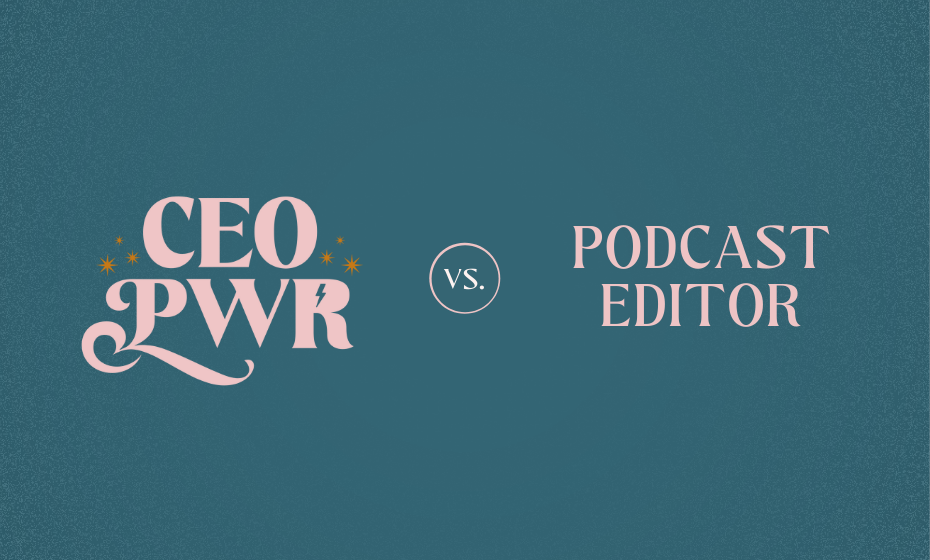
Beatrice shared that she really rode the fence on this one, but she knew that a podcast editor wouldn’t be able to create content. They wouldn’t know all of the moving pieces and be able to implement them seamlessly.
“With you, the great thing is you’re all “in the know” about the same thing, or your team is all “in the know” about the same thing, so it’s pretty hands-off—I don’t really have to do anything…” -Beatrice
“I can’t get enough of the copywriting, graphic design…everyone knows how to make everything flow the way I would if I could.” -Beatrice
As a CEO you don’t have the time and space to pull the episode apart and pull different pieces of content from it to repurpose and leverage. What we do at CEO PWR is we take over all the pieces and give it the love it deserves and still relays your message in multiple forms, for multiple learning types, and for how people consume it. Then as a CEO, you don’t have to worry about managing all of that.
“…With CEO PWR it’s dynamic…”
What Message and Programs Would You Like to Share?
I’ve really loved working with Beatrice, and I want to help share her message and connect you with this amazing & inspiring woman. So, here they are!
To find Beatrice, you can check out her website or find her on Instagram.
She also has a new dating program launching at the end of January and starting in February. It’s for those who are single and feeling doubt in their love life to transition into feeling magnetic and confident about dating and getting to have exactly what they desire.
The name isn’t yet revealed so you’ll have to tune into Beatrice’s podcast, The Self Love Fix Podcast, to hear all the details! It’s going to be amazing!
A special thanks to Beatrice for sharing her experience!
Don’t forget to pre-enroll for EMPWRED to leverage the PWR of podcasting to profit & innovate in your business…your way!
CONNECT WITH TARA:
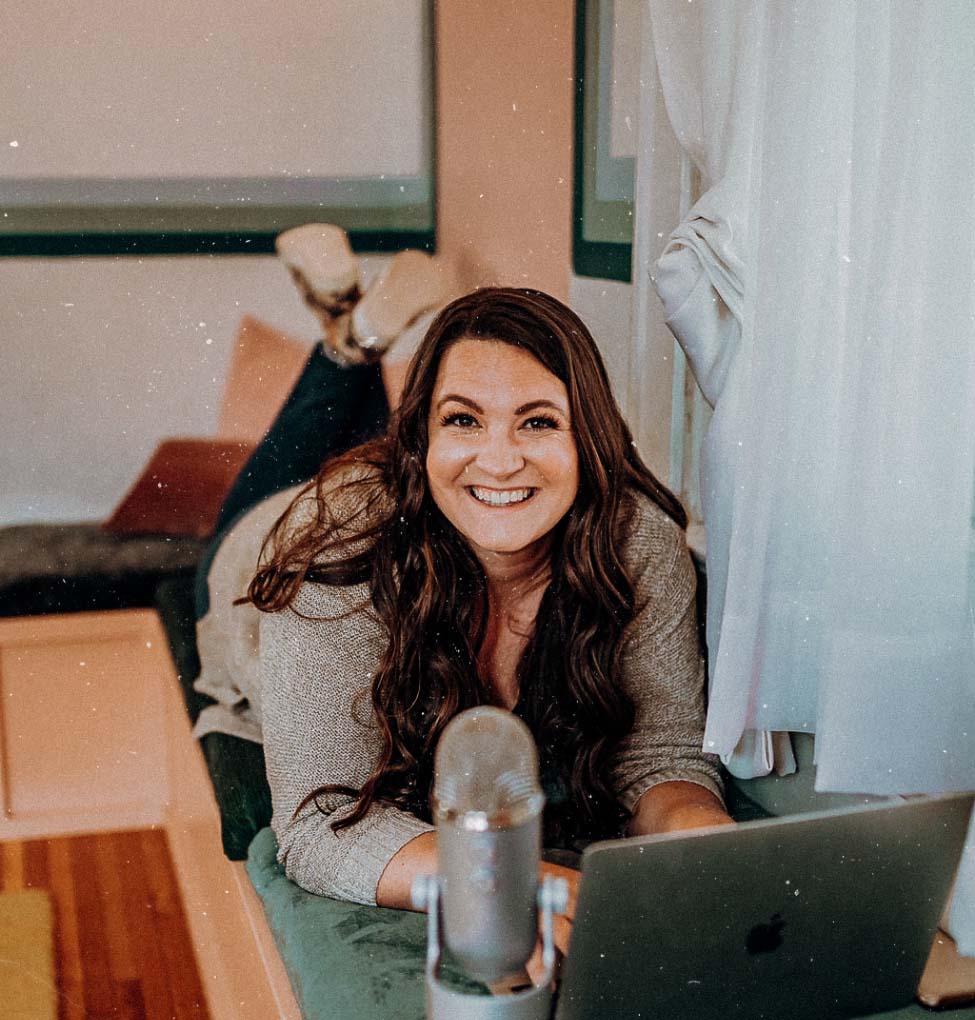
Today, I really wanted to dive into the importance of the content that you’re creating on your show.
Whether you’re a solopreneur or someone who has a support team, you as the CEO, as the person who is creating content and focusing on your messaging, it’s really important that you are intentional with that content.
Core messaging matters, so let’s dial in on this topic and dig a little deeper!
Inspiration vs Intentionality in Content Creation
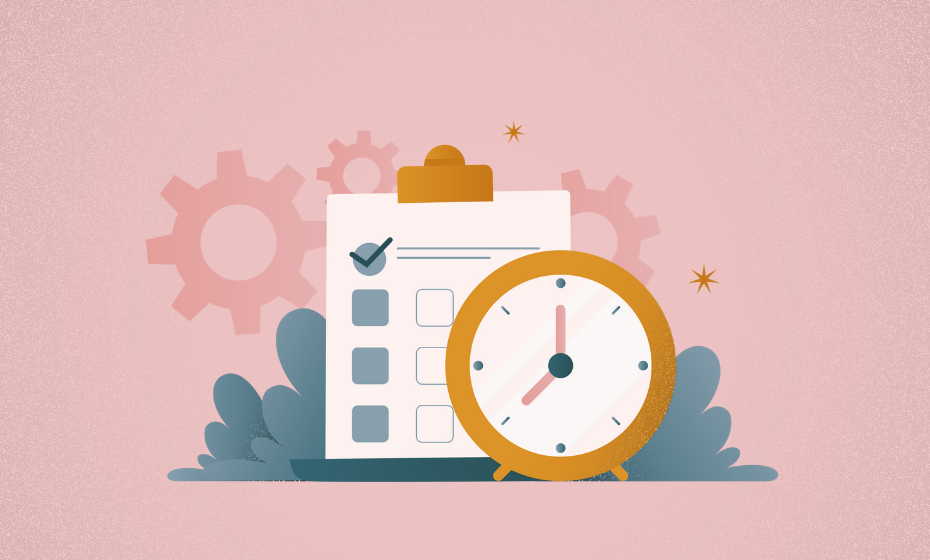
What we see happen in podcasting across the board is the approach of “what should I talk about today”, and their focus is not on their messaging, It’s not getting deep into the things they need to talk about and that their community needs.
Inspiration and being in the moment when planning content is important and good, but you have other avenues to create that. Wondering how?
If you want to create a truly profitable podcast, then you need to spend time in the content planning part of this whole process, right?
I love working with clients because we take care of everything else for them, so as the CEO, they can focus on their messaging—how to best support their business.
It’s very intentional because it’s really important that you focus on the messaging of your content—core messaging.
Podcasting is Personal
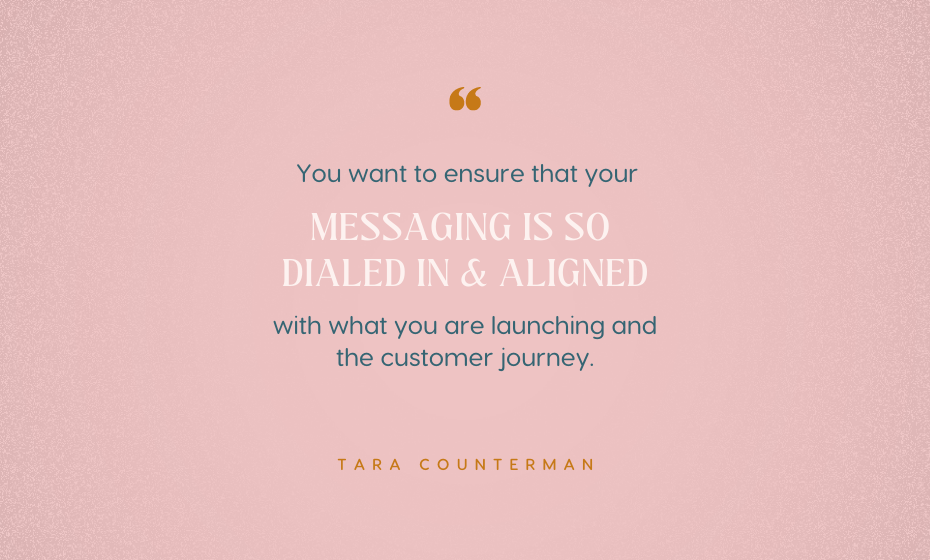
I really look at podcasting like a “library”. Other content will be sporadically shown as most people won’t scroll through all your posts and sequences. That’s why we want to look at your podcast as an opportunity to really take someone on a journey with us.
Look at it like this: What content and messaging should we have banked so we can drive people to it over and over and over again? What other connecting messages are there?
We want to ensure that the messaging is so dialed in and in alignment with what you’re launching and the customer journey that your ideal client needs to go on before they ever enroll in your program. We need to create content from this place, from formulating these different journeys that people can go through on the show. This is core content messaging!
With podcast, imagine you’re talking to one single person. This allows you to really build a deeper connection. How your listener experiences this on their end is how they’re building that one-on-one connection with you. That’s why it’s so important to be intentional with your content.

LISTEN ON SPOTIFY | LISTEN ON APPLE PODCASTS | LISTEN ON GOOGLE PLAY
I’m Letting You in on A Little Secret:
I can’t believe I’m sharing this, but I’m so excited for this next step in our journey, and I want to share it with you because of how it directly relates to core messaging and creating intentional content.
We’re considering embarking on a new journey here at CEO PWR. We’re looking at flying in clients, doing hair, makeup, planning messaging for months ahead to really create episodes that are going to not only convert but focus on that messaging that is going to allow them to create this huge bank of content that is core to their business and that is core to their offer.
What this really allows them to do is repurpose it into many different things.
They’re going to have podfunnels created for them, social media promotions, promotional videos, but at the end of the day when we’re done with all our work, the best part is that it can be repurposed into a thousand different things. Leverage in a thousand different ways because it is core messaging.
Something To Think About

What I really want you to reflect on in your podcast: Is the content on your show something that can be used over and over again in your business?
Is it core to what you’re offering? Is it core to who you’re serving? Is the messaging so dialed in?
IF it’s not, encourage you to spend more time here. If you already are super intentional with your messaging, then I encourage you to go even deeper—look for the core!
Evaluate your current content and if you don’t have a podcast yet, don’t worry—think about your content in general—anything you create like blogs or lives, and really evaluate the messaging you’re sharing. Even if you have a team for your show, we can’t use that as an excuse. Trust me—I know—we tend to think, “it’ll be fine”. Ask yourself though—is it actually serving and supporting you?
This is a platform where going deeper is going to mean deeper conversations, it’s going to be higher conversations, it’s going to mean so so much with the community that you’re building.
It means ensuring that your core message is foundational to your business, your offers, and the journey that your ideal client is on.
You’ve got this!
See you in the next one!
Ready to join the Content to Clients Challenge? Sign up here for all the details!
And don’t forget to pre-enroll for EMPWRED to leverage the PWR of podcasting to profit & innovate in your business…your way!
CONNECT WITH TARA:
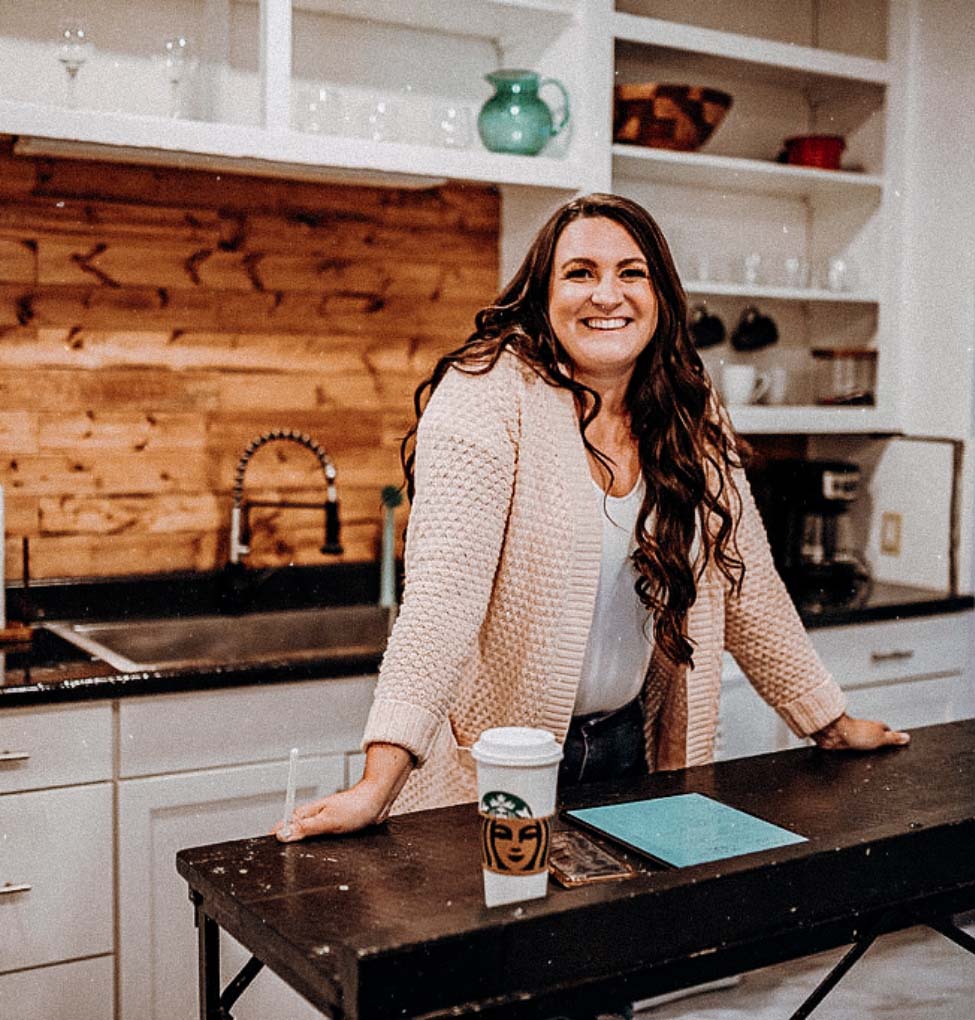
Today we’re talking about one of the most common things we hear as a production agency. What is that you wonder? Well, I’m going to tell you.
Time and time again, we hear people say, “I don’t have time to do a podcast.”
But guess what? I’m here to tell you that not only do you have the time, but you can use a podcast to get time BACK in your business and your life *mic drop*
But this is only possible if you use the right approach for your podcast. Learn more about the CEO PWR approach and why you need to reevaluate your ability to have your own podcast below.
Do You Actually Not Have Time for a Podcast?

I’ve found that people commonly believe they don’t have time to have their own podcast. And then when that belief exists, this idea manifests its way into that person’s audio. A podcast is about the energy behind what you’re saying and how you show up for it.
But if you have a podcast and you follow the CEO PWR approach, your podcast is no longer about time. Every minute going into your show with this approach gives you minutes back into your life.
This podcast generates more income because the content you’re creating is all about everything your ideal client needs to hear, see, and feel.
This approach means that your podcast can be leveraged into so many other pieces of content. Even if that content isn’t used immediately after every episode, it goes into a bank that you can use whenever you need or want it.
It’s all about leverage! This approach allows you to better use your time thanks to your podcast. When we look at the way we’re currently creating content, interacting with potential clients, or doing other day-to-day tasks, we’ll see that there is room for more efficiency.
One way to be more efficient is to batch content, which is something all of the clients we work with do. This makes things way easier than doing it all in the moment. It’s quicker, it’s all-around better content, and it leads to better leverage.
Changing the Way You Think About a Podcast
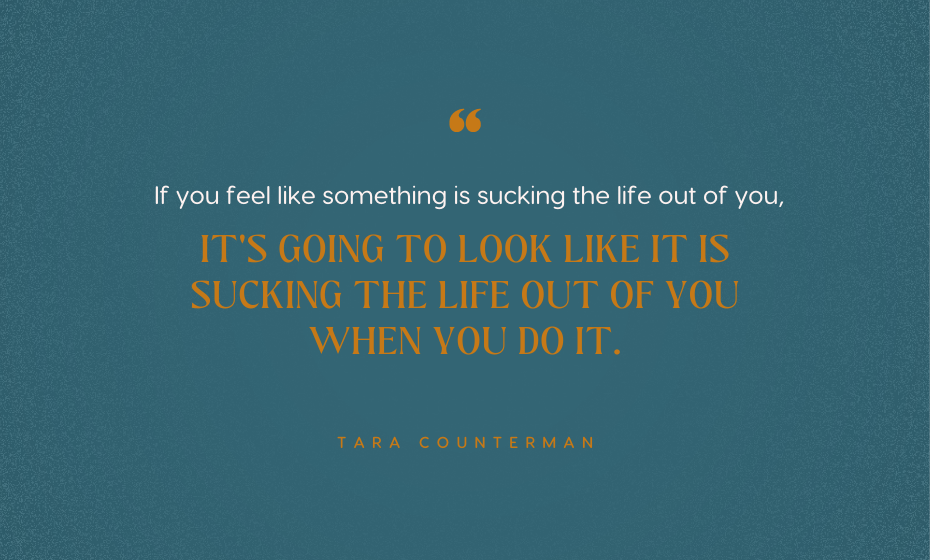
With all that being said, when I hear people say they WANT to do a podcast but don’t have time, it leads me to understand that they’re not thinking about the approach correctly.
That’s why I developed the CEO PWR approach. Creating content is important. But shouldn’t your time be spent servicing the clients you already have?
As a service provider, I know how important it is to show up for your current clients and provide them with that excellent experience. But I also know that it’s important to market and create content to reach new clients.

LISTEN ON SPOTIFY | LISTEN ON APPLE PODCASTS | LISTEN ON GOOGLE PLAY
If you’re considering starting a podcast but you know someone who did and it didn’t do anything for them, keep in mind that you’re looking at the experience of one person. They likely didn’t have the tools and support to leverage their content, analyze data, and ability to focus like they needed to to make it a success.
Use the power of audio and podcasts to reach your ideal, dream client. Others do it and you can do it too! With the CEO PWR approach, you can have a successful podcast that isn’t a huge time suck and that gives your business a host of benefits.
More Connections, Relationships, and Sales: The Bottom Line

Don’t write the idea of starting a podcast off. It will bring you more connections, more relationships, and sales. Trust CEO PWR to guide you into actually making your podcast something that is profitable for your business.
We’ve done this intentionally and repeatedly. We know it can bring you sales. Make sure that you’re not taking someone else’s experience and letting it put you in a box and assuming that their experience will be yours too.
If you’re ready to dive further into this topic, check out episode 79 of CEO PWR the Podcast for all the details.
And don’t forget to register for the Content to Clients Challenge! In 3 days, we are going to evaluate your current content strategy, dive into what conversion content really looks like, and learn how to leverage the power of your voice within your community. Enroll today!
CONNECT WITH TARA:

Today’s post is all about the CEO PWR approach. This is the framework and methodology of the program. This is meant to help you determine if this is in alignment with you and your goals for 2022 and to see if it can bring you more of what you want.
The Simple CEO PWR Approach

This approach was born from the work that we do with our high level, done for you clients. As you may know, innovation is really important to me. And another passion of mine is ensuring that the things I’m doing help me make the most out of my time and be more efficient. After all, time is the one resource that we can’t get more of. And that’s where this approach came from.
When I try a way of doing things and it’s really effective, I like to go back to it. So when I first came onto the podcast platform with my own show, I knew that most people who had them weren’t leveraging them to their maximum potential.
With that being said, I knew the power of this platform. It’s a great place to build relationships, nurture your audience, and ask for sales. And from those thoughts, the approach came to be.
There are three different parts associated with the CEO PWR approach:
- Produce
- Maximize
- Innovate
I explain each of these segments of the approach below to provide a more holistic view of how it works.
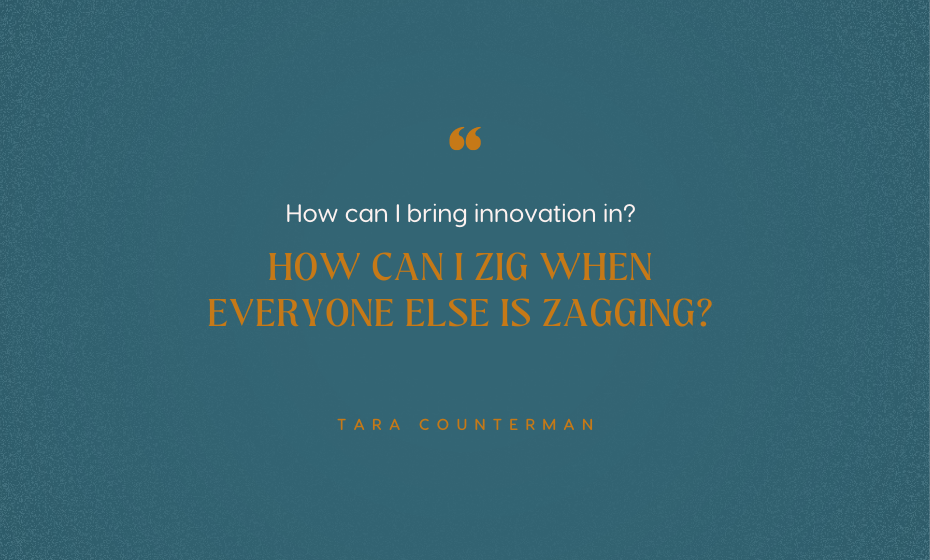
Produce
The first part is Produce. This is all about the technical or planning part of the show. Here, you’ll focus on simple ways to plan, record, edit and release your podcast. All of our clients can record in their own homes.
Most of your time should be spent on planning. Not recording and editing. When you have good recording abilities and good content — the rest of it so much easier!
I’m here to assure you that it’s all about the content. And someone editing their own podcast can be really damaging. It takes so much time and – guess what – everyone is their own worst critic.
This produce part is really about what you can do to be effective in bringing and nurturing and selling to ideal dream clients through your content.

LISTEN ON SPOTIFY | LISTEN ON APPLE PODCASTS | LISTEN ON GOOGLE PLAY
Maximize
Maximize is all about taking the time you spent in production and making the most out of it. I will teach you how to efficiently and effectively record so you can leverage that content in more than just audio ways.
This isn’t about cookie-cutter content. Different things work for everyone! I want to empower you to create things that feel good to you and that help you maximize the time that you’re putting in.
The content from your podcast can be used over and over again in different ways in order to give you the most out of it.
Maximizing isn’t just about sending people to your podcast. It’s about effectively using it in all areas of your business.
Innovate
Finally, we have my favorite part: Innovate. I am all for innovation, and that comes with knowing that everyone is very routined. That can happen a lot in business.
But everyone brings their own magic with their perspective and knowledge and resources. And I want you to get out of the copy and paste norm of business that’s out in there. Be empowered to think outside of the box and feel comfortable zigging where everyone else is zagging.
Innovate is about evaluating what works and looking at what kind of works but what can be better.
A Universal Approach: The Bottom Line

This approach is all about effective production, maximizing what we do create and figuring out how to innovate it, and bringing in innovation to do something outside of the norm.
I’m inviting you to apply this framework to your business and to your podcast. You will love where it takes you and all the time it gives you back!
If you’re ready to dive further into this topic, check out episode 78 of CEO PWR the Podcast for all the details.
And don’t forget to register for the Content to Clients Challenge! In 3 days, we are going to evaluate your current content strategy, dive into what conversion content really looks like, and learn how to leverage the power of your voice within your community. Enroll today!
CONNECT WITH TARA:
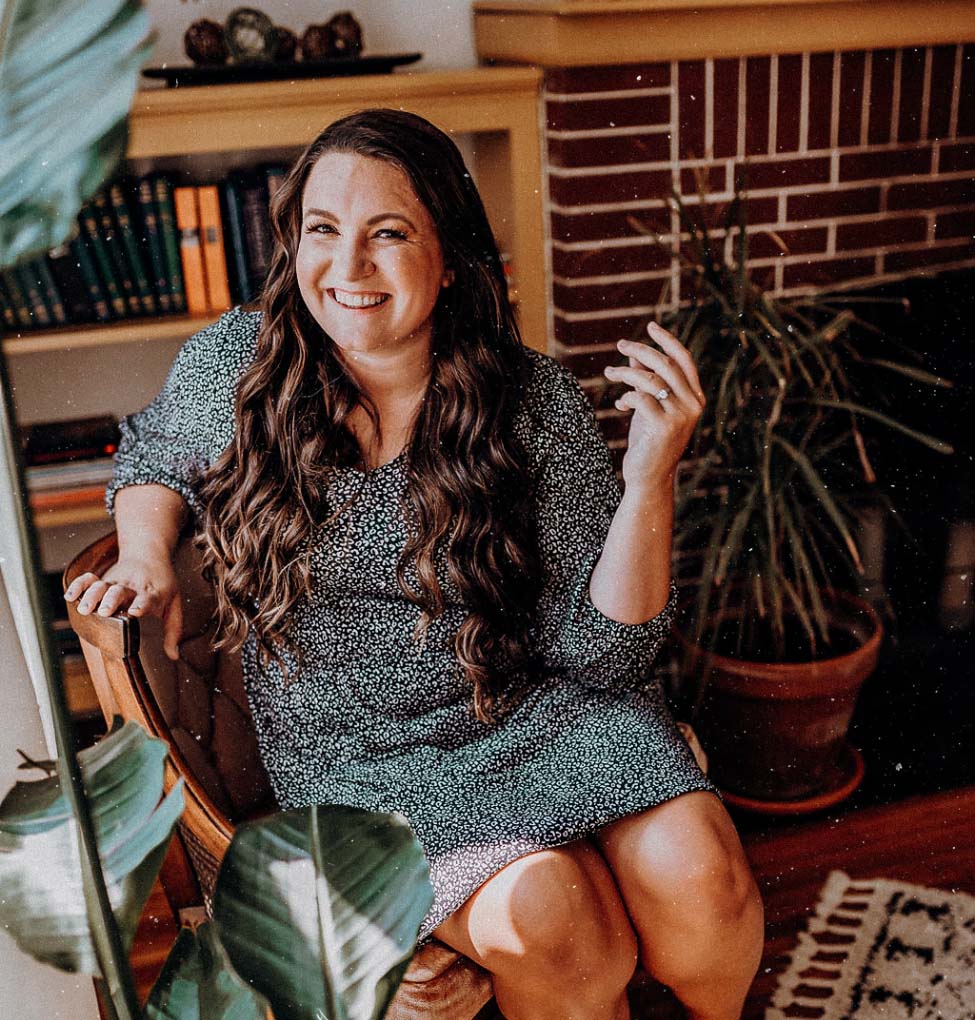
Are you ready to dive into a juicy topic today?
You know we can’t leave 2021 without discussing the great Instagram crash, or at least the effect that a crash like this can have on your online business.
There was a point, in the not-so-distant past that somehow, I got locked out of my Instagram account. My team could get in, but I couldn’t. The old me would have started a freakout of, “What will I do?” and “How can I sell?”, but I’ve since transformed to a place where I was okay in that moment.
I truly was okay being off it (Instagram)!
I knew I’d built diversification into my business that allowed room for unexpected hiccups like this to occur and my business to not only survive but still thrive.
Wondering how I got here?
Let’s dive in!
What Would Happen to Your Business if Social Media Disappeared?
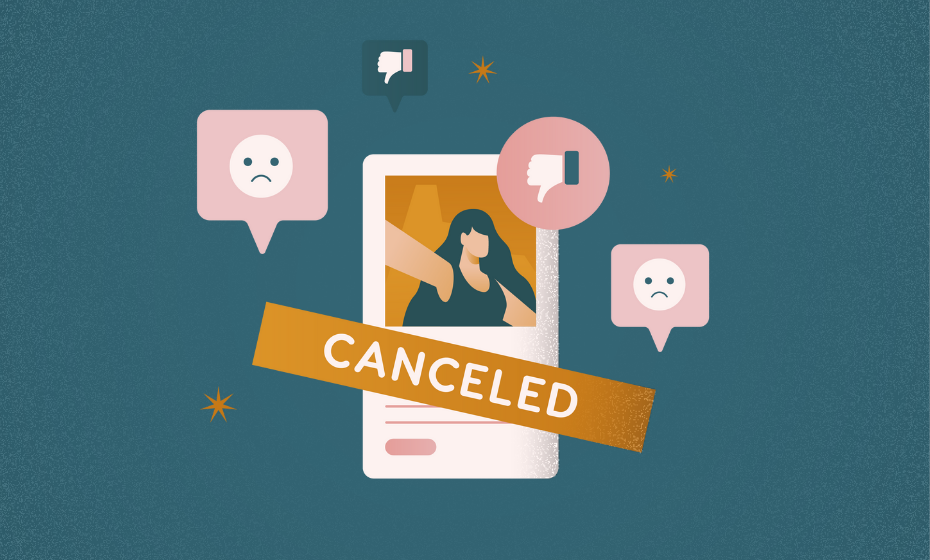
Earlier in 2021, we all experienced this panic of a social media blackout when Instagram temporarily crashed. The power of social media is extensive and truly awesome, but when we rely solely on these different platforms, we really are—
Putting all our eggs in one basket!
Everything on these platforms, like Instagram, TikTok, and Facebook is short-form content. It’s all easy to consume rapid-fire digestion of information, and then it’s on to the next attention-grabbing tidbit. We are missing one huge and fundamental piece, a human connection—a heart connection. Building lasting connections and cultivating sustaining and thriving relationships.
If building social media disappears, we don’t want you to disappear with it!
I’m not saying it must be a podcast, but I want to enlighten you to the fact that it has happened, and the truth of the matter is we don’t know that it won’t or couldn’t happen again. I want to help prepare you for when or if this time comes.
Let’s blackout-proof your business starting now!
How to Create and Implement Lead Generation Strategies: Cultivating Relationships
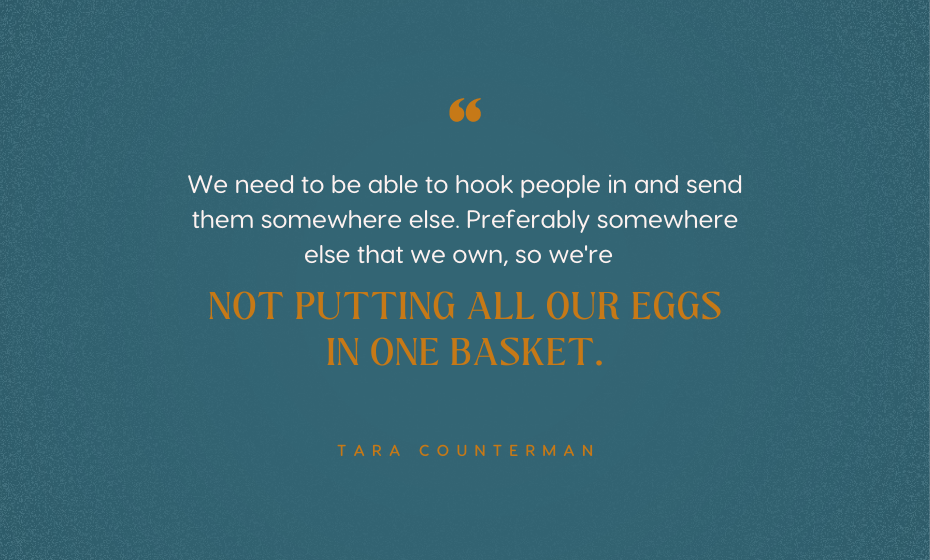
What would happen to your business if these social media platforms disappeared?
Would your whole business be gone?
These are questions I want you to ask yourself so we can get the wheels turning and create and implement lead generation strategies to help your business be successful whether social media has a minor meltdown or not.
I want to preface this by reminding you that I do believe it is necessary to have a social media presence, but overall, it’s thinking about the bigger plan. Yes, you should have some of this, but we need to think about the bigger plan. The bigger plan is intentional content creation, repurposing your content, and diversification.
Think about this whole process as marketers—
Connecting, nurturing, priming—this is how we hook people in and drive them from one platform to another to form a deeper connection. This is how we find people.
It’s asking yourself the question, “How can I make this a one-on-one experience in a more automated way?”

LISTEN ON SPOTIFY | LISTEN ON APPLE PODCASTS | LISTEN ON GOOGLE PLAY
Doing this in an automated way, and getting clear on email nurture sequences, having different segments in your podcasts, etc.—creates a whole journey for someone that they can dive into and binge. This is powerful for relationship building!
Remember, people don’t buy from people they don’t like or don’t trust…or from brands they don’t like or don’t trust!
Your goal here is to hook people in and then send them somewhere else, to a different platform that you own—this is what not putting all your eggs in one basket looks like.
This is creating lead generation strategies! Go you!
The key to this is that something like an email list, you own. You can take the context, download it, and move it. The raw data is yours. Something like Instagram, TikTok, or Facebook, doesn’t allow you the same ability. If it disappears—it’s gone.
Establishing Streams of Lead Generation: What Would Happen to Your Business if Social Media Disappeared? – The Bottomline
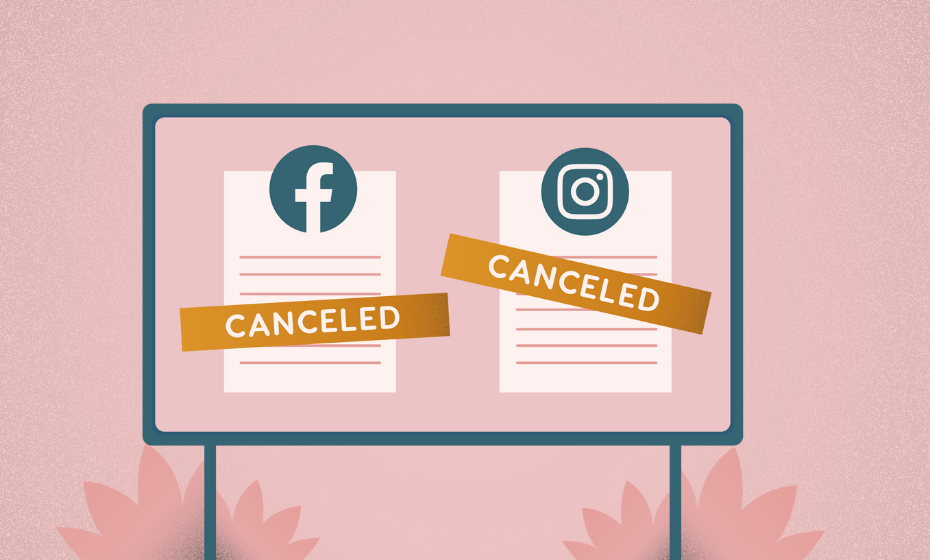
At this point, it’s not hypothetical anymore—it’s happened—social media blackout…
Here at CEO PWR, we get most of our business through other platforms, which are not social media. We do some social media platforms because we do like to show up in these ways, but we focus on emails, community connection, and serving in this way, blogs, through podfunnels. This is how we build those powerful and sustaining relationships that we all desire!
Automation can sound negative, right? It’s not though!
When you know who you’re speaking to and what they need to see, hear—what they need to believe, feel, and what you do and how you can help them, then it doesn’t matter if it’s automated or not.
It’s simply, and rightly, the content they need, and you can deliver it!
Different content platforms help create different ways to bring in leads and sales so if one falls away, you can still be okay.
Different streams of lead generation offer different streams of income.
It’s about picking a few platforms and consistently showing up and picking a few you can automate and easily repurpose and leverage in different ways. It’s about being a heart-centered entrepreneur and making your business work for you!
Have you diversified your business lately?
You never know what’s going to happen…
If you’re ready to dive further into this topic, check out episode 77 of CEO PWR the Podcast for all the details.
And don’t forget to pre-enroll for EMPWRED to leverage the PWR of podcasting to profit & innovate in your business…your way!
CONNECT WITH TARA:
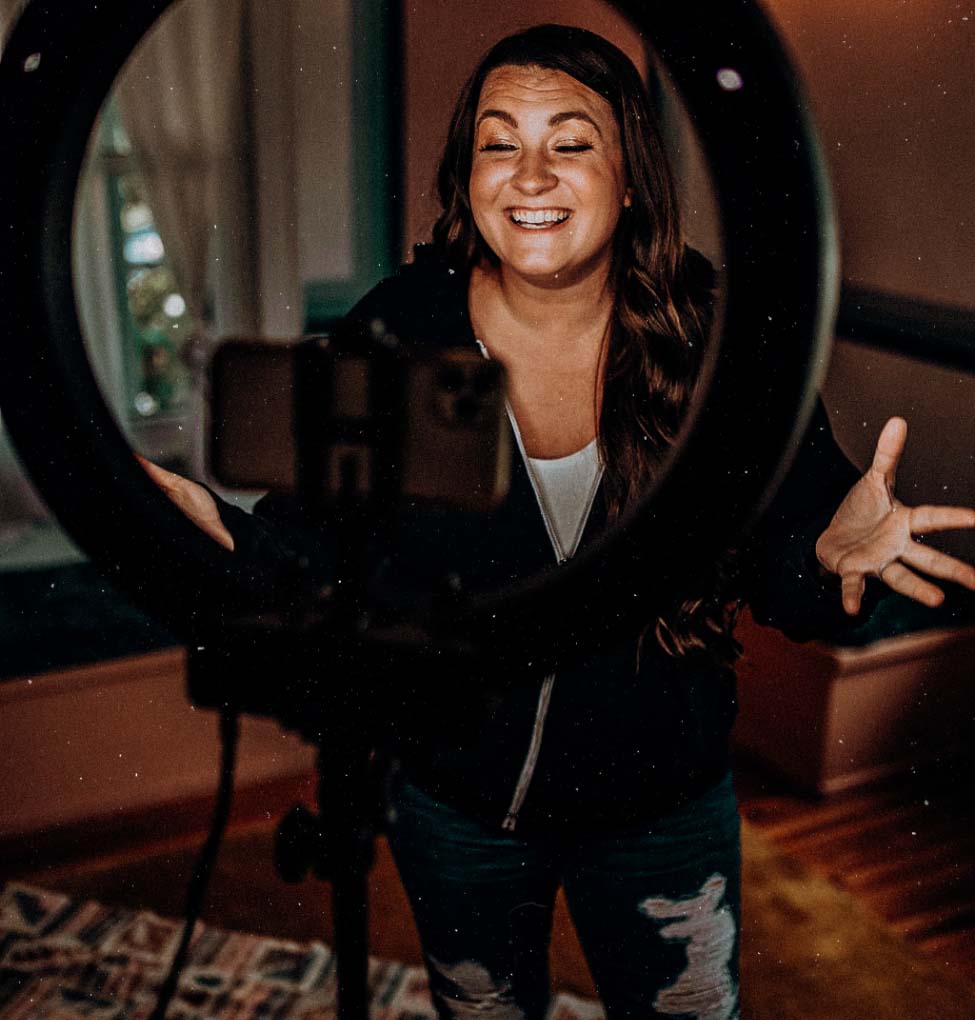
This episode is about giving yourself permission to relax!
Yes, it may seem counterintuitive when there’s always so much pressure surrounding social media to constantly produce new content. I’ve learned though, through reflection, trial, and error, that staying on the social media platform hamster wheel 24/7 isn’t what creates profitability, success, and it doesn’t always yield the expected response.
Moving into 2022, I want to show you how to make your content work for you by creating intentional content—
Content that works for you!
Creating Intentional Content: Working Smarter Not Harder

I have learned an amazing truth—
It’s not about more content, it’s about the right content, for the right person, at the right time.
We need to remember that the message we’re creating today matters, even if that caption, podcast, or whatever other platform it is we’re utilizing right now, doesn’t swell with an overwhelming response, that our content—our creation, still matters!
It doesn’t mean the message can’t work for you and serve you and your ideal client. It’s about making the most out of what you’re doing so you don’t have to do more.
Curious what this looks like for you?
How to Reuse and Repurpose Your Content
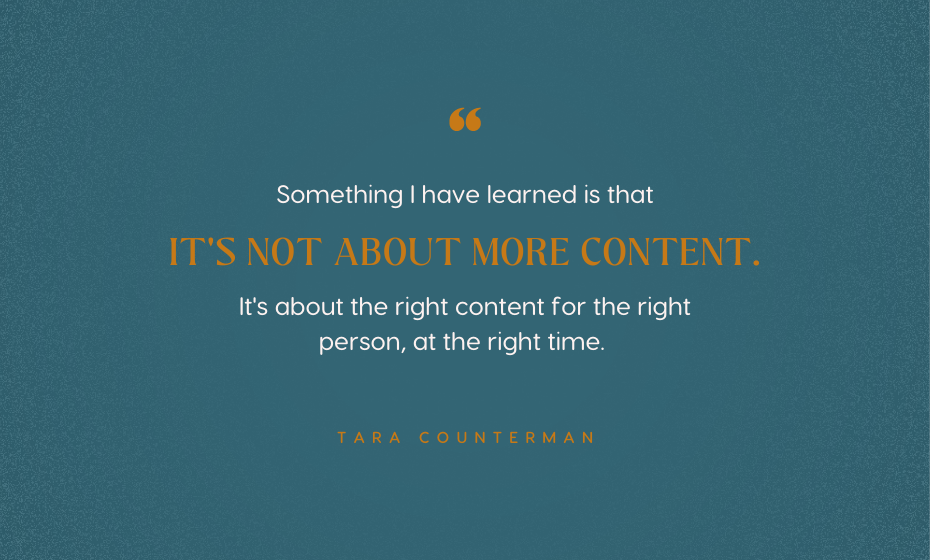
Some of you may think that a weekly podcast is a lot to balance and you’re wondering how I’m “relaxing” in any sense of the word. Truth is, I really am! Each episode I create is different; it is unique within its message, and with each message, I’m creating macro content.
With this macro content, my team and I can take it and repurpose it for iTunes, Instagram, infographics, carousel, quotes, different captions, and blog posts so eyes will find them.
One question I always ask myself is,
“How can I create the things for my ideal client, share the messages that need to be heard, and then continue to share those messages, so it can spread its wings and fly?”
Even though what I’m creating each week is different, there is also a universal message that evolves within these stories, and it’s ultimately the same focused goal: Creating content to help support my ideal client while they embrace their journey!
It’s all about creating intentional content, not more content.

LISTEN ON SPOTIFY | LISTEN ON APPLE PODCASTS | LISTEN ON GOOGLE PLAY
Creating Heart Value in Your Content: Building Relationships
When the reels trend on Instagram was big, believe me—I hopped on. I became so focused on creating more content, but what I realized is that I wasn’t creating the results and transformations I desired. I strived for “more”—more views, more followers, but what I realized is these didn’t lead to success and ultimately joy. It led to burnout, and it led to a sidestep of the message I wanted to share.
What ended up happening is that sometimes I wasn’t even sharing the message I wanted to share at all, and I knew I wasn’t giving it my best—I wasn’t sharing my heart.
Do you feel this same pressure?
I want to remind you that you don’t have to stay here. You can create highly effective and intentional content and repurpose it. Let me give you a personal example of mine to help paint a clear picture for you on how to follow your journey.
There was someone I followed for years online, and even though I didn’t need her specific services at the time, I truly just valued who she was and what she offered. I knew, though, when the time came and I did need these services who I would go to. I chose to follow her and connected with her, because what she shared resonated with me. It wasn’t a specific day or time that her content was shared that drew me in, it was her consistent resonating message that invited me in and that is what opened the door.
That is what I want your takeaway to be here today—you don’t have to show up every day and balance a million things. You don’t need to do that to make your content powerful.
Your goal isn’t solely of numeric value—it is of heart value. Hook them in but drive them to a place that’s easy to consume and drive them to embrace and build a relationship with you. Take your core foundational message—what people need to see, hear, feel, and believe in order to say yes to your offers, and create your content around that. Then you create the little highlights that are showcased on different social media platforms. They are the hooks to drive them back to long-form nurturing from you.
I’ve said it so many times and I will say it again because it’s that profound—intentionality; intentional content. Be intentional about talking one-on-one, like you are having an intimate conversation with just them. It’s often underrated but it is so valuable the depth of connection. A podcast is a beautiful platform in that it allows you to get off the social media hamster wheel and hear, truly hear, someone else and connect in a deep and meaningful way.
When you intentionally plan and record, you can easily pull out what you need—even if you’re a solopreneur. It is possible!
Even if Podcasting isn’t something you want to focus on in 2022, there is still so much you can take from this message, right? Remember—it’s about the right content, at the right time, for the right person.
Allow what you’ve already created to work for you!
Time to Spread Your Wings: The Bottomline
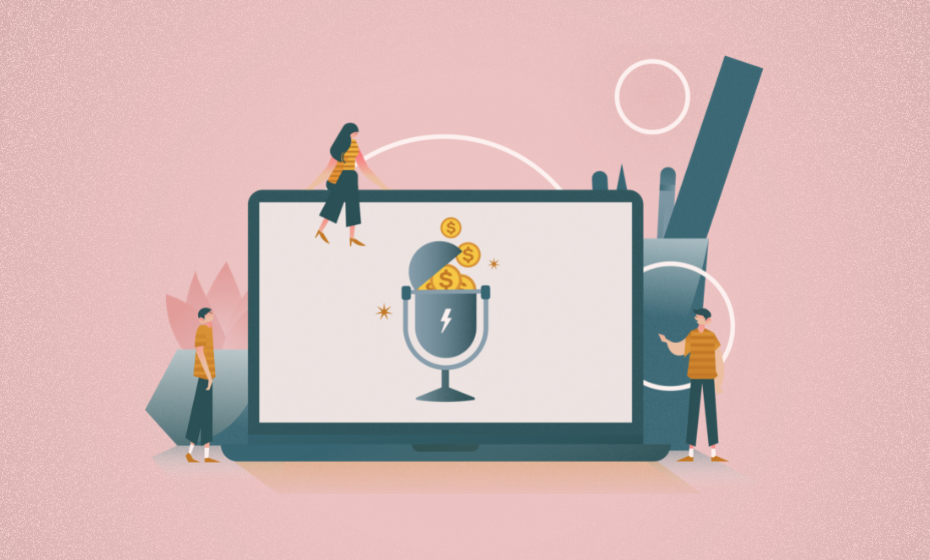
Life is ever-evolving and circumstances are constantly changing. People’s desires change and things happen, come up, shift, and grow. When you repurpose and put heart into your content, you are putting it out there in different ways, allowing people to hear you and understand the level of importance of what you’re saying, so you can be successful!
What will bring you more sales and more clients isn’t going to be more posts and reels; it’s going to be ensuring each person feels seen, feels heard, and feels empowered to win. It’s about connection!
It’s not about more content—it’s about intentional content with heart. This is what allows you the freedom and ease that you deserve!
Know what they need to hear and go share it with them!
Happy Holidays!
And don’t forget to pre-enroll for EMPWRED to leverage the PWR of podcasting to profit & innovate in your business…your way!
CONNECT WITH TARA:

What does sustainability mean to you? How about success? Joy? When you think of these words, what do they signify to you?
What if I told you that you could gain the space you need in your life to create success and joy, if you were to implement a sustainable business model?
Wondering what that is, or what that may look like?
I’ll share a few of my successes, as well as downfalls, and ask a few key questions that provide you the opportunity to create a revitalized sense of balance, purpose, alignment, and ultimately—
Joy!
The Dynamics of a Successful and Sustainable Business Model

Your business, your relationships, and even your health will all blossom and flourish with proper alignment. The reason that creating a sustainable business model is such a successful tool is that it allows you, as a business owner, as an entrepreneur, to step out, step aside, and release yourself from the constant pressure and demands of the daily grind, without having everything fall apart. It is vital, necessary even, to create a sustainable life. A joyous one!
There are a few key aspects when it comes to creating and implementing a sustainable business model that will work for you and with you. We’re going to review a few key questions I have for you to really dig deep and self-reflect—not only on the business side of your life, but in your personal life as well. After all, these pieces are not separate from one another, they are a cohesive unit that ebbs and flows. At times like the peaceful swells of the ocean waves, and other times like a hurricane.
My good friend Taylor Slango from the Aligned & Ambitious Radio podcast talks a lot about “spaciousness” and what this means. What does spaciousness look like to you? I invite you to check her out—she’s incredible!
For me, spaciousness looks like ensuring I am leveraging, batching, and creating intentional content. In doing so I’m freeing up and balancing all areas of my life. I’m creating joy! I’m instilling a sustainable business model and letting what I’ve implemented work for me so that I can step away, step back, from the constant pressure and demands of being an entrepreneur and business owner. I can find the balance between this and being a mother, a wife—a human being—with a million things to juggle.
This road wasn’t always an easy one for me. It took a lot of hard work both internally and externally to reach the point that I have. Is it perfect? It never will be, but—with a sustainable business model, finding this balance—finding your joy is possible!
Creating a Sustainable Life: My Story of All the Ups and Downs
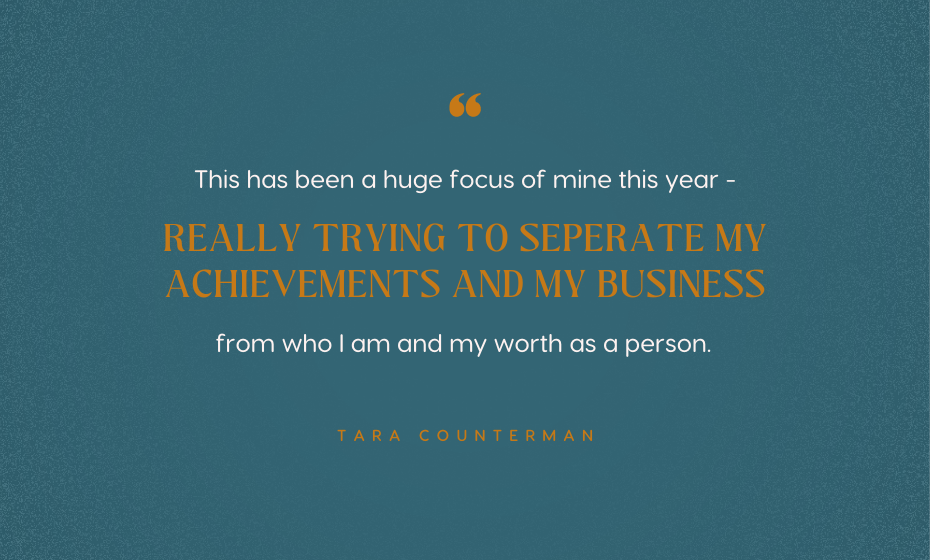
As I previously mentioned, everything didn’t start as well-balanced, sustainable, and as joyous as it is now for me. I ignored my body and my mind, to the point it became so severe that my health was declining.
My health—what keeps me upright and able to balance everything I needed to—was falling apart in 2020. I knew that I had to work hard at recognizing patterns in myself, at recognizing where I was giving too much, where I was ignoring and avoiding those “nudges” my body was giving me. I also needed to reflect and assess what I felt good about. What had I done that worked well for me—where could I take it a step further to keep this momentum going.
When 2019 hit, it hit hard for all of us, and everything changed. Everything changed in an instant when it came to running our businesses and balancing our personal lives and relationships. Life as we’d known it, was no longer readily available. I pushed myself hard. Too hard—like many of you. Just. To. Stay. Afloat.
This hustle and grind continued into 2020. I also was working on implementing new systems, new structures, that in the long run I hoped would work for me. The cost at the time though was my health and a bit of my sanity. I knew 2021 had to look different. It had to epitomize “space”. I really began to self-reflect, listen to my intuition, and pull apart those hidden places I’d kept tucked away and had ignored.
The result?
I could step away from my business and not have it all fall apart. My health improved. I created sustainability throughout my personal and business life. A bonus—a little FYI…a $24,000 day sales day—one day! Let that sink in for a moment…I accomplished this by following my nudge. By paying attention to what I’d been ignoring internally.
Creating and implementing a sustainable business model through leveraging, batching, and creating intentional content was what provided me the opportunity to find the space in my life I needed. It worked for me!

LISTEN ON SPOTIFY | LISTEN ON APPLE PODCASTS | LISTEN ON GOOGLE PLAY
Time to get Intuitive: Self Q&A
I want you to take a few moments, whether you choose to reflect on these just in your mind, or jot them down on paper—a journal perhaps—and dig deep to ask yourself…
1. When you reflect on 2021, what do you feel good about? What have you done or changed in your life or business that has brought you a lot of joy? What has worked right for you?
Time to turn the tables. In 2021, what didn’t work well for you this year in either your personal life or your business? Where are you feeling off-balance? Where are you feeling an overwhelming sense of pressure?
2. Where are you really feeling pulled to change, to adapt, to adjust (grow) in your life in 2021? Where has that little voice in your head, or that gut intuition, told you to listen and follow?
3. Where are you putting in your time? How much time? What does it feel like? What is the cost of your time and the benefits?
Time to Tune In and Tune Up: The Bottomline
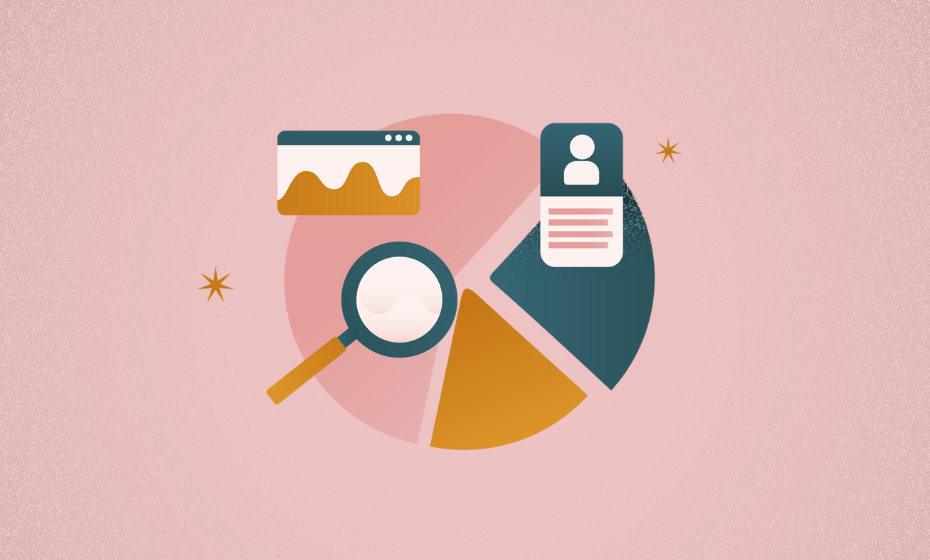
When we ask ourselves these questions, it creates an opportunity to assess where we may be putting too much of ourselves. If we are self-aware, if we reflect, we may be able to see a bit more clearly where we’re out of balance. Where does correction need to be made? How can you serve and support your clients, in innovative ways?
If we don’t take the time to listen to our bodies, to listen to what is drawing us into these areas we want to keep hidden, or ignore, it can send us into a downward spiral, and quickly. If we don’t access and create a proper alignment across the forefront of our lives, the pieces will quickly fall apart, and we will feel immobile in every aspect of our lives. We will deteriorate.
This will often look like a review of the “what worked well” and “what didn’t work well” of previous years, or months, if you want to break it down into smaller windows of time. Start to look at and plan next year. Digging even deeper—monitor where you are spending your time. What are you prioritizing with your limited time? Ask yourself what it is taking away from you and what is benefiting from where and how you’re spending your time. How is your investment of time being used, and is it being used well?
Where does your focus need to be to cultivate, create, and align your goals to get you to a place where you can joyfully wrap up in spaciousness?
This self-reflection and self-assessment can create a revitalized sense of balance and purpose. Podcasting really can be a platform to create intentional content, to create more ease and alignment in your business and in your life where you are fully supported within your role. Listen to your body.
Let’s tune in and tune up our lives! Let’s not create the definition of insanity for ourselves. Let’s reflect and create a sustainable business model.
Be inspired, confident, powerful, and innovative in 2022 to do things your way!
You are worthy!
And don’t forget to pre-enroll for EMPWRED to leverage the PWR of podcasting to profit & innovate in your business…your way!
CONNECT WITH TARA:
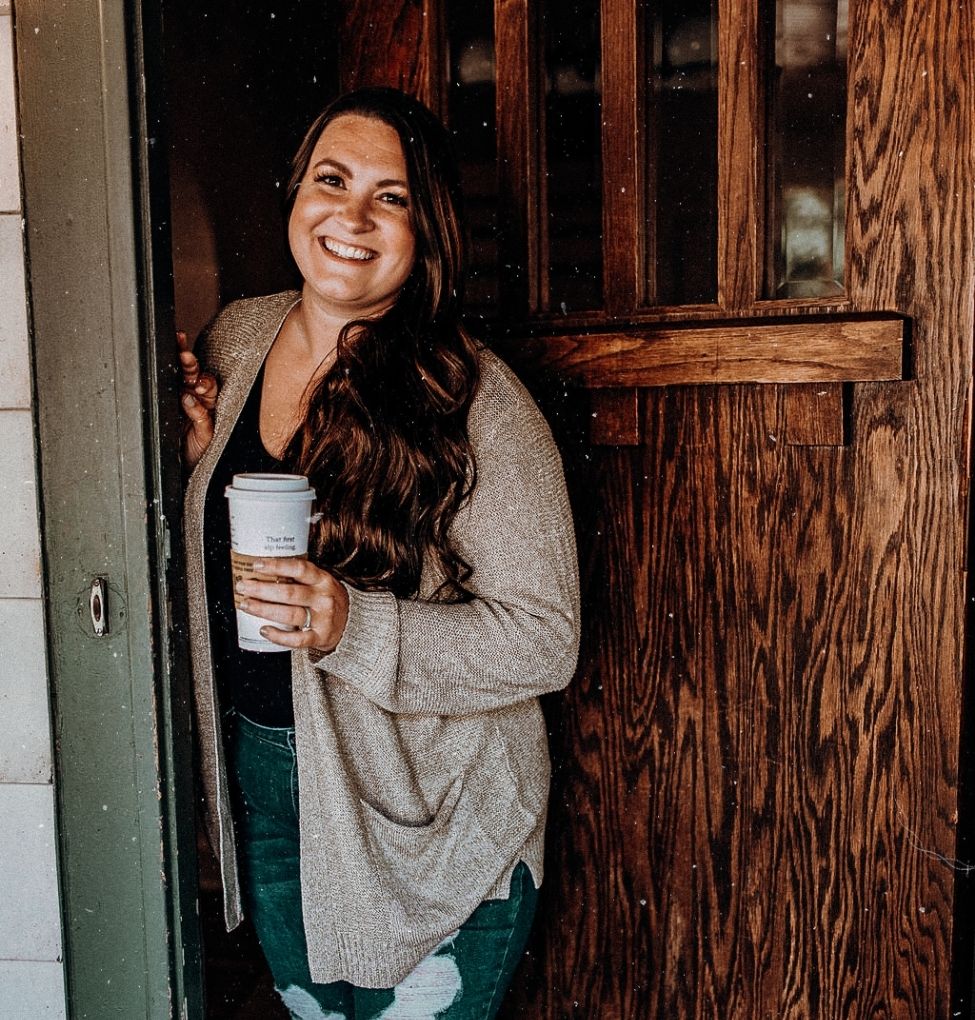
In this post, I’m joined by social media ad extraordinaire Daniela Justus. Daniela owns an ad agency that CEO PWR is lucky enough to work with. She and I had the chance to talk about all things social media ad related and we also touched on evergreen sales. All super useful stuff! I share a lot of insight that she relayed here.
Daniela’s Business and Approach

Daniela runs a Facebook and Instagram ad agency that offers comprehensive marketing agency strategies to their clients. As a boutique agency, they make a big impact with their clients – including with us!
Daniela shared that she helps her clients to create automated systems that run in the background, consistently bringing aligned leads to your business and keeping that engine running. This brings in a steady flow of people to sell to organically.
In order for the ad machine to work correctly, Daniela helps her clients figure out how their ideal clients want to be served. Ads rely completely upon around how companies cater to how their ideal client consumes and retains information, so that’s a major focus for this agency.
Daniela and her team also help clients brainstorm in order to figure out their exact strategy from a collaborative point of view. She’s always sure to ask clients all the different options for getting in front of their audience and she helps take a holistic look at the different avenues available, even outside of Facebook and Instagram.
Social media is a fantastic place to make connections. But, Daniela prompts her clients to consider how they will take their audience off of that platform and onto the next step with their business. She has an approach that focuses on nurturing the community in order to open the door to a profitable relationship.
A Customized Fit for Each Client
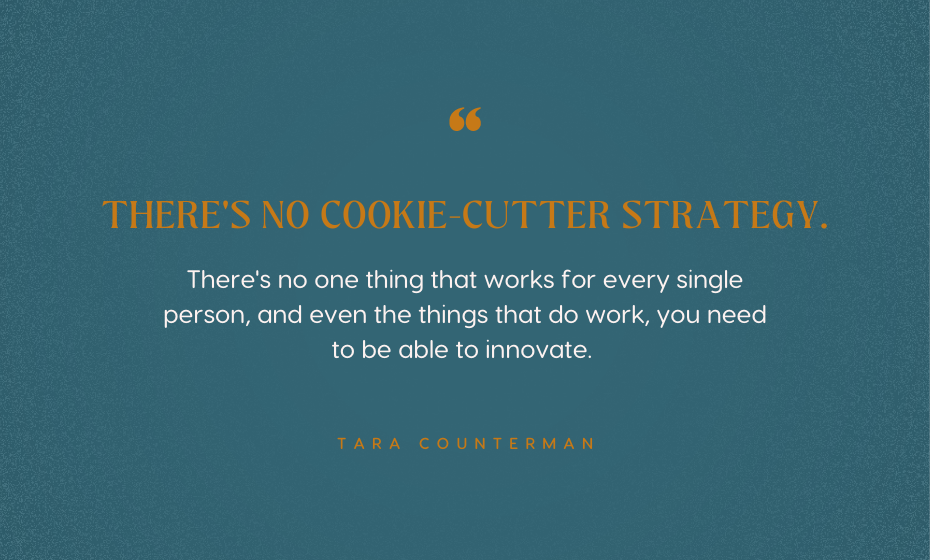
Daniela and I also got into how she tailors her approach for each individual client. There is NO one-size-fits-all approach!
Having awareness around your community and being in tune with their wants and needs is key when it comes to running successful ads. Daniela is there to help her clients tap into what these clients are looking and asking for, ensuring that she’s not just applying a blanket solution that won’t work for every business.
The data of ads is another focus that Daniela and her team have. The fact is that the data tells us SO much, it’s really a guide to the behaviors of our clients. How crazy is that?!
Once you tap into that data and what it’s saying, you can make changes to meet audience needs and to keep up with the times. Your strategy will evolve over time, and having a team like Daniela’s to facilitate that and support you along the way will help you scale successfully.
Evergreen Sales & Ad Misconceptions
There are a lot of misconceptions out there about evergreen sales and ads in general. Here are a few that Daniela shared with me throughout our conversation:
- People tend to get discouraged when their launch doesn’t work. That leads to them changing the entire thing rather than zeroing in on what they need to tweak and going from there.
- People don’t understand the need for tracking data or the value in it. This data has lots of insights. Treat these numbers like useful feedback that serves as a parameter for creation going forward!
- Ads won’t solve your business’ problems – they’ll only amplify what’s actually going on.
- Remember that EVERYTHING ads-related needs to be catered to your objective!

LISTEN ON SPOTIFY | LISTEN ON APPLE PODCASTS | LISTEN ON GOOGLE PLAY
Are You Ready to Work with an Ad Agency?
So here’s the big question you likely have on your mind: Are you ready to enlist in the services of Daniela or someone similar?
Daniela answered that question for us. Here are some things to consider in deciphering if working with an ad agency is right for you right now:
- You should be making consistent revenue to work with an ad agency.
- You need an offer that’s scalable to gain the most from these services.
- You shouldn’t enlist in ads just to grow a list.
You want to enlist in the services of an ad agency that shares your foundational values, so that’s something else to consider if you ARE ready to begin a business relationship surrounding ads.
Make It Routine & Fun: The Bottom Line
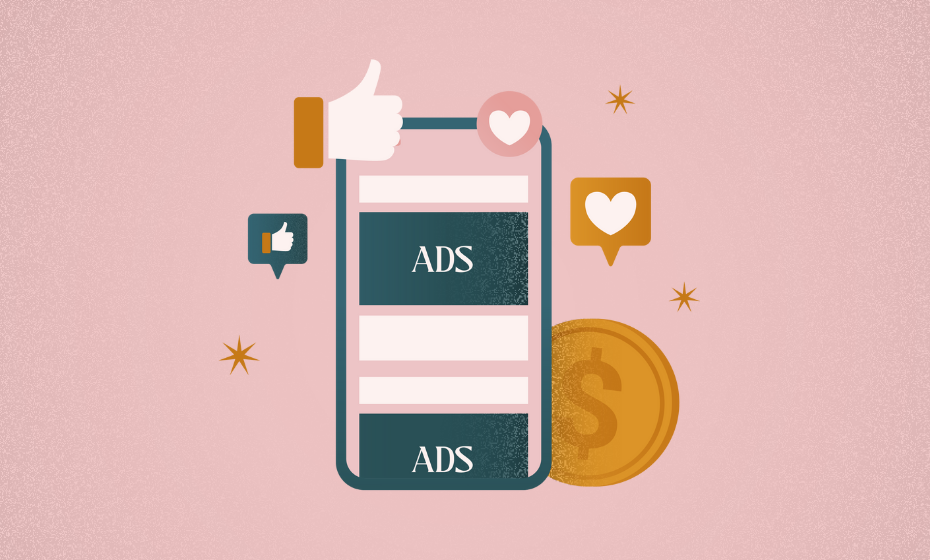
There’s no one strategy that is the winning ticket for all companies with ads. Daniela has a great perspective of the fact that every company is different, so every company has different needs in this department. Finding what will work for you and running with it consistently is key, and Daniela and her team are the perfect people to help you discover, build, and implement whatever that is for your business.
Be sure to connect with me more over on Instagram, I’d love to hear what you thought of this post and what your major takeaways were.
See you back here in the next one!
CONNECT WITH TARA:
CONNECT WITH DANIELA:
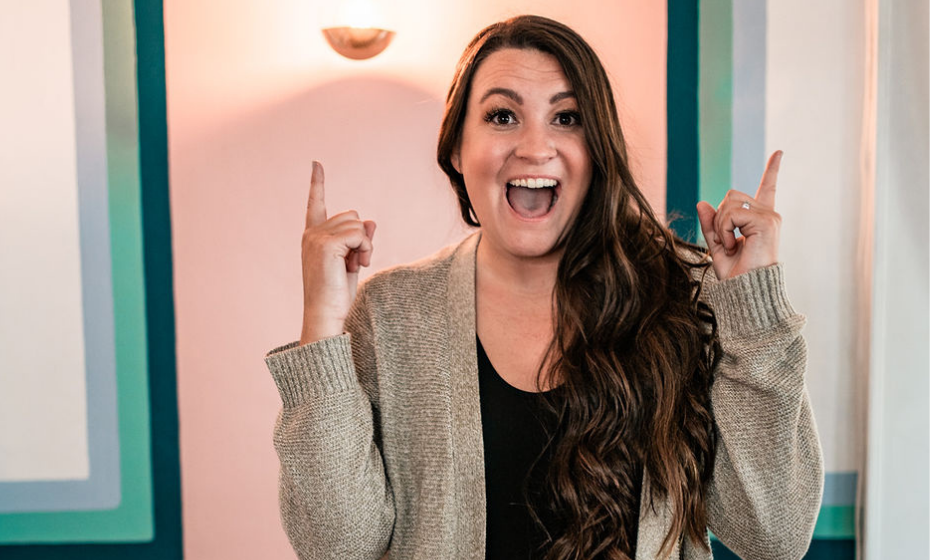
In this post, I’m joined by course creation expert Ariel Schiffer to talk all about the benefits of course creation and working with her company Dreampro. I’ve been so lucky to work with Ariel and her team for the past two years in creating a wealth of courses for my company.
Today, I’m excited to share with you what she and I discussed so that you can learn more about the idea of course creation and help decipher whether it’s something you may want to explore further for your business.
Helping People Create Courses that Generate Results

Let’s learn some more about Ariel and her company Dreampro. They turn people’s brain dumps into million dollar programs. I know from experience just how much time, energy, and frustration can be saved by working with Dreampro.
They have the experience and knowledge to understand that courses aren’t meant to be informational. People can find information anywhere. Instead, people taking courses are looking to get to their transformation via the path of least resistance. They want a piece of your knowledge and to learn the lessons you’re teaching.
Dreampro helps people create implementable programs that generate real results. They work with their clients to gain an understanding of what testimonials they want to receive from their courses and how they want people to feel when they open the course in the first place. They know how to make people feel like they belong in your program and that they’ll improve the way they yearn to, granting them the results at the end of the course that you intend for your audience.
Making Learning Fun
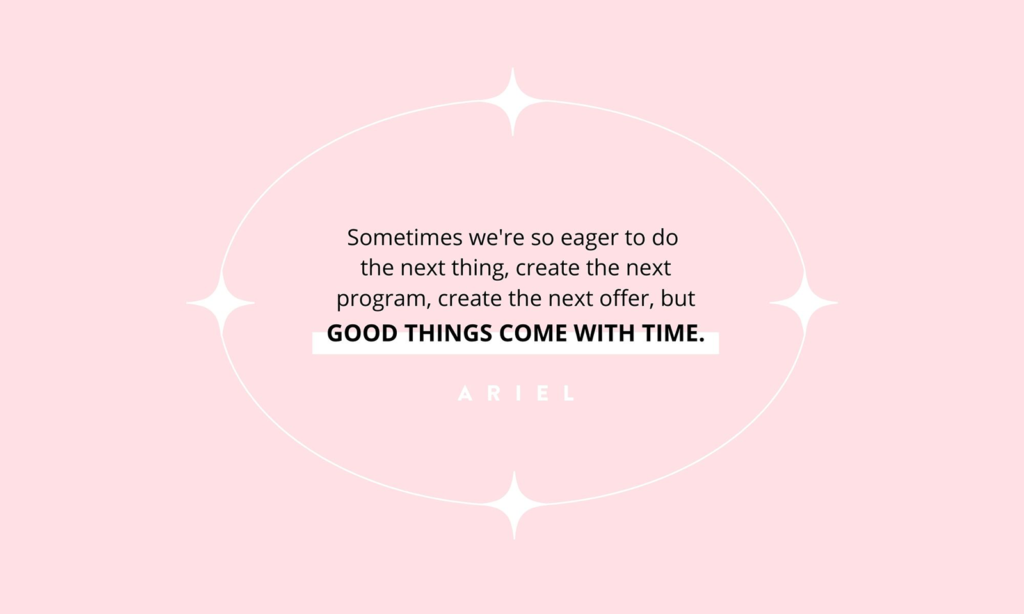
Ariel and Dreampro have their finger on the pulse of the learning industry and where it’s headed in 2022. During our conversation, Ariel explained that something she anticipates is that people will be looking for courses that make learning fun. People naturally want to have a good time and yearn to find a way to stay engaged.
Ariel further explained that there are so many forces that work against the ideal end result of your course. For instance, people have other priorities that they need to focus on or they are also battling the general and natural discomfort that comes along with learning. Ariel helps people examine and implement how you can get people to stick it out in the course. A lot of this revolves around making it fun.
You need to use your course to set the pace for the culture of the community you’re fostering. Most importantly, Dreampro helps you look at your content and lessons and decides how you can make things interesting. From there, they put those ideas to work in making something that’s educational AND engaging.
Trusting Your Gut in Course Creation
Ariel really emphasized the importance of trusting your gut during course creation (and in your business in general). It’s SO important to understand that good things come with time. If you feel like something’s off or you’re not 100% ready to launch your course, listen to that feeling.
Dreampro will always help you understand if your course is representing you and your feelings, values, and messages. They’ll make sure they’re properly communicating those items in your courses, granting you the final say in your course but helping bring your vision to life along the way. Everything they’re helping you do and create is backed by their learning principles, which is what makes these courses so powerful.

LISTEN ON SPOTIFY | LISTEN ON APPLE PODCASTS | LISTEN ON GOOGLE PLAY
How Course Creation Benefits Podcasters
There are so many reasons that course creation can be of benefit to podcasters. First, having a course can diversify your income and become a staple of your brand via what it teaches. Courses also bring credibility to your podcast and your brand.
Having a course is also a great way to allow a listener to take the next step in their relationship with you and your business at a lower price point than some of the other things you’re offering. In short, it’s a long-term way to nurture that relationship with individual audience members.
Ariel emphasized that there are no rules in this multi-billion dollar industry. That’s the beauty of it! You get to decide what you’re offering and your price points. While some people worry they’ve missed the boat on this industry, there’s still so much to get in on and Ariel encourages everyone to do just that.
Giving People the Tools to Learn: The Bottom Line

You can give people courses and trust them to be self-driven enough to complete them, not having to micro-manage them along the way. Working with Dreampro to create a course allows you to give people what they need to learn and they can do what they want with it. This way, you don’t need to continuously train on the same thing – your course does that for you!
I hope this post has inspired you to examine what courses you could offer to your audience and how Dreampro can help you build them in a way that provides you with a new and amazing income stream!
Be sure to connect with me more over on Instagram, I’d love to hear what you thought of this post and what your major takeaways were.
See you back here in the next one!
CONNECT WITH TARA:
CONNECT WITH ARIEL:

In this post, I’m talking about my experience working with SEO expert Lauren Taylar. I’ve been so lucky to connect with someone who truly knows the ins and outs of SEO, and it’s had a huge impact on my business. And want to know the best thing? It can do the same for you! Keep reading to learn more about the importance of SEO and all the ways it impacts your business.
Lauren Taylar: SEO Expert
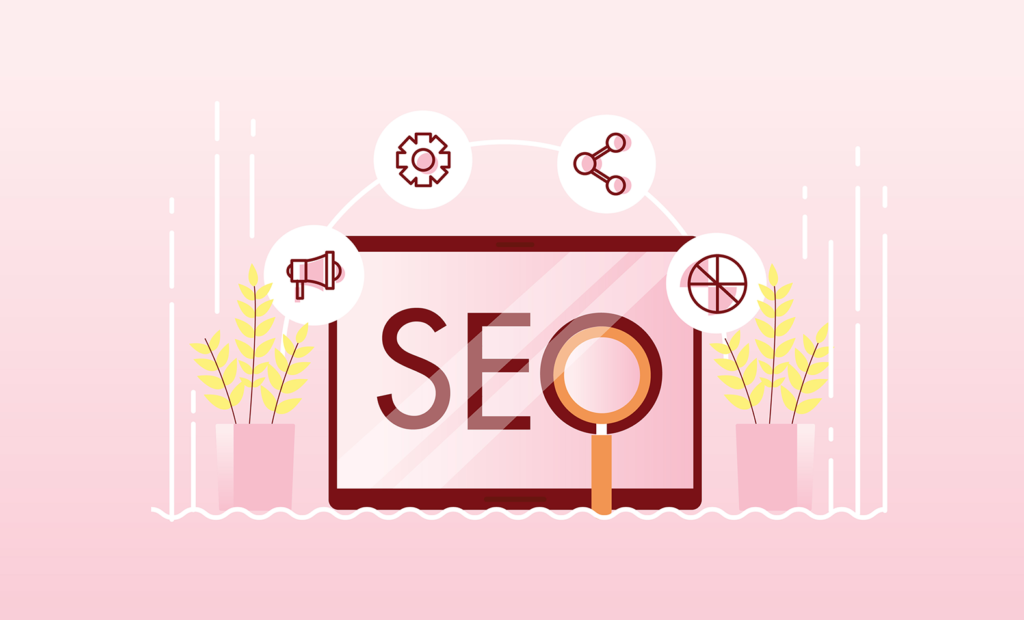
I want to share a bit about Lauren as an SEO expert. She specializes in brand design, Square Space and web design, and SEO strategy. She’s been doing this full time for two years, and before that it was her side hustle. She loves sharing what she’s learned with small business owners in a way that will actually make sense to them. While SEO can seem like an intimidating and confusing topic, it doesn’t HAVE to be that way. And she’s here to prove that to YOU!
The Benefits of Focusing on SEO
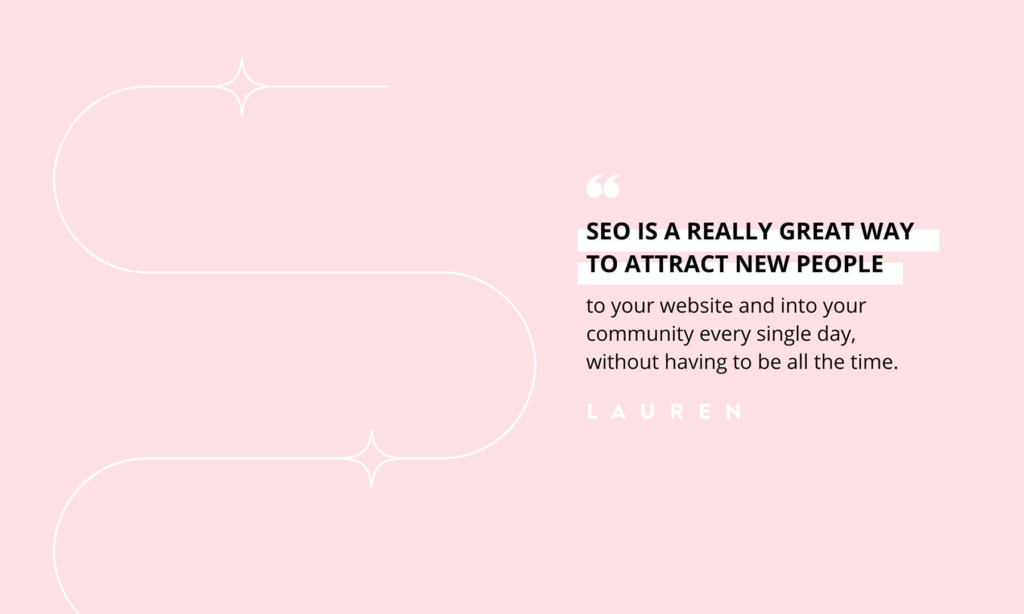
There are so many benefits associated with a focus on SEO that you may not be aware of. To really reap the benefits that Lauren shares, you’ll need to have a website or a blog – somewhere that your audience can go to that you own. This should be something outside of your social media platforms. While those are a great tool for engaging with customers and reaching more people, they don’t have full SEO the way a website or blog does.
Thus, a website or blog is a great way to get your content out there. SEO makes your content on a blog more evergreen. That means that it will attract more customers over time without you having to do a thing once it’s out there! How cool is that? The idea of attracting more people to your business without having to be on all the time is pretty awesome if you ask me.
So, showing up on places other than your social media platforms can help you gain traction making sales using a more passive method. It also is a great way for you to figure out how you can repurpose your social media content on your blog. We call that working SMARTER, not HARDER, ladies and gentlemen.
It’s also really simple to take a podcast episode and turn it into a blog post. Transcribe the content you have spoken, clean it up a bit, be strategic and thoughtful in the way you present it – and – just like that, you have content you can easily optimize to be found by potential customers over and over again (hint: CEO PWR can do all this work for you!).
Are People Still Reading Blogs?
All of this talk about blogs may have you wondering, are people even still reading blogs? I thought they were so 2010. Well, that’s something Lauren and I discussed.
Lauren explained that no matter what form of content you’re using – video, audio, or written – there will be people that prefer each one of those methods. You need to think about how people want to consume content and be inclusive of all types. It’s ALWAYS good to have your content in different forms so that you’re not inevitably alienating people who prefer one type over the other.
With that being said, blogging is definitely NOT a dead marketing strategy. In fact, it’s a really smart one! Turning show notes from a podcast episode into a blog post helps that site turn up in the first page of Google search results. Having simple show notes – which are thin content at usually only a few hundred words – are not likely to rank highly in a search. However, a full blog post that’s strategic and that is more than a transcription is much more likely to reach people and to be something that individuals engage with more.

LISTEN ON SPOTIFY | LISTEN ON APPLE PODCASTS | LISTEN ON GOOGLE PLAY
Common Blog Post Mistakes
Lauren shared some common blog post mistakes that she’s seen time and time again. The first is to not include headings and make your content look like one long essay. That’s not something that people WANT to read from an aesthetic standpoint, which makes headings so important.
Next, not having a call to action anywhere in a blog post is a huge mistake. You always want people to understand what the next step is after they read the post. It’s so important to have a call to action at the bottom of your post especially, giving people the next place to go to make a purchase or continue engaging with your business.
General SEO Website Tips
Lauren also shared some more tips on how to optimize your website for SEO. One that frequently goes uncaught is to optimize images correctly. It’s important to not have huge image files on your site, as they slow down site load time. Make sure to resize these to keep load time three seconds or less to avoid losing customers before they even have a chance to see all the great stuff your site has to offer!
Behind the Scenes of Lauren’s SEO Strategy
Lauren gave us a peek behind the curtain of her own SEO strategy, which is way cool and super useful. She always starts with keyword research, which is where she formulates the titles of her blog posts. This tells her what people are Googling, so she knows exactly what to write about.
From there, she writes her content without really thinking about the SEO behind it. She aims for her posts to have at least one thousand words. During the editing process, she goes in and adds the keywords again so that it occurs about four times per thousand words. When you’re doing this, read sentences aloud to ensure where you’re adding the keywords in sounds natural to the reader.
From there, she takes care of her formatting with headings and makes sure that the keywords are present in the URL. Then she writes her meta description and her post is ready to go!
Lauren recommends posting once every other week if not once a week. She explained that when you first start writing and posting and writing, it may seem heavy. At that point, it’s important to do it at least a couple times a month. But once you gain momentum, writing will come more naturally and you’ll nail down your process, so you’ll start doing it on a more regular basis.
While Lauren is an expert and this is like second nature for her, it can be the same for you once you gain an understanding of SEO the way that she teaches it to small business owners.
Keyword Strategy Tips
Understanding keywords and your strategy around them is a bit tricky at first. Lauren shared that you don’t really want to write for the same keywords more than once. However, you can use the same “root” of the keywords you’ve already written about while adding a different tail onto them to differentiate them.
It’s not uncommon for people to worry about what they’ll do when they run out of ideas of what to write about. While Lauren noted that there’s so much more to write about than people think, she also shared the clever idea of building an “ultimate post” with three to four thousand words about a topic. From there, you can link out to shorter, related blog posts. Not only does this help you generate micro topic ideas, but it also helps with SEO because you’re adding internal links to your site.
Learning SEO the Right Way: The Bottom Line
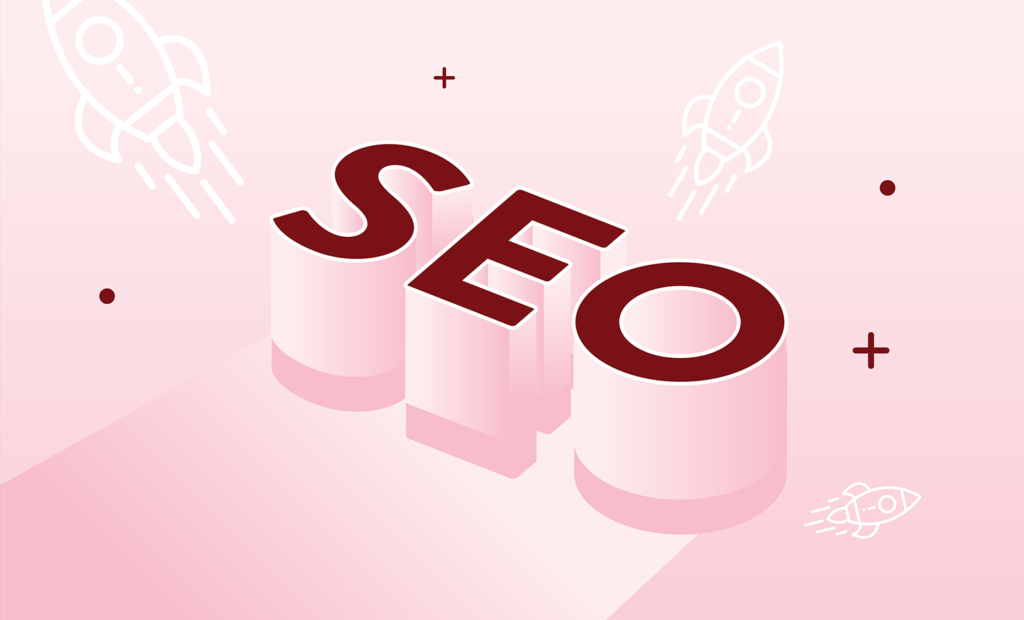
There are so many SEO teaching programs out there, but it’s so important to learn this the right way for your business. Learning how to write both for great SEO and in a way that appeals to readers, how to make your site authoritative, and how to gain quality backlinks are just some of the things that can make a world of difference for your business. They’re also just some of the things that Lauren can teach you!
I hope this post has inspired you to enlist in Lauren’s help for your site’s SEO or to learn more about the topic. She’s truly an amazing resources that can impact your business in amazing ways.
And don’t forget to sign up today for the SEO Strategy webinar to learn how to Monetize Your Website into a client-generating machine!
CONNECT WITH TARA:
CONNECT WITH LAUREN:
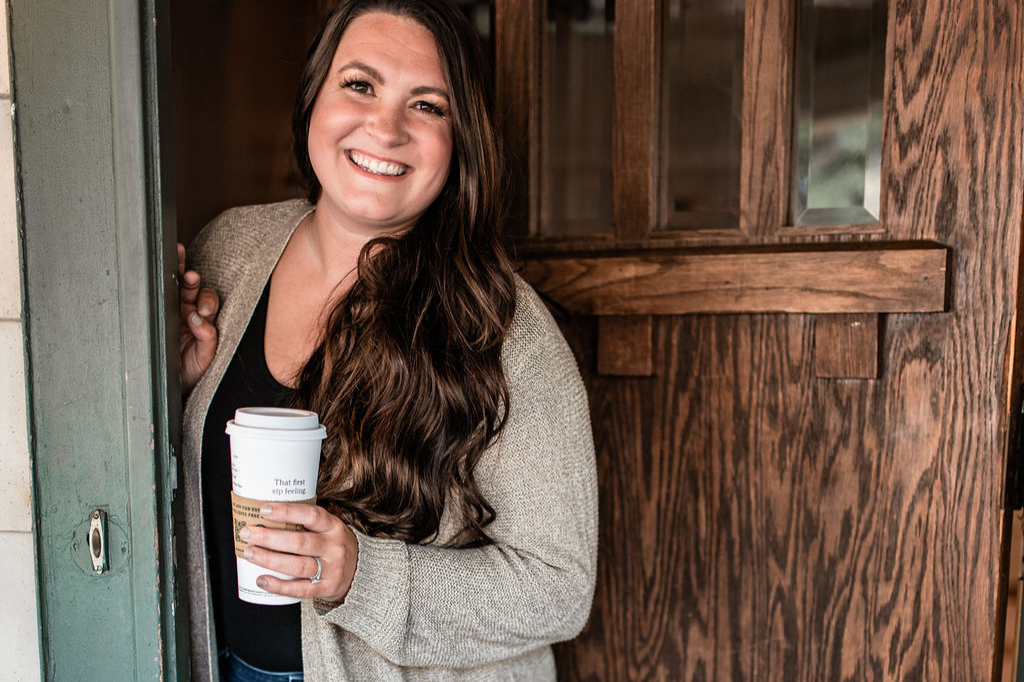
In this post, I’m sharing the details of my conversation with expert copywriter Megan Taylor. We’re starting off the Embrace Your CEO PWR series by talking all about the importance of strong copy. Since this is something we’re absolutely bombarded by on the internet, it’s vital to find a way to make your copy stand out and resonate with the right audience.
Megan shares so much amazing insight into why copy is important, how to know if you’re ready to hire a copywriter, and what the in-between steps are if adding a copywriter for your team isn’t quite right for you right now.
The Importance of Copy

Copy is important for several reasons, and Megan shares her expertise on why it’s something that’s worth focusing on if you’re a business owner. Copy is defined as the words you use to promote your business. While a beautiful graphic can catch someone’s eye or a podcast can capture their attention, copy is what grabs them in between those other pieces of content.
For copy, it’s so important to understand the audience and use words that will drive a connection between you and them. That requires you to get clear on messaging and how you’ll communicate with people. Having that written communication allows you to reach a broader audience with fewer resources than if you needed to do a sales call with every potential client, which is a huge plus.
A great copywriter is more than someone who puts pen to paper. They’re a coach who gets into the nitty gritty of what’s so impactful about your business. This person acts as a cheerleader. And it’s a common misconception that they have to be an expert on what you do.
It’s more important for them to understand your specific knowledge of the industry and the way you convey it. The fact that they do this and that they act like a cheerleader for your company is exactly why it’s so important for business owners themselves to figure out writing their own copy. A business owner is their own biggest cheerleader, and there’s the ability for that to transfer well into copy.
How to Decipher if You Need a Copywriter
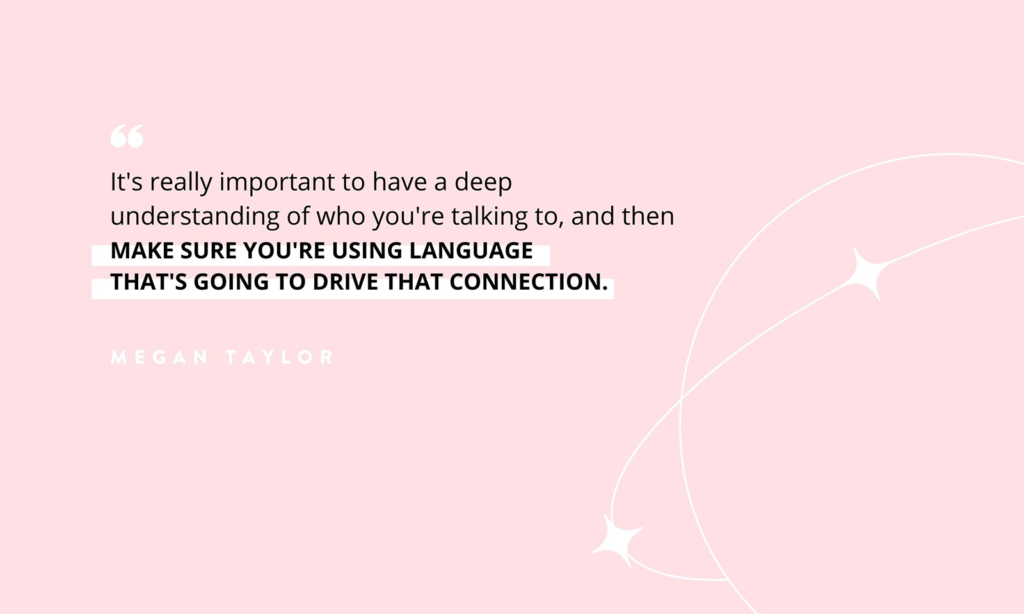
So, you may be wondering how you can figure out if you need to hire a copywriter for your business. Megan explained that if you’re not clear on your business’ messaging, it’s simply not the time to hire one. Megan works with her clients and potential clients to figure this out. She provides them with a questionnaire to gain a sense of where they’re at with messaging.
If there’s no clarity or vision surrounding your company’s messaging, that needs to be worked through before you hire a copywriter. When we’re passionate about business, it can put a lot of pressure on us to get that messaging right. For that reason, Megan helps her potential clients zero in on their messaging with a journal that really digs into what they’re looking to say.
Remember that this is YOUR business. The beauty of that is that you get to decide who your client and who your reader is. You need to do something that lights you up! Once you realize that, deciphering your messaging will be easier.
These links are affiliate links – we would only recommend something that we use & love. We may make a commission if you purchase through these links at no additional cost to you.
Copywriting Resources
If you recognize that your messaging is not clear enough yet to merit the need for a copywriter, you can use some of Megan’s resources for this stage of your copy. These include:
- Copy VIP Days – Have Megan expertly craft your perfect copy here
- Copy Templates – View her Black Friday Copy Template Shop | View her Copy Template Shop
- Copy Courses – View Megan’s Website in a Week Program Here
Megan’s templates are WAY more than a fill-in-the-blank sheet. This is because she wants the person using the template to understand why they’re writing what they are. These specialized templates were created by her for different content needs. She knows the narrative that a template needs to tell and understands the importance of the why and not just the how.
The very intentional structure of these templates provides understanding and options for what works for each person. One of the great things about these templates is their personalized nature and the fact that they come with a helpful video training and workbook.

LISTEN ON SPOTIFY | LISTEN ON APPLE PODCASTS | LISTEN ON GOOGLE PLAY
Consistent Messaging
When you’re a business owner, you need to realize that you’re a copywriter by default. Whether you’re writing emails, webpage content, social media captions, or something else – that’s all copy! Across all these pieces of copy, it’s important to keep your messaging consistent. Not doing so causes a lack of trust and can harm sales.
Good, consistent copy can be leveraged from one sort of content to another – for instance, a website page being turned into a social media post. With no consistency, you’ll have no idea if you’re putting forth the right message for your audience. It’s vital to eliminate any disconnect in consistency through the messaging and tone that you use. That doesn’t mean you have to change yourself. It just means that you need to keep the message the same across all platforms and in both writing and when you speak.
Adding Personality to Your Copy
As you begin adding your own personality and tone to your copy, take baby steps in doing so. For instance, try adding more of your own flair into your social media captions. Push yourself a little bit at a time and tiptoe gently out of your comfort zone.
You’ll soon realize that the more you do this, the more of your messaging resonates with the RIGHT people for you and your business.
You are The Magic of Your Brand: The Bottom Line

You bring your own level of expertise and energy to the work that you do. Your copy gives people a taste and preview of all that goodness. With that, you hook the right people and bring them in on what you have to offer.
I hope this post inspires you to remember that when you try to talk to everyone, you talk to no one. I also hope Megan has conveyed that you don’t want to put yourself in a box with your copy that you don’t want to be in and that you should strive to be authentic and confident in your copy above all.
Be sure to connect with me more over on Instagram, I’d love to hear what you thought of this post and what your major takeaways were.
See you back here in the next one!
CONNECT WITH TARA:
CONNECT WITH MEGAN:
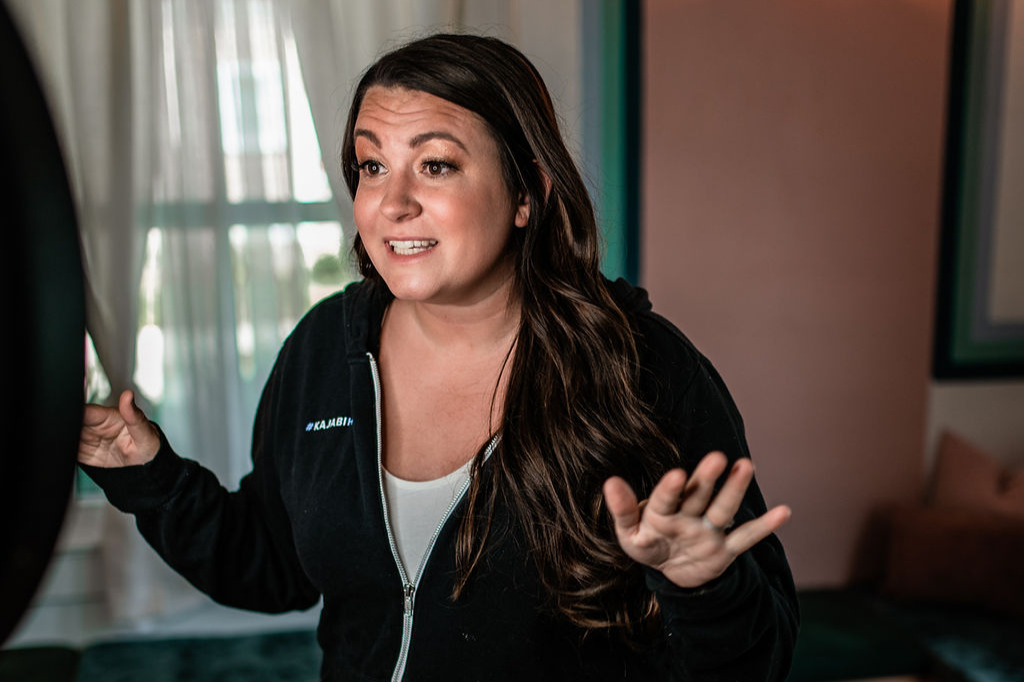
In this post, I’m getting into competition for your business in a different form than you’ve ever heard it before. It’s easy to get caught up in thinking our only competitors are other business owners in our niche, but it’s important to have an understanding of who you’re really up against in the online space.
Gaining this insight will launch you into further business success and can inspire you to use the information your competition has to your advantage. I’m delving into these ideas and more below.
Who We Think Our Competition Is

I believe in collaboration over competition. And I’m a firm believer that when you can effectively communicate your message in a way that your ideal client can feel and experience, you won’t even need to compete with others. This is because the people you’re meant to work with will just find you.
When we hone in on our expertise, we can really lean into that. And that means that you’re not competing with a bunch of broad things because you’re clearly the expert on the topic.
Even so, it’s easy to get caught up in the idea that our competition exists in those in our sector. Those offering similar products or services. Those who have similar missions to us and who are seeking similar clients.
But I truly believe that this isn’t the case. Continue reading to learn who our biggest competitors really are.
Who Our Competition ACTUALLY Is
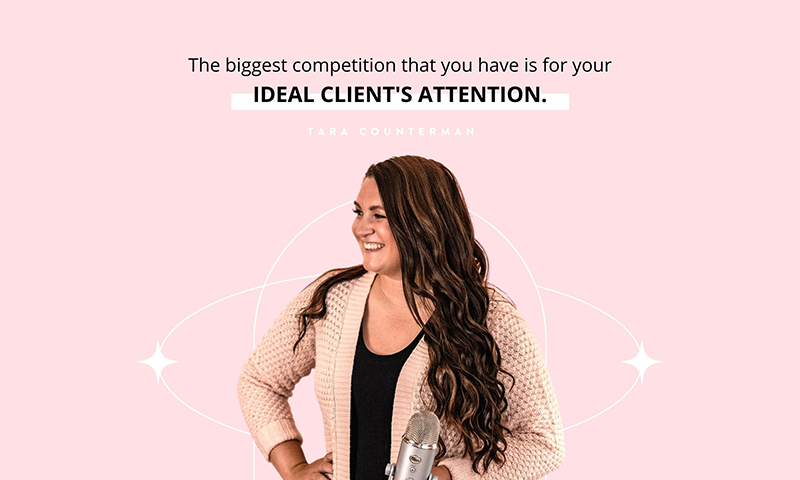
Instead of our biggest competition being someone else with a podcast or business that offers services similar to ours, it’s actually someone else entirely. Are you ready for this? Because the realization just may blow your mind…
Our biggest competition exists in the companies who spend a lot of money making sure that they’re grabbing the attention of your ideal clients. I’m talking about those apps that keep us reaching for our phones, keep us scrolling. Social platforms like Facebook and Instagram are some of the companies I’m referencing here.
And it’s important to realize that when something is free, you are the product. Wow- that’s pretty crazy to think, right? But it’s true. Free social apps are looking to grab your attention. The longer you spend on social, the more they can see what you’re interested in. They want to keep you engaged on the platform for as long as possible because you’re continuing to provide them with data that they can sell.
Unfortunately, that’s how they’re making money. From the information they’re attaining from users like you.
But the good news is, if they’re getting that information from you, they’re also getting it from your ideal clients. And that’s where we can put this information to use.
In short, your competition exists in these big companies because they make it so that you need to fight to capture the short attention span of your target consumer.
In a world of notifications, likes, live streams, and never-ending content – we need to keep the attention of our followers and be super engaged with them, or else we’ll lose them to the million other things going on on their smartphone.

LISTEN ON SPOTIFY | LISTEN ON APPLE PODCASTS | LISTEN ON GOOGLE PLAY
How to Bypass These Big Companies
We need to figure out how to bypass these big companies in order to capture the attention of our ideal customers. Something I love about podcasting is that it allows your listener to do other things while they tune in.
To listen to a podcast, your target audience doesn’t have to be sitting in front of their phone. They can be walking, taking a shower, driving, and so on. They can be doing things that help them feel productive while they’re simultaneously learning from you.
Take someone who likes to walk, for instance. They can be getting their steps in with your podcast playing on their headphones. For them, it will feel like they’re right next to you having a conversation.
This dialogue is powerful because it bypasses the distractions they have on their phone. Plus, it allows them to listen while you get their mind going, prompting internal questions. That’s really powerful stuff, and it’s huge in capturing the attention of your audience.
Leveraging Your Competition: The Bottomline

As I mentioned, these big companies that spend the big bucks to learn what makes their consumers tick are our biggest competitors. But I’m going to let you in on a secret: we can leverage what we know about them to our advantage.
That’s because we can learn from these platforms. We know how they operate, and we can utilize them to see how our ideal clients interact with content.
It’s as simple as that! Understanding how we can use our competition to our advantage is huge, and it’s bound to help us grow our business in a positive way AND in a smart way.
I hope this post has reframed the way you think about your competition and inspired you to use the big-name platforms to your advantage in a way you hadn’t previously explored.
Be sure to connect with me more over on Instagram, I’d love to hear what you thought of this post and what your major takeaways were.
See you back here in the next one!
CONNECT WITH TARA:
BLOG RESOURCES:
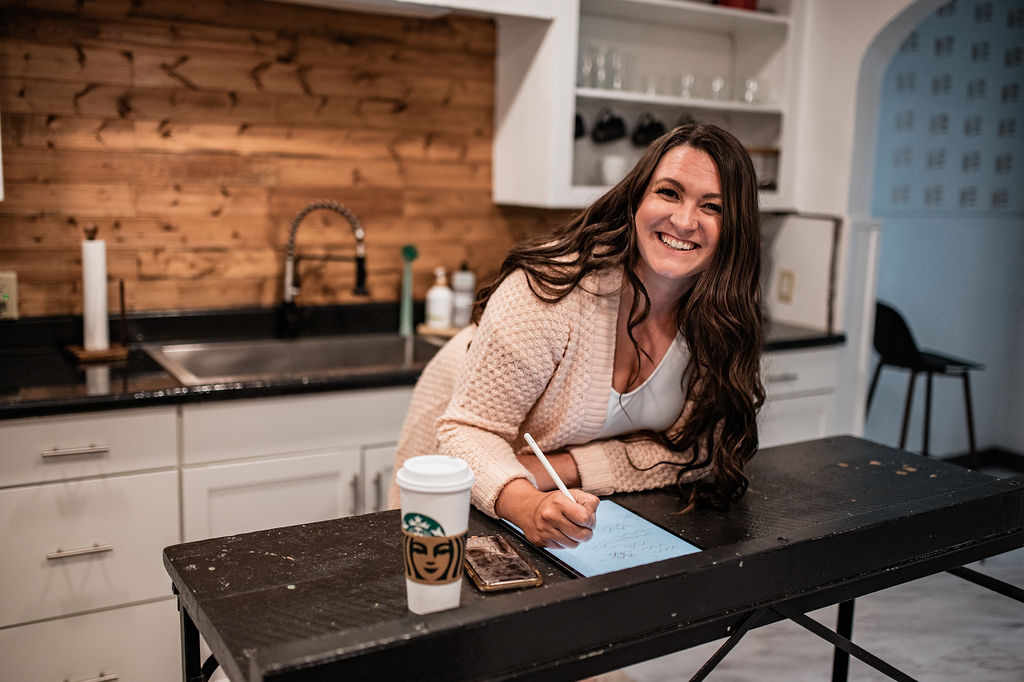
When we put content out there, the hard truth is that it has a pretty short lifecycle. That goes to say that it’s only being viewed by our audience for a short window of time.
And as a busy CEO, that’s a tough realization. Demoralizing, even. This is because you could be putting tons and tons of time into your content, only for it to be viewed for a short period of time. And I get it, that’s frustrating.
But lucky for you, I have a hack that can completely change the lifecycle of how your content is viewed. In this post, I’m sharing how batching content can change the way your content is viewed and how you reach your ideal clients.
If you’re looking to take some of the pressure off of yourself to repeatedly create content from scratch, then keep reading to gain an understanding of how you can work smarter on this aspect of your business.
Turning Macro-Content Into Micro-Content

Focusing on using macro content to generate micro-content can be a game-changer for your business in the best of ways. In so many cases, CEOs are not maximizing the content they’re creating, which is dangerous, because your time needs to be protected.
This issue likely stems from a lack of intentional content. When you’re creating content on the fly – an Instagram post here, a story there, a reel once in a while, and so on – it’s tough to connect all of these pieces to overarching goals. This also leads to inconsistent messaging. Plus, doing things this way means you’re sitting down to create content time and time again, which causes a lot of wasted time.
I like to compare this to the act of baking bread, which is something my daughter and I love doing together. However, in this hobby, we realized that we were spending a lot of time pulling out all the ingredients, measuring them, getting all of our tools out and ready, cleaning up, and putting the dishes and tools away.
But then an idea struck. Whenever we’re making a batch of bread, we take the time to measure out the dry ingredients and stow them away for future use, saving us a lot of time the next time we go to bake.
You can apply this example to a sale. You create on multiple platforms to connect with people. These are the “ingredients”, if you will, that go into a sale. If you need to start from scratch on that content every time, it’s time-consuming. That results in a lot of time being wasted in your preparation and execution.
That’s where the idea of taking macro content – or content that is more long-form – and turning it into micro-content to save you time in the process, and at the same time, convey a more consistent message across the board.
Directing Your Client Through Micro-Content
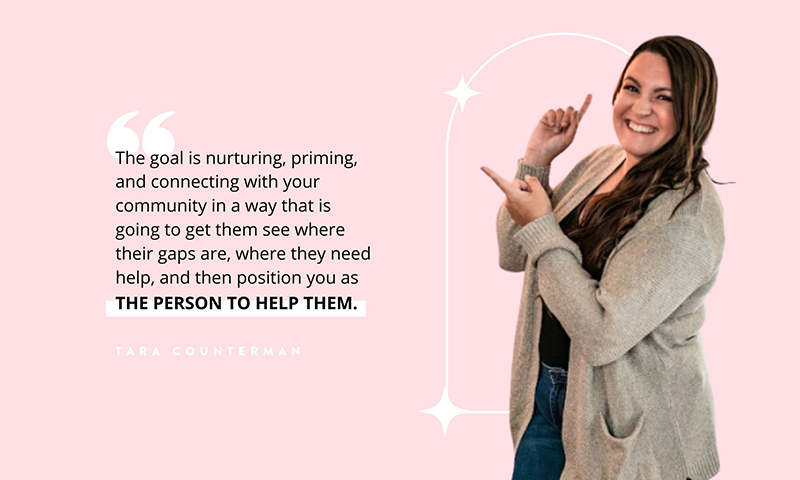
Let’s go back to the bread example. When you have a podcast, you’re baking all of the content into that episode or series of episodes, which allows you to nurture and prime your ideal client. This leads to the sale, connecting you to your community.
But after the “bread” comes out of the oven, you take it to the next step and slice it up. These slices are the other pieces of content you’re putting out there to reach your audience.
While podcasts pull listeners in and reinforce your desired messages, they are also useful in the fact that they can be repurposed into more content. This could come in many forms:
- IGTV posts
- Carousel posts
- Quotes
- Instagram stories
- Blog posts
- And more!
And here’s the great thing about this micro-content. It directs your audience and reaffirms what they believe, as all of these “slices” are a continuation of your consistent messaging. Pretty cool, right?!
What’s even cooler is that this act of repurposing content on different platforms and in different ways allows you to stretch the lifecycle of the content altogether.
Once a podcast episode is recorded, your team can support you by going back to that content and leveraging it even more. That “new”, micro-content redirects your audience to the podcast episode, strengthening the connection.
Your podcast is also something that should be constantly referred to in your micro-content. For example, if you’re doing a mini-training on your Instagram stories, make sure to point to the podcast episode where you expand on those topics more. This can lead to people going to your podcast and binging it from the first episode, which is really powerful from a connection standpoint.

LISTEN ON SPOTIFY | LISTEN ON APPLE PODCASTS | LISTEN ON GOOGLE PLAY
Hacking the Content Lifecycle
As I mentioned at the beginning of this post, the average content lifecycle is a short one. But intentional content hacks this lifecycle and extends it, which is obviously super useful. The key here is that your content has to focus on your goals, which is something I talked more about in my last post.
Because your audience is busy and distracted, something like a Facebook Live will have low viewership, most likely. So you have to wonder, how can we take long-form content and turn it into micro-content? How can we make sure that the content we put out there serves our community and drives them intentionally towards the thing you want them to go towards?
And while sometimes you need to put that content out there that has a naturally shorter lifecycle, it can still be done intentionally and in a much smarter way.
When your podcast or whatever long-form content you’re using is batched, it’s simple to repurpose the intentional content that exists there into those more quick hit items. This can even be done with the help of a team, alleviating a lot of your own time and effort.
Make the Time You’re Putting in Work for You!: The Bottomline

I hope this post has opened your eyes to the idea that you want to figure out where you can repurpose the things you’re doing so that you can be more effective and have more time.
Batching content intentionally so that it revolves around your goals is a huge part of this. From that content, you can use that long lifecycle content (like a podcast episode) to produce short lifecycle content (like social media posts) that matches the consistent messages you are looking to convey to your audience.
This is the simple equation for making the most out of your time and squeezing the most out of your content.
Be sure to connect with me more over on Instagram, I’d love to hear what you thought of this post and what your major takeaways were.
See you back here in the next one!
CONNECT WITH TARA:
BLOG RESOURCES:
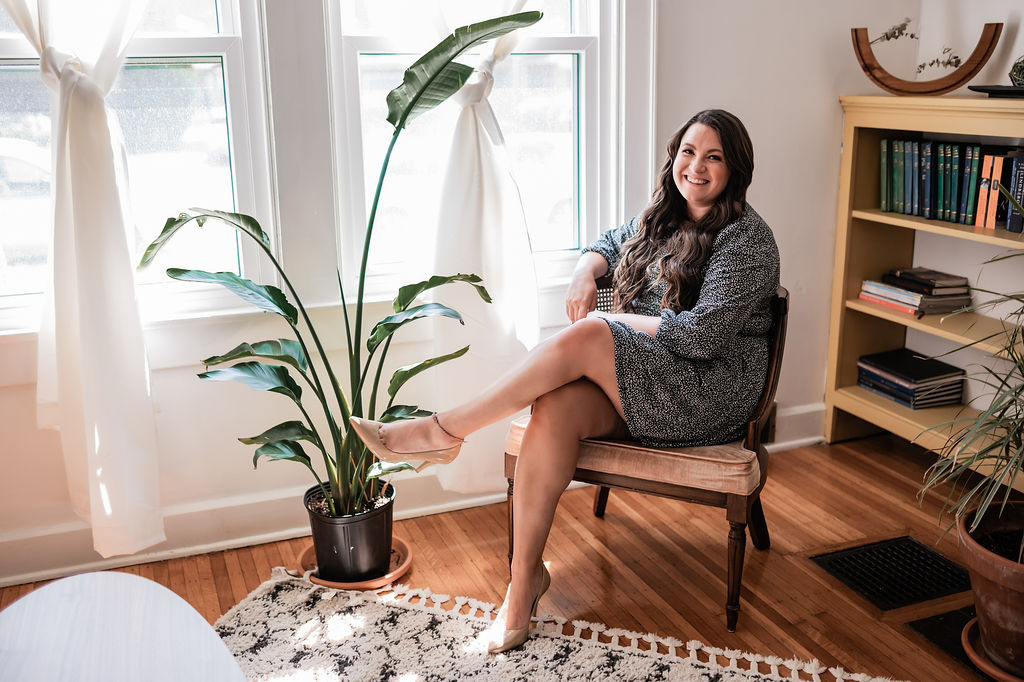
There’s a common misconception out there that planning content is an inauthentic way of getting your desired messages across.
I’m here to tell you how that couldn’t be further from the truth.
The truth is that when life goes differently than you expected it to, you want to ensure you have systems, processes, and a team that you can lean on to ensure your business is running as it should.
In this post, I’ll be breaking down why batching and planning your content – whether it be podcast content, social content, or anything else – is of great benefit to you and your business alike.
If you’re interested in being persuaded on why batching content is the way to meet your goals and keep your sanity while running a business, then keep reading.
Preconceived Notions About Batching and Planning Content

There are several preconceived notions out there about batching and planning content. I’ve heard it all before…
“I’m not a good planner.”
“I can’t batch my content.”
“I’m just not a planner!”
These beliefs business owners hold about themselves can be easily outsmarted, proving that anyone has the capability to batch their content, and their lives will be made better from it!
There’s also a widely held belief that if you’re batching and planning your content, you’re not being authentic.
A lot of clients have told me that they want to wait until inspiration strikes to record their content, because they think it will be better, more authentic, and more relatable.
I’ve learned from experience that this method simply does not work.
While business owners believe that this method of “being in the moment” when creating content will result in something more inspired than content that has been planned and batched, that idea couldn’t be further from the truth.
I’m debunking these myths below so that you can see the value in outsmarting your belief that you’re not a good planner.
How You Can Plan Intentional Content

There’s a super intuitive method to help you batch and plan content in an intentional way without feeling like doing so is too restrictive. This involves sitting down and mapping out dates where your podcast episodes will air. From there, you can figure out what your business plans are, what you’re launching, and what your goals are. This helps you figure out what content you want to put out there.
Looking at your sales plan and examining your goals is the biggest step in creating intentional content. You’ll want to figure out what kinds of content, offers, and information will best support the goals you’re going after.
I get that this sounds like a tall task. But here’s the good news: it doesn’t have to be done all at once. You can figure this out as you go, or take your time fleshing out this step when inspiration strikes.
For myself, I carry a notebook with me practically everywhere I go. When I have ideas or I feel inspired, that’s when I put pen to paper. I don’t force it, and I don’t want you to either. Maybe you’re like me and the ideas flow when you have a chance to disconnect and be in nature. Maybe your ideas come to you after a long workout or before you drift off to sleep.
I’m here to tell you that you can keep a log of this valuable information over time rather than having to sit down and figure out every minute thing in one brainstorming session. You can do this in a way that works for you.
This is all to say that it’s absolutely a false belief that when you’re going to batch, you have to sit down right in the moment and pull all the topics out of thin air at once.
There are also some questions you want to ask yourself when thinking through content ideas. For instance, What does my client need to see, hear, feel, or believe in? How can I give my ideal client what they need in order to empower them to say “yes!” to my business? What testimonials can I share? What stories can I tell to invoke the feelings I want my ideal clients to feel? What’s the foundational information that my clients need to know before they can say yes to what I have to offer?
Once you start using this method of planning content, you’ll soon see that using your goals as your north star will allow you to easily figure out what content can support them. Parsing out content from that starting point is easier than you’d think, and – best of all – you will know that it’s all intentional and feeding into the messaging you want to get across to your clients.

LISTEN ON SPOTIFY | LISTEN ON APPLE PODCASTS | LISTEN ON GOOGLE PLAY
The Benefits of Batching Content
If you’re not convinced yet that batching content is for you, you will be after you learn about the benefits of doing so.
As I briefly mentioned above, batching content and being intentional about what you put out there allows you to ensure you’re conveying the same messages time and time again to your audience.
If you’re not intentional about your content and you record a podcast on the fly, you have no guarantee that what you felt inspired in the moment to talk about goes along with the rest of your goals and messaging. And that means that you’re missing out on the other content that can stem from that episode. When your content is intentional and is in line with your messaging, there’s no limit to how you can leverage that content for your business.
Furthermore, batching content opens you up to a way of having structure without feeling pigeonholed into something. This is because while you have this running list of content topics and ideas, you don’t need to assign dates to when you’ll air each topic. Instead, having this content available means having a very intentional list of ideas that you can use when you’re feeling inspired to do so.
Finally, planning your content can give you the freedom you crave. It gives you abundance, clarity, and less stress. Having that batched content to lean on allows you to avoid doing things at the last minute. This batched content is the key to allowing you to step away but ensure that you’re still making progress towards your goals, which is a really powerful thing.
Are Your Beliefs Around Planning Actually Restricting Your Freedom?: The Bottomline
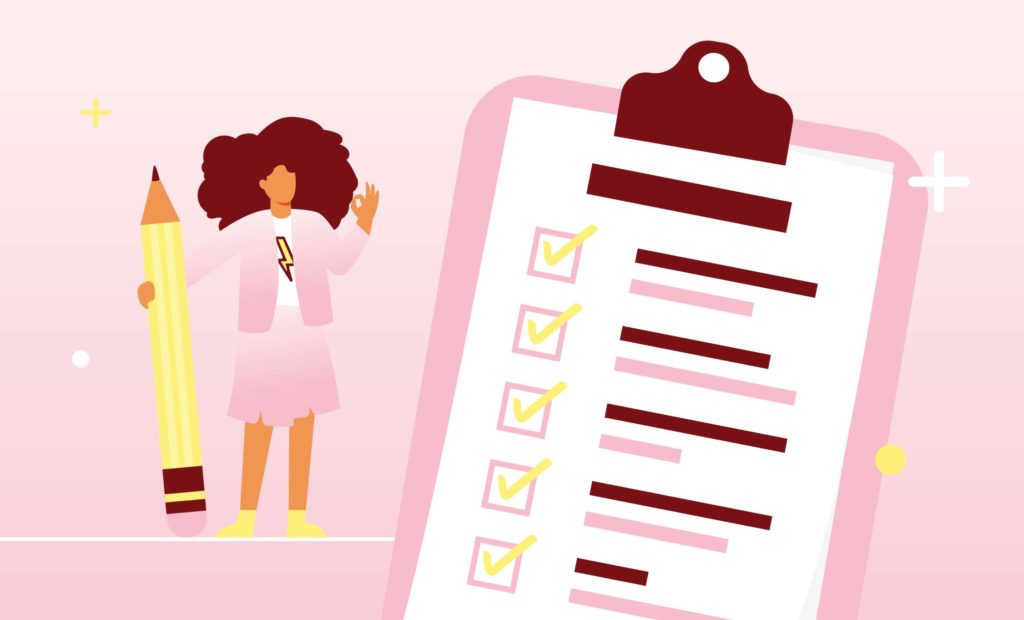
I hope throughout this post you opened yourself up to the idea that batching and planning your content is not limiting but, instead, very expansive for your business and your outreach. Being intentional about your content can provide you with more freedom, enhance your messaging, and – most importantly – aid in meeting your goals. As always, we’re here at CEO PWR to help you and your business with this process if you want to make the leap – so don’t be afraid to reach out!
Be sure to connect with me more over on Instagram, I’d love to hear what you thought of this post and what your major takeaways were.
See you back here in the next one!
CONNECT WITH TARA:
Profitable Podcast Membership
EPISODE RESOURCES
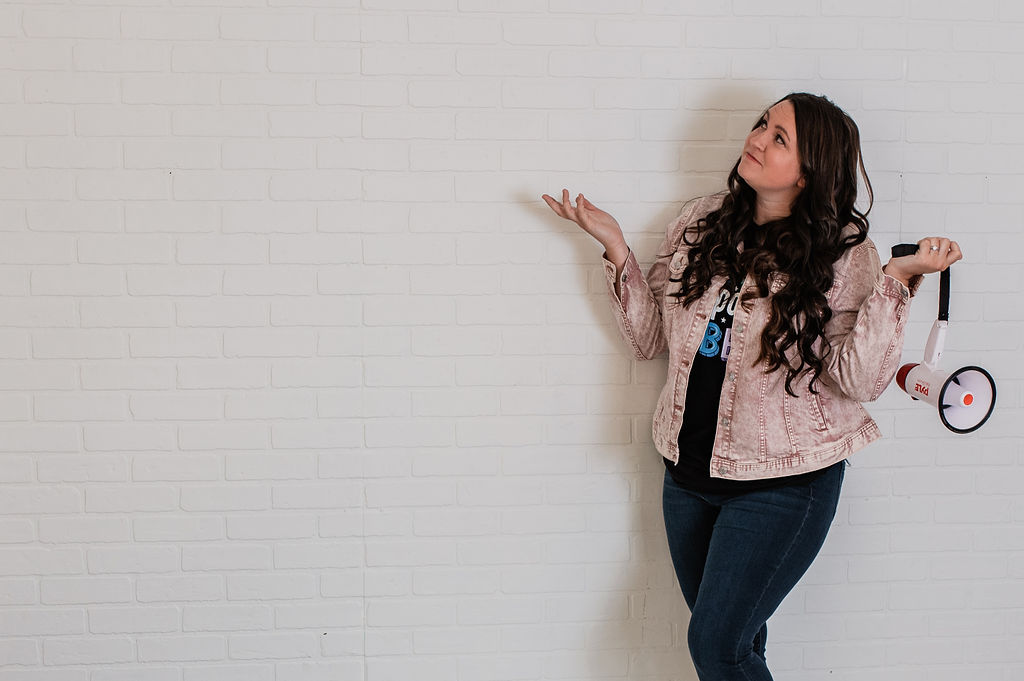
Traditional strategies are soooo boring nowadays, agreed?
That is exactly why we came up with our unique holistic approach to podcasting!
In this post, I’ll be going over our unique podcasting process and why it stands out from anyone else’s approach in this industry.
If you’re interested to learn what makes our holistic podcasting approach so special and how working with us will take your business to the next level, then keep reading.
The difference between a traditional approach and our approach.

What does the traditional podcast approach focus on?
- Download numbers.
- Unrelated paid sponsorships.
- Producing content for the sake of content.
- Interviews to fill episode gaps.
In this traditional approach, it normally creates a heavier workload for the creator, a lot which is unnecessary. This approach also separates the podcast from the business. With our approach, I want to help you get over this idea that your podcast has to be separate from your business because it absolutely does not!
Your podcast and business are one and the same and everything should feed into each other constantly, our holistic approach is great at intertwining the business and podcast.
The holistic approach focuses on priming and nurturing all of your dream clients. When you are sitting down and recording, you are talking to ONE person with whom you’re trying to build a deeper relationship with.
When someone knows, likes, and trusts you, it’s going to turn into more and more sales and that’s the first step in podcasting 101.
What the holistic podcast approach can do.
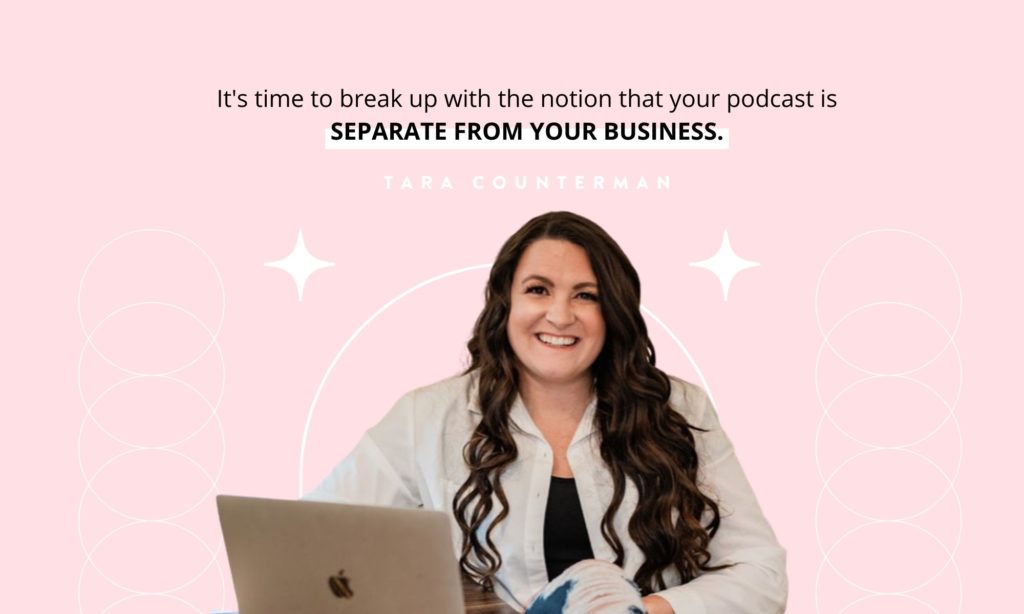
Our podcasting approach helps build brand awareness and share content that empowers your audience to take massive action in their lives.
When you holistically podcast, you’re also able to take that content and turn it into so many other things. For example, an Instagram post, a blog post, a whole YouTube video, an Instagram story etc. Whatever it is, you can constantly repurpose content and be really intentional with your posts.
You want to make sure your content is centered around what your community needs to see, hear, feel, and believe. One step to holistic podcasting is doing interviews with people in your industry or ones that have the same methodologies.
This will provide your audience with VALUE, which will keep them wanting more from you!

LISTEN ON SPOTIFY | LISTEN ON APPLE PODCASTS | LISTEN ON GOOGLE PLAY
Driving people with your content.
Yes, your content might be great but is it promoting all the other things in your business? Is it driving people to your website? Is it giving listeners an inside look at your offers?
These are things you really need to think about when podcasting.
If you need help planning out your content, you can ALWAYS lean on us. We have helped so many of our clients level up and get intentional with their content.
If you really want to maximize your podcast, it’s important to integrate it into your launches and content strategies. It’s all about the impact you’re going to make and the transformation you’re going to see.
One of the best things about podcasting holistically is you can drive people to your podcast for past content. If there was a Facebook live you did, add that to a podcast episode so people can hear it over and over again.
This becomes a lot easier when you batch record your episodes and have everything planned out in advance. I promise this process will take so much off your plate and guide you in the right direction.
Podcasting 101: The Traditional Approach vs. Our Unique Holistic Approach: The Bottomline
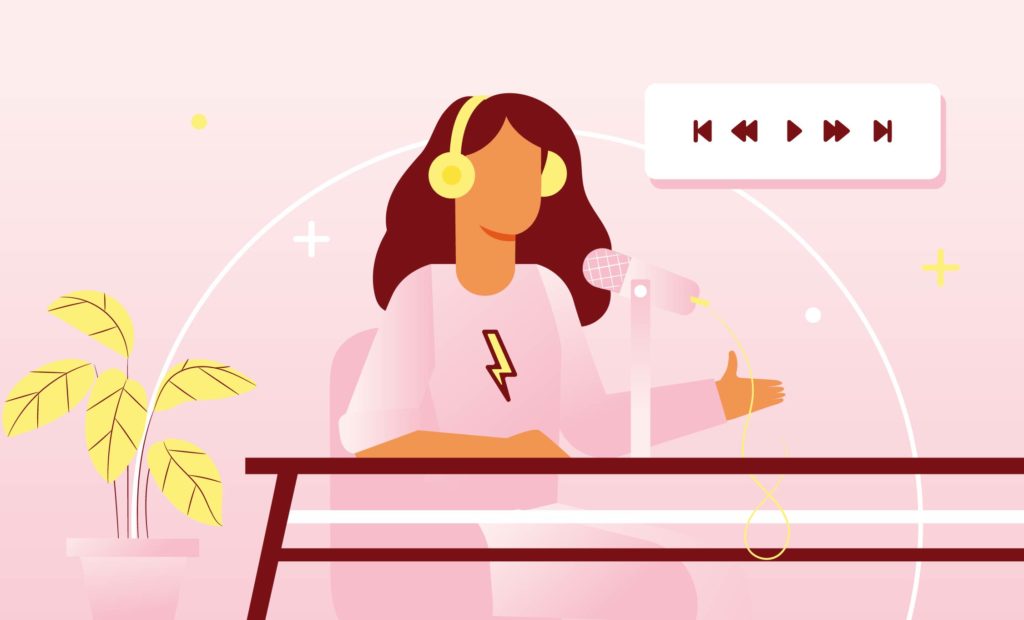
I hope throughout this post you learned the difference between the traditional approach to podcasting and our unique holistic approach. The holistic approach isn’t just about creating content, it’s about connecting with your community and giving them their desired transformation. And remember, we’re here and ready to help you take your podcast to the next level!
Be sure to connect with me more over on Instagram, I’d love to hear what you thought of this post and what your major takeaways were.
See you back here in the next one!
CONNECT WITH TARA:
Profitable Podcast Membership
EPISODE RESOURCES

If you’re an online entrepreneur who’s wondering how to tackle the task of protecting your business from a legal standpoint, then this episode is for you! I’m joined by Natalie Puglisi, a small business attorney and resource for online entrepreneurs. Natalie specializes in the online space. And I enjoyed learning about her passion for empowering female entrepreneurs to legally protect themselves, which leads to their empowerment to run their businesses successfully.
Having owned her own firm for about a decade, Natalie was able to share tons of insights and recount her experiences in helping online entrepreneurs overcome the common misconceptions of getting their business in order from a legal perspective. If you find yourself ready to tackle the legal necessities of owning an online business and to protect your podcast but you’re not sure where to start, we delve further into it below and on episode 56: How to Protect Your Podcast: A Legal Guide for Podcasters with Natalie Puglisi.
Natalie’s Story
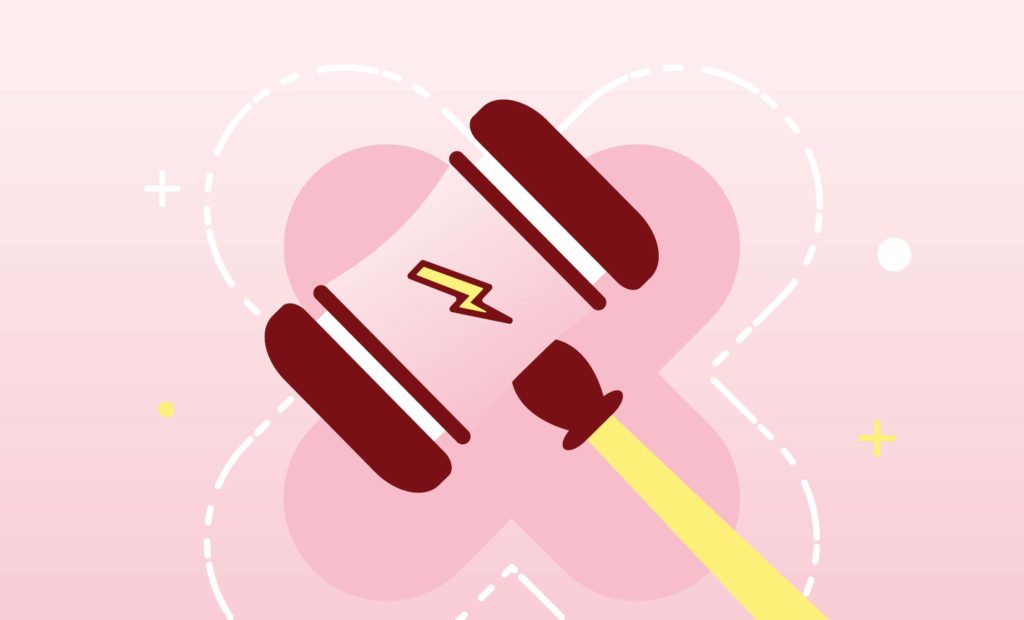
As mentioned above, Natalie is a small business attorney and resource for online entrepreneurs. She’s owned her own firm for about a decade, but that’s not how she got her start nor is it where she envisioned her career taking her when she first started out. She worked for a bankruptcy firm at the start of her legal career.
When the owners of the firm told her they were planning on retiring and shutting the firm down, she actually had no desire to own a business of her own. However, the universe had other plans. She soon found herself starting her own business.
Her experiences at the bankruptcy firm left her feeling rewarded – she enjoyed seeing the transformation her clients went through once they got the legal help they needed. That was part of what inspired her to help online entrepreneurs and podcasters alike to gain legal control over their own companies.
Struggles with Clients in the Online Space
Natalie explained that even as a lawyer herself, when she started her own firm it was intimidating to get her legal business documents in order. For online entrepreneurs, Natalie has faced the struggle of business owners finding the task of getting their company in order from a legal perspective to be overwhelming and confusing.
While this is an understandable fear, it doesn’t diminish the importance of getting your legal ducks in order, if you will, which is where Natalie comes in. She has the ability to simplify the process and show business owners that taking control of the legal aspects of their company is not that scary after all!
Another common struggle for Natalie is that many clients have the misconception that handling the legal aspect of their business will be too expensive. Natalie debunks this myth, explaining that handling the legal aspect of an online business is much more manageable and affordable than many would initially think.
Legal Issues that Commonly Occur for Online Entrepreneurs
Natalie shared with us what legal issues are common for online entrepreneurs. She noted that while she has clients that absolutely crush it in what they do – bringing in seven figures on an annual basis – that doesn’t mean their business is sound from a legal standpoint. She said there are people like this that “haven’t gotten around” to handling their legal paperwork who end up running into an unwanted legal issue.
But what kind of issues can come up? Natalie explained that the moment your business is live and you have a website or begin posting online, you’re gaining exposure that leaves you vulnerable to legal issues if you haven’t taken the right precautions. She shared with us that many online entrepreneurs have the mindset that they’ll get some traction in their business first, attain some clients, and then handle the legal stuff. But, the consequences of not handling these things proactively can be costly.
For instance, lawsuits are always a risk when you’re not legally protected. Another common issue is not having the right legal backing to get paid by your clients. If you don’t have the right contract in place denoting monthly payments from clients and then they don’t pay, it’s really hard to successfully go after that missed income.
Another issue that Natalie raised is that she’s seen clients who haven’t legally protected their brand correctly or soon enough. To safeguard against this, Natalie suggests Googling everything they want to do for their business for trademark purposes and running everything through the USPTO database. Any business with the same or even similar or conflicting aspects of their business can pose a legal risk to your own, so this is an important step to take and to get help with.

LISTEN ON SPOTIFY | LISTEN ON APPLE PODCASTS | LISTEN ON GOOGLE PLAY
How Online Entrepreneurs Can Find Quality Information and Service
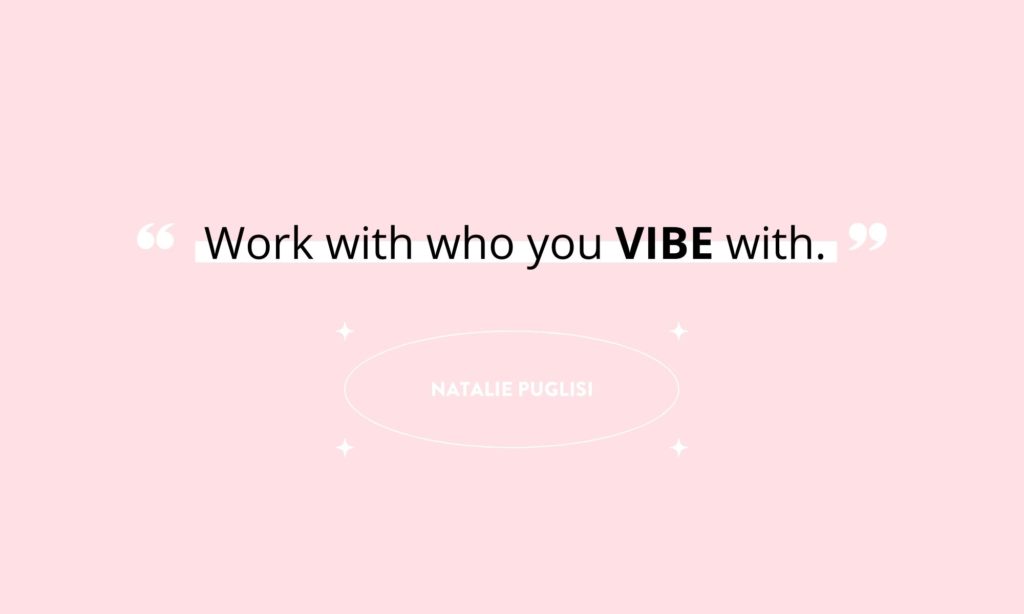
Protecting your business requires you to find quality information and service from a legal standpoint. Natalie shared that online entrepreneurs should find an attorney that specializes in the online space. Working with someone who works solely in this space means that they’ll have a clear understanding of any and all scenarios your business may face legally and will be able to help you build contracts and self-protection from there.
More importantly, online entrepreneurs should find someone that they vibe with and connect with when choosing to work with them. This applies to a lawyer and anyone else providing a service, really. You’ll want someone you feel comfortable working with and are able to trust in ensuring your business is in order legally.
In working with her clients, Natalie aims to break the stereotype that attorneys usually face. She’s committed to breaking that “stuffy” and “corporate” mold and wants to be a relatable person for her clients. She explained that she approaches her business from a spiritual perspective who wants to help her clients set the right energetic boundaries with their own clients.
Reevaluating Legal Needs
Another important topic covered in my conversation with Natalie is how often online entrepreneurs need to reevaluate their legal needs. She suggests doing this at least on a yearly basis around the time that you’re completing your taxes.
Especially if you’re using legal templates, you should question whether they’ve been updated and whether they’re still compliant. Many of these templates have fine print, denoting that they’re “not a legal service”, meaning that they’re not held to updates ensuring that they meet current laws.
Another common issue is if you used a privacy policy that you borrowed from someone else in your industry. This can lead to several problems. First, it could lead to legal action from the business you took it from or their lawyer. Second, if the policy isn’t current or correct on your website, it could mean that you’d be fined a hefty amount per site visitor, which can add up quickly and take a large toll financially on your business.
Natalie shared with us that she offers a range of legal templates for all different types of businesses in the online space. These come at affordable prices that can be paid in installments, even, making it easy to protect your business and content.
Legally Protecting Your Podcast
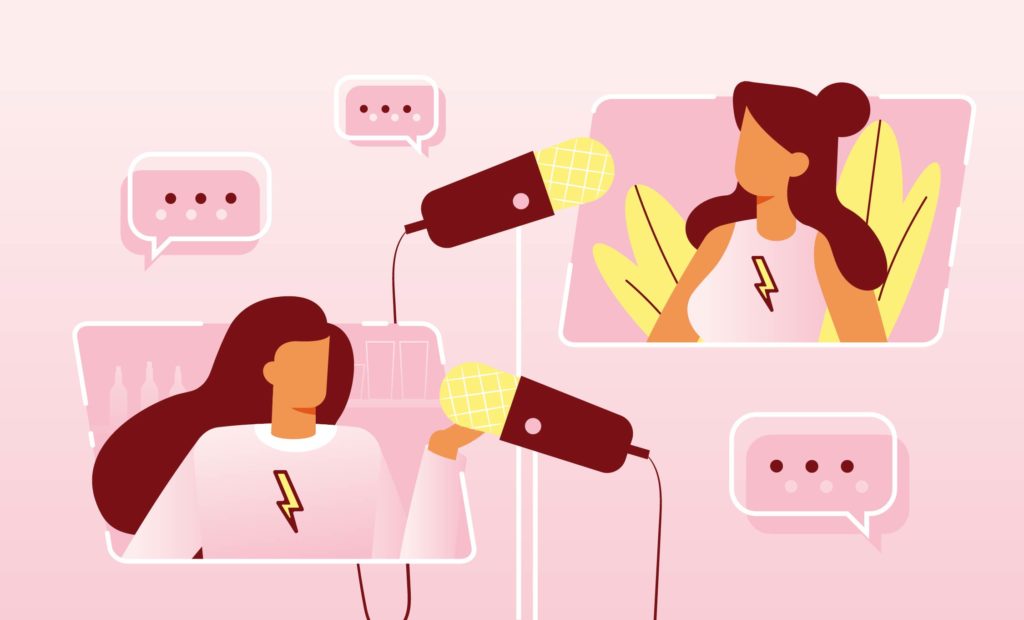
Finally, Natalie and I covered how to legally protect podcasts and their content. She discussed again how important it is to think through the trademarks of your podcast. You should always check whether the name of your podcast is in use by anyone else, or if it’s already been trademarked. If it hasn’t, you’ll want to trademark your name yourself. Doing this prevents brand dilution, which is important as you grow an audience and expand your reach.
Another important part of protecting your podcast is creating a speaker or guest agreement to be signed by anyone who comes onto your podcast. This is required in some states, but even if you’re operating in a state where it’s not required, it’s still worth covering your bases. Because you’re recording a guest to be used in a public forum (your podcast), this agreement is important.
Having this agreement in place also works to protect the content you put out on your podcast. It gives you the control and freedom as to what can be done with it, which is important! You work hard on your podcast, so having this control in place makes all the difference in empowering you to use it as you see fit and however it will best benefit your business.
Remember that you’re a CEO, which means that you are ultimately responsible for your company. With that being said, there are ramifications for not putting the right things into place from a legal perspective. I’m so glad I got to sit down with Natalie and gain some insight into her knowledge of the legalities of the online space and how we can all better protect our businesses.
Thanks so much for listening to CEO PWR The Podcast – I hope you learned as much from Natalie as I did! I’m looking forward to connecting with you via the links below and to having you back here for the next episode of the podcast.
CONNECT WITH TARA:
Profitable Podcast Membership
CONNECT WITH NATALIE:
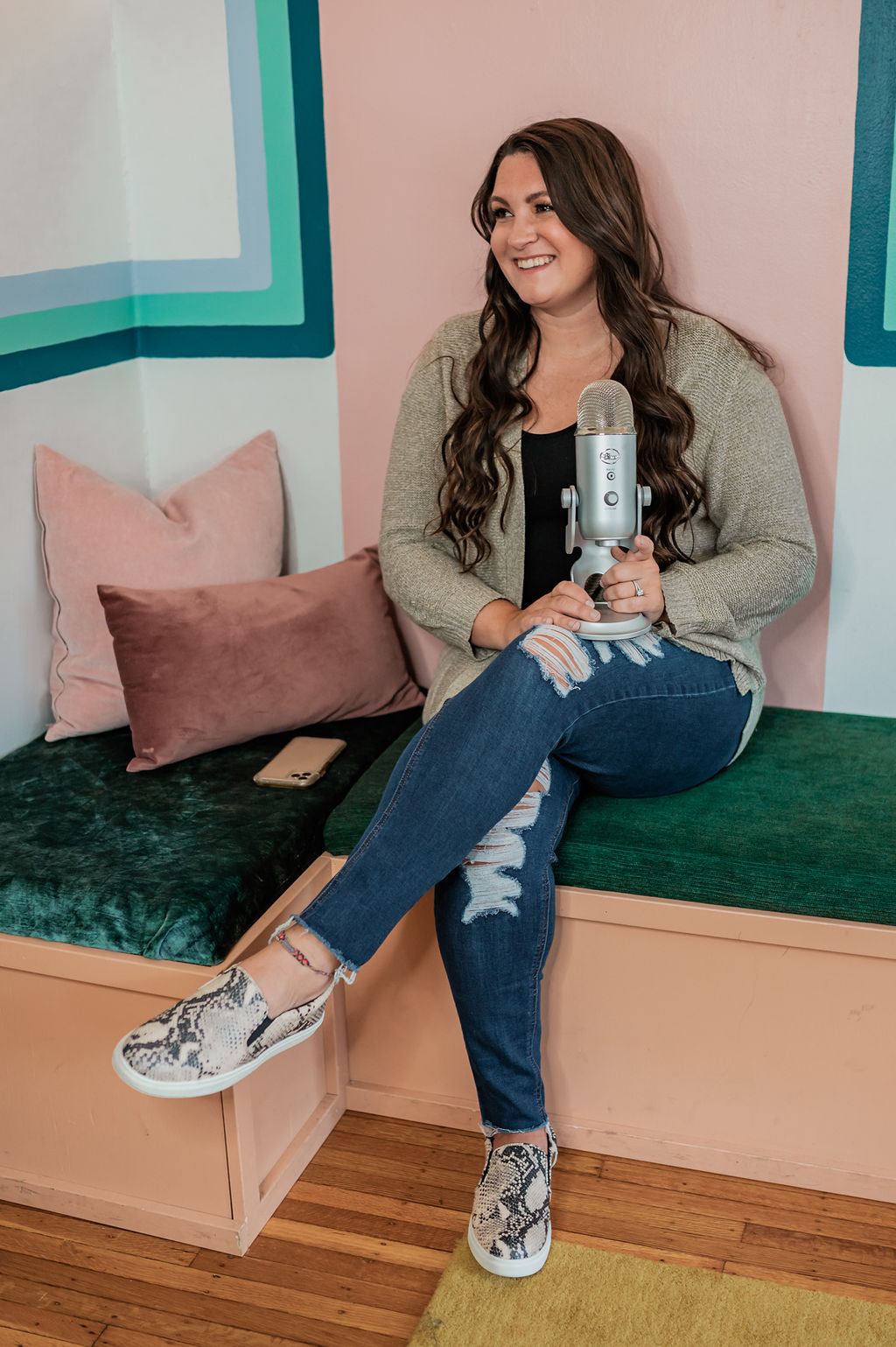
Today, I am sharing a recent interview I did on Inner Boss Podcast, with host Jen Casey. Jen is a business strategy and master-mindset coach for online coaches ready to grow and scale profitable and purpose-driven businesses. In episode 27 of The Podcast Podcast, we are going to share the top tips and strategies that I shared on Jen’s podcast covering a holistic approach to profitable podcasting.
In case this is your first time tuning in, let me introduce myself. My name is Tara Counterman. I’m the founder and CEO of Profitable Podcast Productions, the creator of Profitable Podcast School and basically, 1000% obsessed with helping online entrepreneurs step out of the busywork, stop struggling for paying clients and actually get their message out there.
So if you’re ready to learn my top tips and strategies on how you can start spending more time showing up for your audience and less time behind the scenes when you’re podcasting, check out the points I share below! And for even more juicy details, listen to ALL of episode 27 of The Podcast Podcast on your fave streaming platform.
THE HOLISTIC APPROACH, POINT #1: MY STORY AND HOW I GOT INVOLVED WITH PODCASTING.
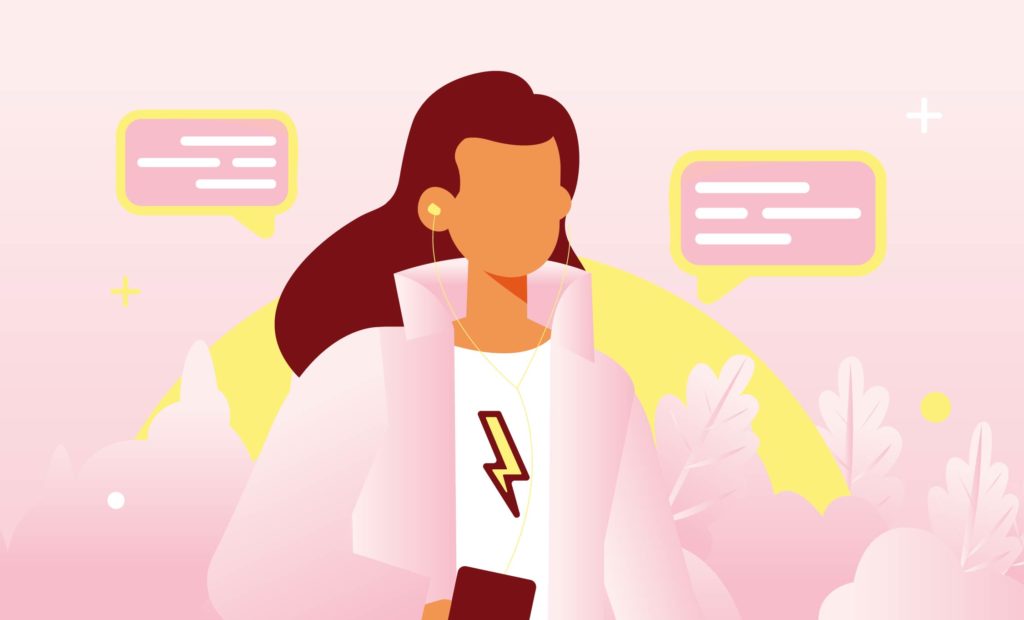
The first podcast I ever listened to was Jen’s. I didn’t even have a business at all, at that point, I realized I wanted to try out podcasting. This was right after I had Olivia, my oldest daughter who is four years old now. I was in a mom limbo and just felt like my only purpose was to be a mother. I listened to Jen’s podcast, which inspired me to get back into network marketing, but I struggled for quite a while. I had some success but it was never what I truly wanted, and I was putting so much time into network marketing. I started investing in personal development, I took Jen’s program, and I started to let myself move outside of network marketing. I started in coaching, specifically for moms struggling where they were at and wanting to do more while being a stay at home mom. Then, I kept having people come up to me asking how podcasting works once I started my own. I started showing up as myself instead of pretending I was someone I wasn’t, and everything fell naturally into place after that.
THE HOLISTIC APPROACH, POINT 2: THE BIGGEST MISTAKE I SEE WITH ENTREPRENEURS STEPPING INTO THE PODCASTING SPACE IS FIRST, THEY DON’T HAVE A SYSTEM IN PLACE THAT IS SAVING THEM TIME. SECOND, FORGETTING THERE’S A BUSINESS STRATEGY WHEN IT COMES TO PODCASTING.
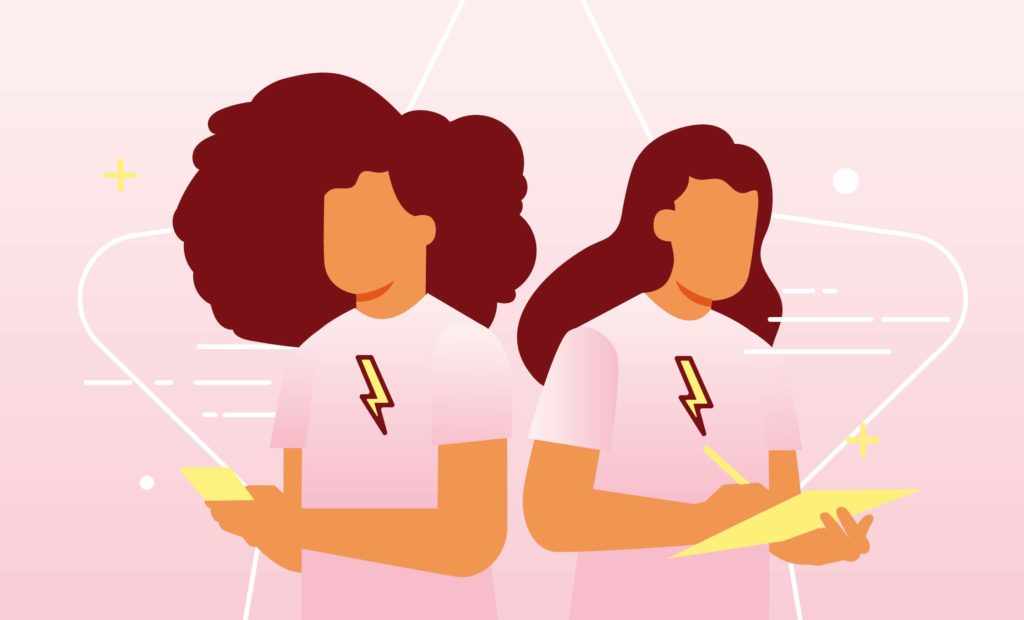
Making your time in front of the camera and microphone to make the biggest impact and reach is what I teach in my Profitable Podcast School. However, if you’re going to do that, then spend all the time repurposing without a system in place, you are wasting so much time. You are spending at least 10 hours every 2 weeks on stuff that you could have systemized and it would run so much smoother.
Another common issue is forgetting there’s a business strategy when it comes to a podcast. Especially for those of you invested in coaching, courses, all of that, you can take and mold that into how you run your podcast. It’s not just about starting a podcast simply because you feel it’s the next step you have to take in your business. You get to use all that strategy you paid probably thousands of dollars for and put it into your podcast so it has an even bigger reach. It’s common when you get into podcasting and you are by yourself to waste so much time. Remember, time is money. That’s time you can spend getting out and finding clients.

LISTEN ON SPOTIFY | LISTEN ON APPLE PODCASTS | LISTEN ON GOOGLE PLAY
THE HOLISTIC APPROACH, POINT 3: YOU SHOULD SPEND 20% OF YOUR TIME CREATING CONTENT AND 80% OF THE TIME REPURPOSING CONTENT.
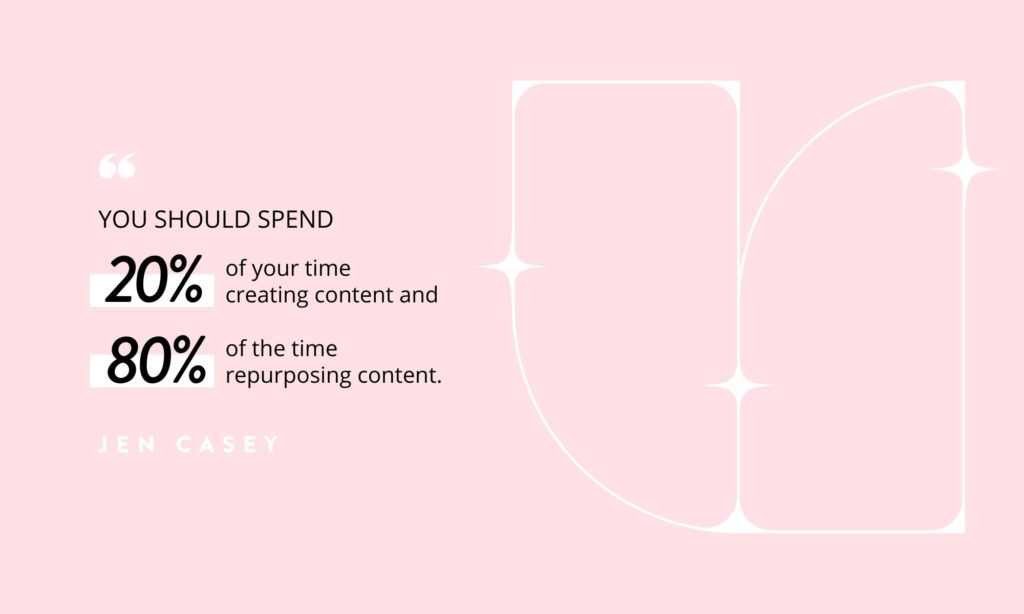
You should spend 20% of your time creating and 80% of your time repurposing content. That sounds low but the thing is, if you are strategic about it and focus on driving traffic to that podcast, you’re able to make a deeper connection with your audience. I spend so much time writing posts but when I have a podcast, I can say it, transcribe it and a post is formulated for me. We spend way too much time doing stuff that doesn’t matter. Written posts don’t really drive home with your audience, it’s not building that loyal fanbase of people hanging on your every word.
When you can get into someone’s earbuds every week, inspiring them and impacting them, that is what builds a raving fanbase. We have to get people there, bring them into the podcast. If you spend all this time creating content for the podcast but don’t ultimately focus on getting people to the podcast, you aren’t getting listeners. Only 4% of your audience sees any post on social media on average, if you have 1,000 followers that’s 40 people. If you are not continuously posting and repurposing content to drive people back to your podcast, nobody is listening to it.
THE HOLISTIC APPROACH TO PROFITABLE PODCASTING WITH JEN CASEY: THE BOTTOMLINE
When it comes to podcasting, there has to be a strategy behind it. Without a strategy, it can be easy to fall into a hole of overwhelm and poor time management. Podcasting is a growing powerful industry, and if you set up the right systems in place, it can be a great tool for your business.
I hope this episode was helpful and gave you insight into the importance of implementing strategies and planning how to use your time wisely when it comes to podcasting. So don’t forget to tune in to episode 27 of The Podcast Podcast to hear even MORE details about all of the points I just outlined above!
And if you love this episode as much as I do, don’t forget to take a screenshot, share it on your Instagram stories and tag me @ceopwr so that we can spread this important message to empower entrepreneurs and online business owners everywhere!
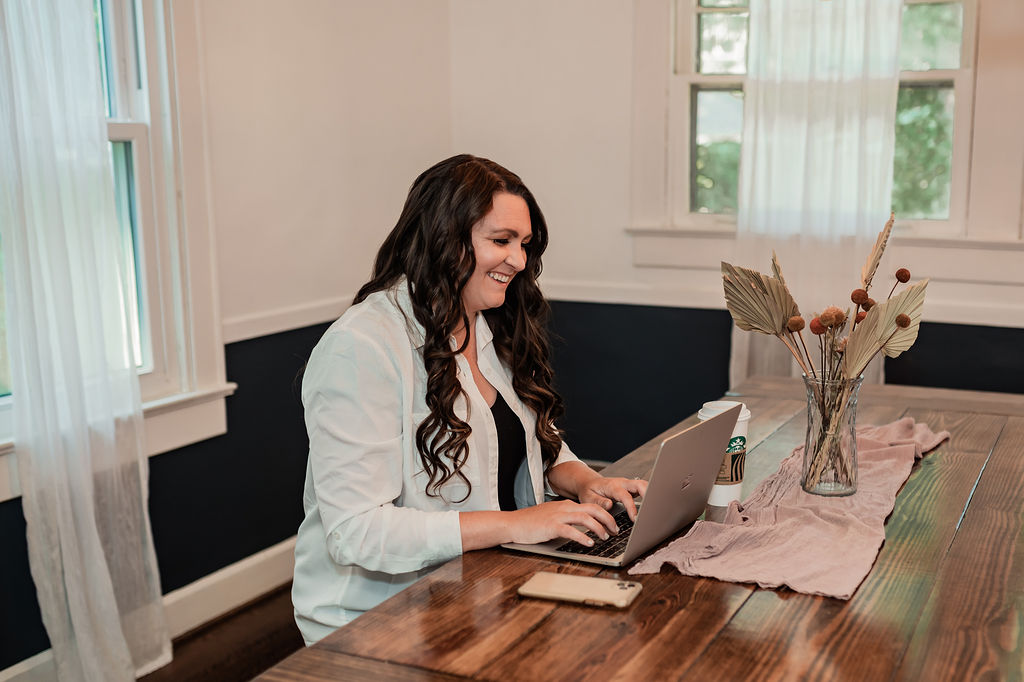
Market Research for Business: Behind the Scenes of My Market Research Strategies with Rachael Fisher
Today, we are going to dive behind the scenes with a special guest, Rachael Fisher. Rachael is a mindset and embodiment mentor for entrepreneurs. She is also an expert at helping entrepreneurs drop limiting beliefs and overcome imposter syndrome. In episode 32 of The Podcast Podcast, Rachael and I chat more about behind the scenes of what goes on in her podcast and podcast strategy.
In case this is your first time tuning in, let me introduce myself. My name is Tara Counterman. I’m the founder and CEO of Profitable Podcast Productions, the creator of Profitable Podcast School and basically, 1000% obsessed with helping online entrepreneurs step out of the busywork, stop struggling for paying clients and actually get their message out there.
So if you’re ready to dive into this episode and hear more about Rachael’s story behind her podcast and strategies to be put into place for podcast growth, check out the points I share below! And for even more juicy details, listen to ALL of episode 32 of The Podcast Podcast on your fave streaming platform.
MARKET RESEARCH FOR BUSINESS: RACHAEL SHARES HER BACKGROUND OF GETTING INTO THE ONLINE COACHING SPACE AND STARTING HER PODCAST.

For Rachael, understanding the significance of her podcast was something she hadn’t acknowledged at first. She realized there was so much she didn’t know behind podcasting and she had to look at it from a new perspective. Rachael’s story involves being in an online program to become a certified coach, she graduated in January of last year. All of last year, her business was like a hobby to her. Rachael was working through her inner struggles that were ultimately holding her back. In January, she left her corporate job and went full in with her business.
When it comes to her podcast, it’s been a dream of hers to start the last few years. Through doing lives and videos, people told her she should start a podcast. It was an idea of being able to reach people all over the world who would otherwise never find her on social media that grabbed her attention. She approached podcasting initially from an “I’m just winging it” mindset, without any strategy or knowledge on how to go about it profitably. What Rachael found after speaking directly to me about this was realizing how easy it can be to procrastinate recording for her podcast. Keeping in mind that it can be time-consuming and it may not be profitable right away makes it harder to stay consistent. Rachael got to the point where she began seeing her podcast as a tool for her business, rather than just a hobby.
MARKET RESEARCH FOR BUSINESS: RACHAEL BREAKS DOWN THE STRUCTURE BEHIND HER PODCAST.

Rachael has an intro and outro within her podcast, however, when it comes to the actual episodes, there’s no structure. She never knows exactly how long the podcast episodes will take. When it comes to deciding topics and content to discuss, Rachael would say it’s a mixture of mindset. It’s specific to entrepreneurs, all things around embodiment, energy work, and manifestation. All the things that encompass Rachael’s business are found in her podcast. She shares personal stories and things she’s worked through with clients, as well as tools and resources.
Rachael naturally finds that talking and sharing her thoughts to people is something she’s confident in, but issues always come back about how there’s so much more she could be doing and doesn’t know. She feels although the podcast episodes have a lot of value, there’s not a clear path to lead people. In some episodes, there’s a starting point, but the whole show in general doesn’t take people down a journey. When Rachael records the podcast, her partner edits and improves audio quality, and creates a graphic to share on social media. From there, Rachael would share the graphic on her IG feed and stories. In the last few weeks, Rachael admits she hasn’t been sharing the graphics to her social platforms.

LISTEN ON SPOTIFY | LISTEN ON APPLE PODCASTS | LISTEN ON GOOGLE PLAY
MARKET RESEARCH FOR BUSINESS: A COMMON MISTAKE MANY PODCASTERS MAKE IS THE LACK OF SOCIAL MEDIA AWARENESS ABOUT THEIR PODCAST. RACHAEL SHARES MORE ON WHY SHE’S MADE THIS MISTAKE HERSELF.
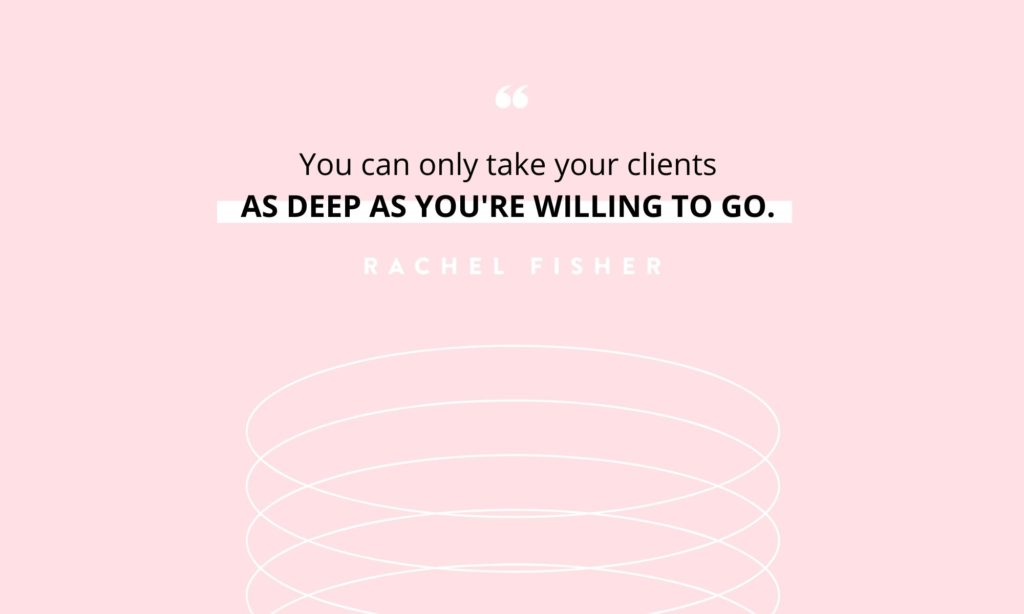
Rachael isn’t too clear as to why she doesn’t promote the podcast as much as she should. She believes due to not having many directions with her podcast creates resistance to wanting to promote. She finds that she doesn’t feel fired up or excited enough to share due to that lack of planning, so when it comes to sharing on social media she takes a more passive approach. She recognizes she needs to adjust this approach because she is sharing her value and spending valuable time to record the podcast episodes. For me, it’s very interesting because at the beginning of the call with Rachael she was very fired up about how special her show is and how she pours her heart into the value she provides. However, when it comes to promoting, she is closed off to the idea.
A lot of where this comes from for Rachael is that it’s fairly new, it’s vulnerable, and she’s out of her comfort zone. On top of that, not knowing her direction makes her insecure to share and promote. She finds herself wondering whether people will like what she has to say on her podcast. She finds she’s not fully confident in her podcast and that creates a shy approach. A common theme that Rachael has noticed in where she feels she needs attention in her business is more planning and prepping. This also shows up in her podcast, there’s no planning and that’s why there’s weeks or months where she doesn’t have episodes airing. She finds she resists the idea of planning and it’s a cycle of self-sabotage.
MARKET RESEARCH FOR BUSINESS: BEHIND THE SCENES OF MY MARKET RESEARCH STRATEGIES WITH RACHAEL FISHER: THE BOTTOMLINE
I am so grateful that Rachael came on the show and allowed me to do market research on her and her podcast. I wanted to show you guys how easy market research can be, market research doesn’t have to be super complicated. It can just be in conversations. We want to make sure we can take those limiting beliefs our ideal clients may be feeling, dissect them, and create content surrounding it. It’s our job as course creators and coaches to take those fears and the way they look at things to direct to a new lens.
So don’t forget to tune in to episode 32 of The Podcast Podcast to hear ALL the details about the points I just outlined above!
And if you love this episode as much as I do, don’t forget to take a screenshot, share it on your Instagram stories and tag me @ceopwr so that we can spread this important message to empower entrepreneurs and online business owners everywhere!
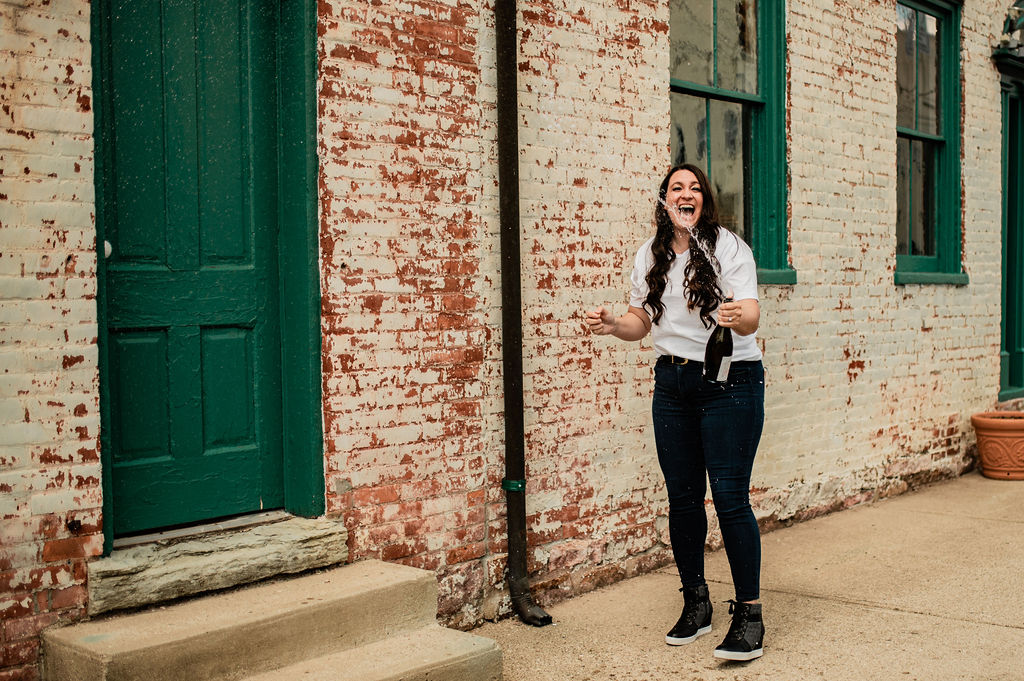
Today, I want to share my journey of how I went from the DIY podcaster to now being the CEO profitable podcaster. In episode 34 of The Podcast Podcast, I want to reflect upon my podcasting journey. If you are listening to this podcast, you most likely aspire or want to have your own podcast too. I know it can be easy to feel overwhelmed and intimidated, but remember that we all start somewhere!
In case this is your first time tuning in, let me introduce myself. My name is Tara Counterman. I’m the founder and CEO of Profitable Podcast Productions, the creator of Profitable Podcast School and basically, 1000% obsessed with helping online entrepreneurs step out of the busywork, stop struggling for paying clients and actually get their message out there.
So if you’re ready to dive into this episode and hear more about my success plan journey, check out the points I share below! And for even more juicy details, listen to ALL of episode 34 of The Podcast Podcast on your fave streaming platform.
MY SUCCESS PLAN: I SPENT MONTHS PLANNING AND PREPPING FOR MY PODCAST, BUT NEVER LAUNCHED. ONCE I DID LAUNCH, I SHOWED UP VERY INCONSISTENTLY.
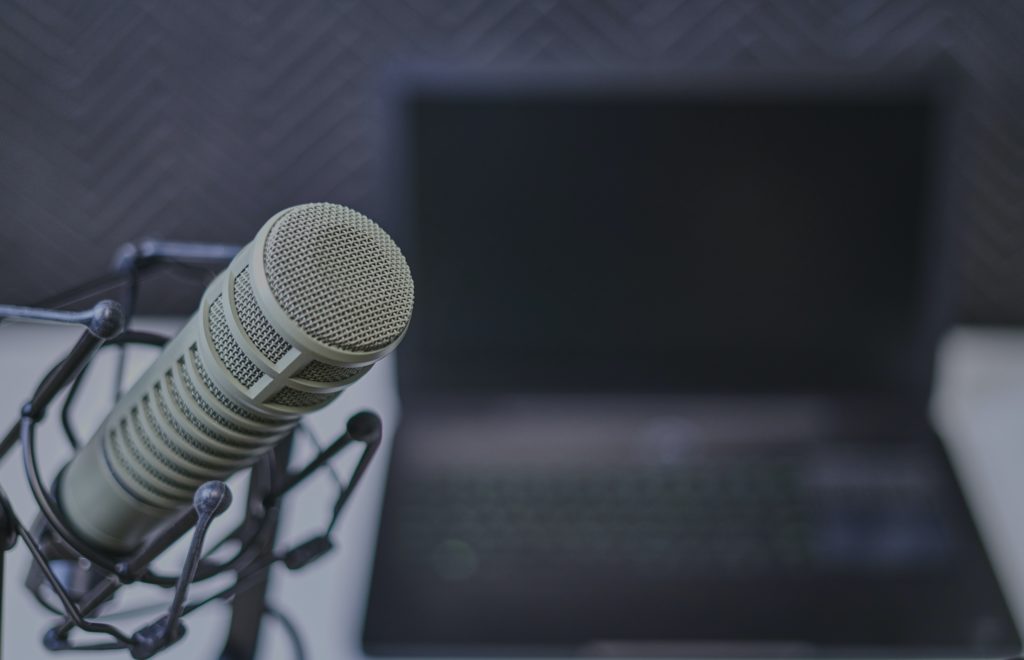
If you’re in the “I want to be a podcaster” phase or if you’re in the traditional podcaster phase too taking on a lot of things yourself, just know it’s possible to move through and uplevel your podcast. Having a profitable podcast is not out of reach, it just takes time. When I first started my podcast, I was in Network Marketing. I was playing around with the idea to do things differently, in this specific Network Marketing company, I wanted to build a personal brand. I had been listening to podcasts to get inspiration but I kept waiting. I had this idea in my head but I kept pushing it off.
I never prioritized getting in front of my audience and connecting. When I had started my podcast, I did develop better organizational systems. However, at first, it was a total mess. I know how hard it is to be a DIY podcaster and having to manage everything on your own. That’s why I teach on this, I know it’s not fun to go through that learning phase. I spent months and months trying to learn but not launching my podcast show. Once it did launch, I showed up very inconsistently.
MY SUCCESS PLAN: I FINALLY HAD A BREAKING POINT AND REALIZED I NEEDED AN ORGANIZATIONAL SYSTEM FOR MY PODCAST.
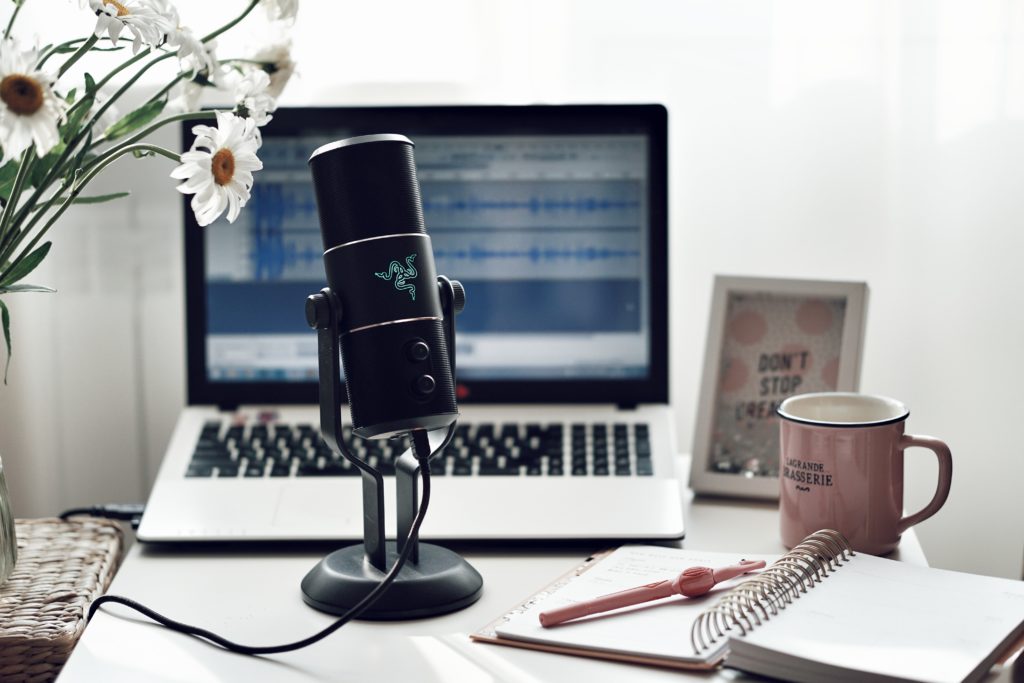
Now when I record my podcasts, I have my microphone attached to my desk that hangs in front of my camera. I used to record in a closet and there were so many late nights where I’d be up recording, editing, and gathering promotional content by the next day. The whole process was rushed, my topics didn’t have anything to do with my launches, and I did a lot of stopgaps with interviews. Overall, I wasn’t efficient. Finally, I had a breaking point, it was a late night and I realized I needed help to get ahead. That’s when I developed an organizational system that I now teach other podcasters. This organizational system was focused on batching.
I was getting more intentional with batching and not doing things week by week. When I was able to batch tasks such as recording, editing, and social media promotions, I freed up my mind so much. Instead of jumping around task to task and losing time, I structure work times around what similar tasks I can batch together.

LISTEN ON SPOTIFY | LISTEN ON APPLE PODCASTS | LISTEN ON GOOGLE PLAY
MY SUCCESS PLAN: I HAD TO DROP LIMITING BELIEFS WHEN IT CAME TO HIRING PEOPLE ONBOARD TO HELP ME WITH MY PODCAST.
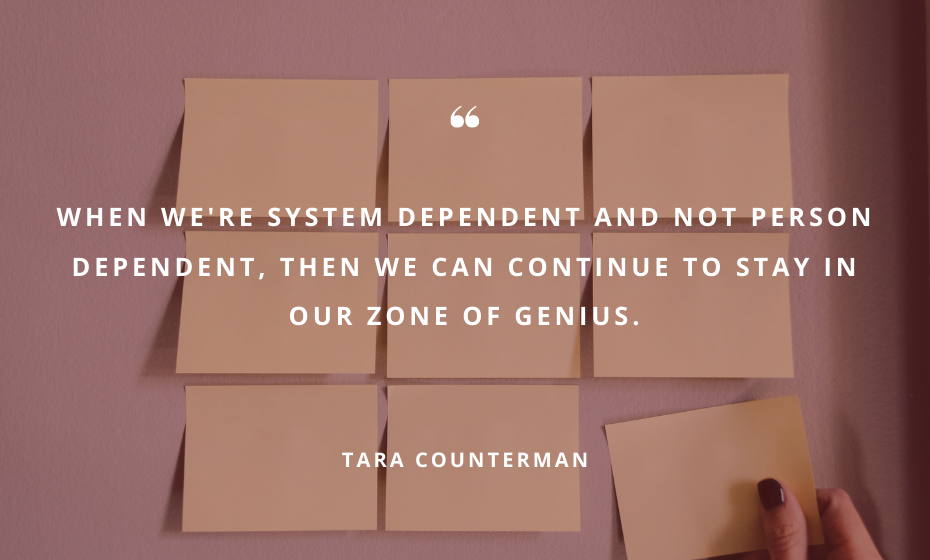
Once I had my systems in place, I began searching for a Virtual Assistant. This was scary for me at first because I felt like I had the capabilities to do it all myself, this is such an untrue belief by the way. If you are a solopreneur, I need to emphasize that there are people who can take on and handle tasks for you. I finally overcame this limiting belief, I hired a Virtual Assistant based on training. If you are in a position where you need help whether it’s podcasting or something else, you can find people who need the skill you have, and then train them. I focused on what our organizational system looked like so that the virtual assistant could easily take tasks off my plate. If I were to do this again, I wish I had documented my processes and expectations before hiring someone. If you are in a stage where you are doing everything yourself and being very particular, outline all your processes and standards. This way when someone comes in, you can provide them those resources as a starting point.
Between the virtual assistant and I, we spent time working on the system and training. Eventually, I could focus more on recording while she would work on copy and graphics. I created templates in Canva so that all she had to do was duplicate a version and update it with the correct information. At this time I was posting gradually, but the VA took over so I could focus more on the podcast. I did let go of this particular podcast eventually as it wasn’t aligned with what I wanted. I walked away from that and found my zone of genius within podcasting.
MY SUCCESS PLAN: OVERALL IT TOOK ME ABOUT 2 YEARS TO ELEVATE FROM THE WANT TO BE PODCASTER INTO THE CEO PROFITABLE PODCASTER.
I ended up having people come to me for guidance and help with podcasting. If you find this happening to yourself, let it be a sign from the universe to start paying attention to it, because more than likely, the solution they are seeking from you is something you can turn into a career. After so many people kept coming to me for podcasting advice, I quickly pivoted into podcasting. From there I didn’t start my podcast right away, because I was so busy with client work. Eventually, I built out my agency. You will always be able to find, train, and develop a team that can support you. It can be a small team or a big team. After the agency was established, I did launch my podcast and went all in. At this point, I had a team to support me and it felt great!
It took around 2 years for me to elevate from the Want to Be podcaster to the CEO profitable podcaster. This entire thing is a journey and process, don’t ever feel like you have to rush it all. When you do start as someone who is doing it all yourself, you can understand what needs to be done, and create processes and systems. That’s a great thing because you can bring in the right hires. One of the best pieces of advice I’ve ever gotten from my coaches was to make your positions system-dependent rather than person dependent. If you hire someone, you want to make sure you have the processes and tasks documented so if anything were to happen, you can put someone else in that position with ease. Make sure you document now, no matter what stage you are at. Also, think about the things that are truly important or worth your time.
MY SUCCESS PLAN JOURNEY: THE BOTTOMLINE

I wanted to share my journey with you and let you know no matter what stage you are at, you aren’t stuck. You can always go forward, and hiring a Virtual Assistant is one of the best things I did, it started to expand my mind. I was able to see what could be possible. I hope hearing my story provides you perspective and insight on what could be possible for you and your podcasting journey. It doesn’t have to happen overnight, it’s just about breaking down where you want to go and figuring out the steps you need to take.
So don’t forget to tune in to episode 34 of The Podcast Podcast to hear ALL the details about the points I just outlined above!
And if you love this episode as much as I do, don’t forget to take a screenshot, share it on your Instagram stories and tag me @ceopwr so that we can spread this important message to even more entrepreneurs and online business owners!
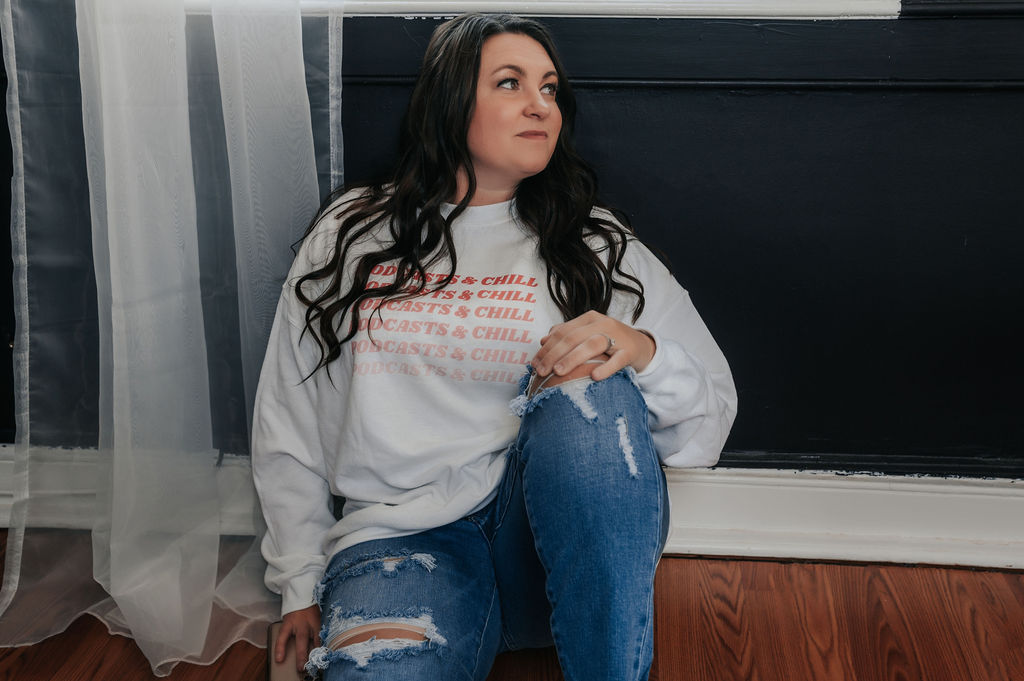
In episode 35 of The Podcast Podcast, I want to share an experience I had recently that reaffirmed the power of podcasting. I was so inspired to share this because I believe it’s so important to understand and know that podcasting can truly translate to generating income, revenue, and sales.
In case this is your first time tuning in, let me introduce myself. My name is Tara Counterman. I’m the founder and CEO of Profitable Podcast Productions, the creator of Profitable Podcast School and basically, 1000% obsessed with helping online entrepreneurs step out of the busywork, stop struggling for paying clients and actually get their message out there.
So if you’re ready to dive into this episode and hear more about how to know if you are on the right path and my recent experience that puts things into perspective, check out the points I share below! And for even more juicy details, listen to ALL of episode 35 of The Podcast Podcast on your fave streaming platform.
HOW TO KNOW YOU ARE ON THE RIGHT PATH: MY RECENT ENCOUNTERS THAT VALIDATED WHAT I DO TO HELP ENTREPRENEURS GROW THEIR PODCASTING PLATFORM, AS WELL AS HOW POWERFUL A PODCAST CAN BE.

I was having a self-care day, I had appointments to get my hair and eyebrows done. It was the craziest thing because both of these small business owners listened to podcasts, which is highly uncommon for where I live in my small town. They both shared with me that they were avid podcast listeners and they were impacted by the podcast. Both of them thought about purchasing and one ended up enrolling in an online course from this podcast host she had been listening to for a long time. This was a hairstylist, and she found a podcast specific for hairstylists. This is why niche marketing is so great, there are people out there that need your specific niche and topic. After her sharing that with me, I had this moment thinking about how this is so cool because this is what I do to help people, not only was it validation for me, I want it to be a validation for you that this platform can work for you.
I’m in a small town in Indiana, yet this hairstylist was impacted and moved by the podcast host and so invested with that host without ever having to meet her in person. Without the podcast, she probably wouldn’t have found her on social media because she mentioned she wasn’t a huge social media user. This is the power of what this platform can do for you! My other appointment with the esthetician was quite similar. She was sharing how she learned from a podcast specific to her niche as well and followed along to watch the host launch a program and make six figures. She was so blown away by the fact that this host had such huge success – this all comes from creating that connection, nurturing, and priming.
HOW TO KNOW YOU ARE ON THE RIGHT PATH: IF YOU’VE BEEN FEELING PULLED TO START PODCASTING, THIS IS YOUR SIGN TO DO IT NOW AND GO ALL IN!
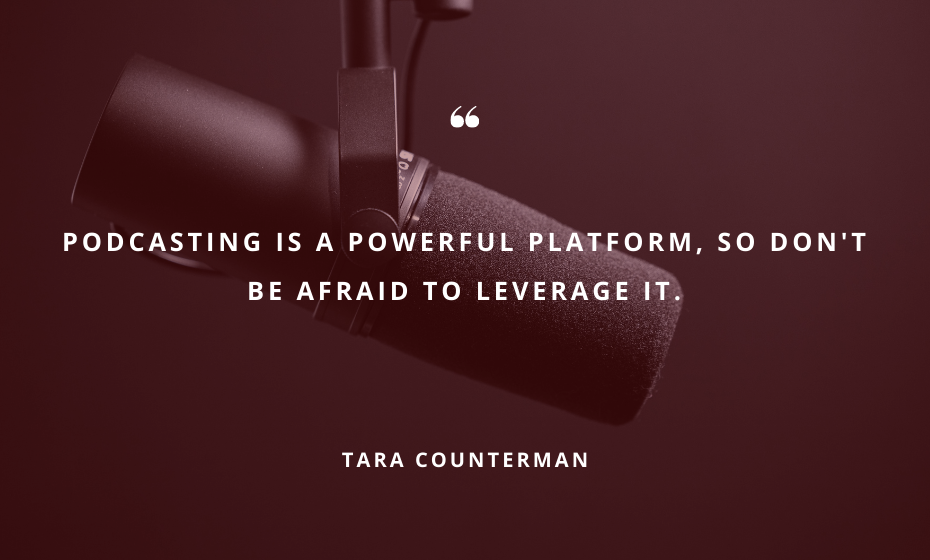
I wanted to share this with you guys because with these instances in my very small town, this is a big deal. This is something you can leverage in your business, especially moving into 2021. This is a validation for you that you can go all-in on your podcast. We can teach you how to leverage the time that you spend in front of the microphone, whether that’s 15 minutes or an hour that’ll make your business feel easier, make connections come easier, and have sales flow naturally to you.
If it works for two people in my small community, it means that it’s working for people everywhere. Podcasting is a powerful platform that doesn’t have boundaries as to who can come across it, as to who can be impacted, and who can connect with you. So don’t be afraid to leverage it!

LISTEN ON SPOTIFY | LISTEN ON APPLE PODCASTS | LISTEN ON GOOGLE PLAY
HOW TO KNOW YOU ARE ON THE RIGHT PATH: THE BOTTOMLINE

This was a bit of a shorter episode but I wanted to make sure that I shared these experiences with you guys and put things into perspective as far as how powerful podcasting can be. I hope hearing about this validates your dreams and goals with your podcast!
So don’t forget to tune in to episode 35 of The Podcast Podcast to hear ALL the details about the points I just outlined above!
And if you love this episode as much as I do, don’t forget to take a screenshot, share it on your Instagram stories and tag me @ceopwr so that we can spread this important message to even more entrepreneurs and online business owners!
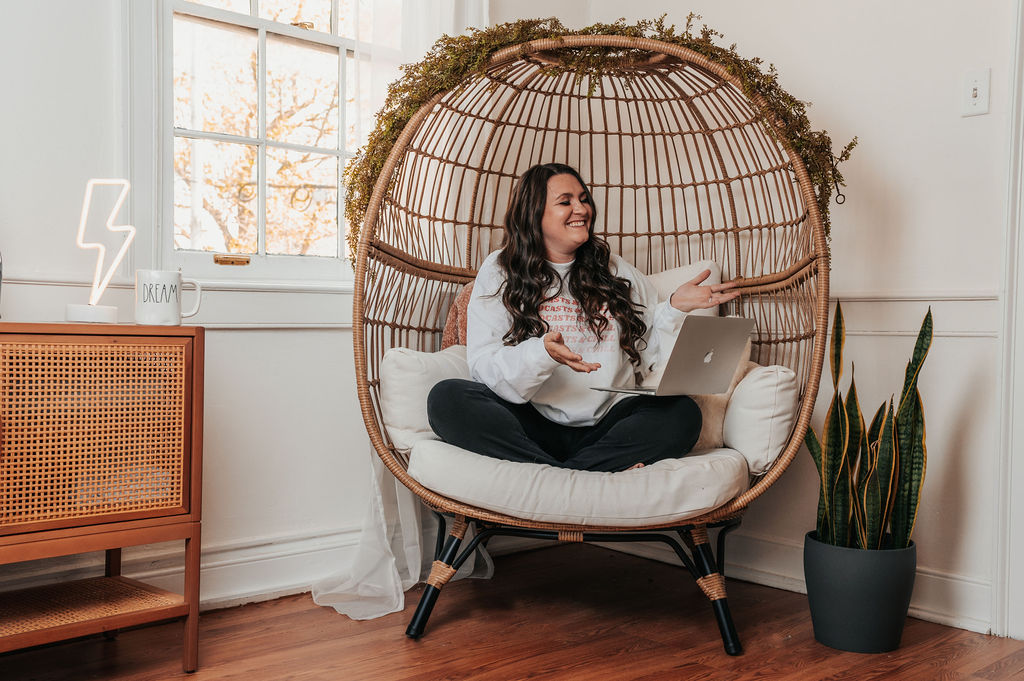
In episode 36 of The Podcast Podcast, I am so excited to have Lauren Taylar joining us. Lauren is a brand designer, website designer, and SEO strategist. She helps powerhouse coaches and creatives build a highly converting website and create an evergreen lead generation machine so that they can stand out, get seen, and make more sales. After spending 2 years in the SEO industry servicing billion-dollar global brands, Lauren is passionate about combining the art and science of websites to give her clients a rock-solid online presence. In today’s episode, Lauren shares her knowledge and wisdom on all things SEO.
In case this is your first time tuning in, let me introduce myself. My name is Tara Counterman. I’m the founder and CEO of Profitable Podcast Productions, the creator of Profitable Podcast School and basically, 1000% obsessed with helping online entrepreneurs step out of the busywork, stop struggling for paying clients and actually get their message out there.
So if you’re ready to dive into this episode and hear more from Lauren and all her SEO knowledge, check out the points I share below! And for even more juicy details, listen to ALL of episode 36 of The Podcast Podcast on your fave streaming platform.
SEARCH ENGINE OPTIMIZATION BENEFITS: LAUREN SHARES HER BACKGROUND AND HOW SHE GOT STARTED IN THE ONLINE COACHING SPACE.

After graduating from college, Lauren got a job at an SEO agency. She spent two years working on accounts for billion-dollar brands and high profile clients. This involved a lot of technical and content writing work. Ultimately, all of this made Lauren realize she wanted more for herself. Eventually, she discovered the online space and realized she had this passion for design, especially website design. Now, Lauren is passionate about combining her past technical experience alongside her passion for design.
As she has come into the online business world, she’s seen a huge gap between design and SEO with websites. Alongside this, Lauren shares that a Facebook Ad is what started her transition into the coaching space. She remembers coming across an ad one day about two girls who were building their business from Bali. She took the webinar which dove into how you can start a service-based business and work from anywhere in the world. This entire concept hooked Lauren and she was so intrigued to learn more. Later, she took a design course from them and realized she was obsessed with designing logos as well as websites. This has driven her to help coaches and creatives master SEO as well as having a bomb ass website!
SEARCH ENGINE OPTIMIZATION BENEFITS: LAUREN BREAKS DOWN WHAT SEO MEANS AND WHY YOU SHOULD HAVE AN SEO STRATEGY IN YOUR BUSINESS.
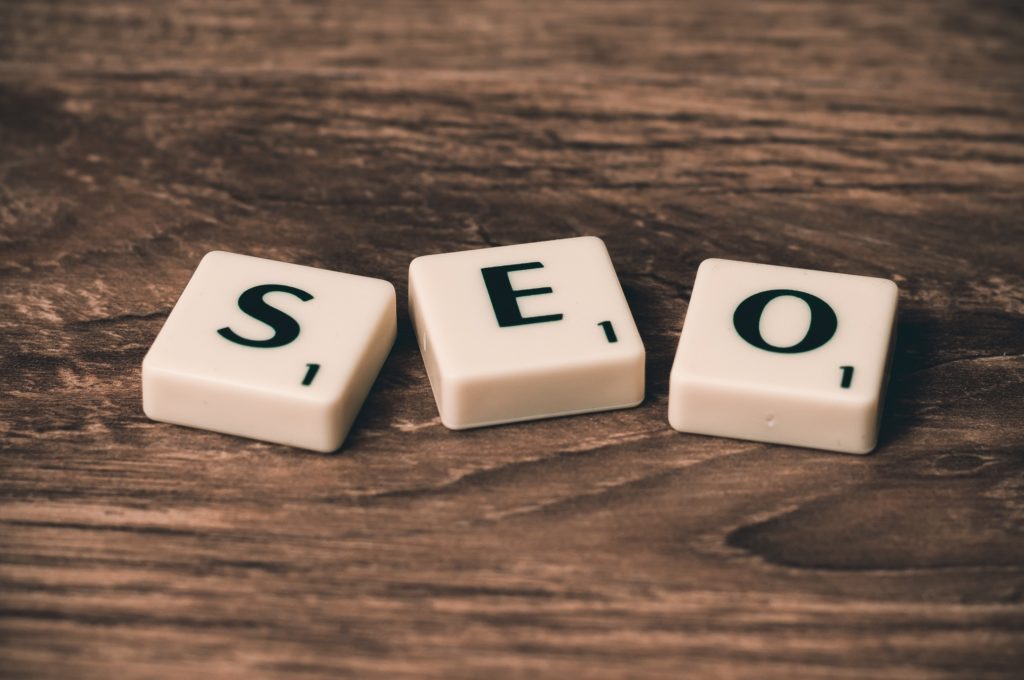
SEO stands for Search Engine Optimization. It’s all about making your website readable by search engines. It’s also about making content/technical tweaks to give your website the best chance of ranking high in search engines such as Google or Pinterest. Lauren shares that it’s essential to have an SEO strategy in your business because you have to think long-term. Building a blog and pairing it with an SEO Strategy is a long-term visibility plan that can work for years. Instagram and Facebook posts only last hours, where we constantly have to recycle content. Whereas, blogging has a life span of years. So, instead of chasing down clients on Instagram constantly, people can find you as they search for solutions to their problems on Google.
Lauren also says that by implementing an SEO strategy and being top ranking on search engines, you are establishing yourself as an authority, growing your business on autopilot, while also leveraging more sales. I asked Lauren for her opinion on SEO if someone was using Facebook Ads and Pinterest. Lauren highly encourages still implementing an SEO strategy because ultimately, anything can happen. Facebook could go down tomorrow for all we know. The other perspective to look at is exposure and cost. By ranking on Google and getting traffic, this is organic and free. Whereas you have to pay for Facebook Ads. Over time, if you are mastering your SEO skills, you won’t need to use ads anymore. This saves you MONEY and increases your EXPOSURE! What a win-win.

LISTEN ON SPOTIFY | LISTEN ON APPLE PODCASTS | LISTEN ON GOOGLE PLAY
SEARCH ENGINE OPTIMIZATION BENEFITS: LAUREN SHARES THE 3 BIGGEST MISTAKES THAT SHE SEES PEOPLE MAKING WHEN IT COMES TO SEO.
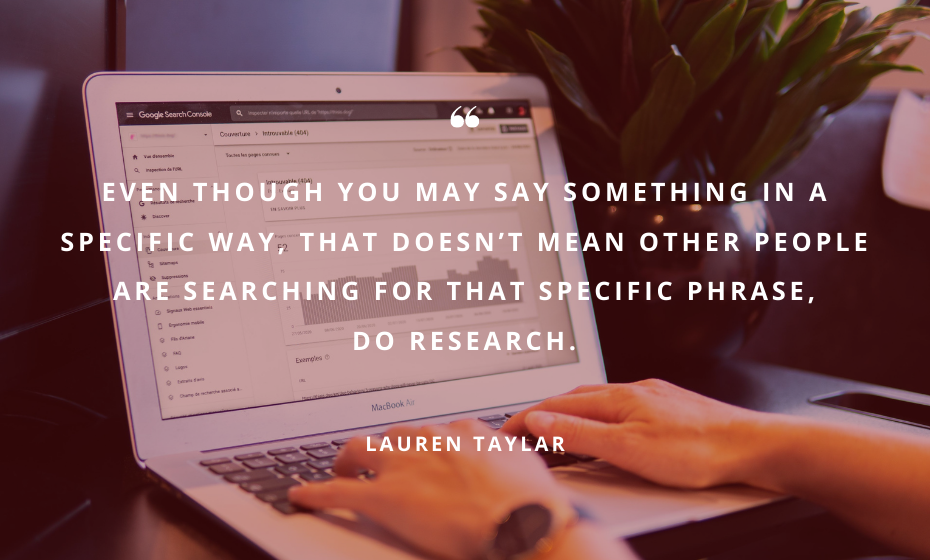
The first mistake Lauren shares when it comes to people using SEO is not doing keyword research. If you aren’t using the exact words or phrases that people are searching for in Google, you are basically setting up your blog or podcast show notes to fail. Most business owners don’t take the time to do this research, but it’s critical to rank and show up in search engines. Lauren points out that even though you may say something in a specific way, that doesn’t mean other people are searching for that specific phrase, so do research!
The second mistake Lauren shares is writing short blog posts. Lauren defines a short blog post as 500 words or less. Although this may work for Pinterest, it definitely won’t serve you on Google. Google wants to showcase high-quality content, and they don’t see 500 words as high quality. Lauren recommends aiming for writing at least 1,000 words in your content. If you can go up to 3,000 that’s even better.
The third mistake Lauren shares is keyword stuffing. Lauren explains that keyword stuffing is a spammy SEO tactic used to trick Google. This looks like taking a long tail keyword, 3 words or more, and integrating this into various parts of your website or blog. Lauren has seen this, especially in photographers. She points out that this method is very unnatural and robotic, so it’s best to avoid this. We have to focus on the user experience, not on Google. While we do want to rank on Google, we ruin the user experience by keyword stuffing. To avoid this, Lauren recommends reading your content out loud and determining if it sounds natural or unnatural.
SEARCH ENGINE OPTIMIZATION BENEFITS: LAUREN DIVES INTO SITE SPEED AND THE ROLE THAT PLAYS WITH SEO.
Lauren shares that site speed is another huge aspect of SEO. She shares that specifically, images are the number one way to slow down your website. Typically, when you get photographs from a Brand Photographer, they will give you file sizes between 3 and 15 MB. This is huge! You should be aiming to get it down to 500 KB. Make sure you are condensing your images before uploading them to your website.
Lauren shares her 3 step process to do just that:
- Lauren opens up the image and selects Edit File Size. She will manually condense the file size down to a minimum of 2,000 pixels wide for banner images. She recommends never going lower than 1,500 as that will compromise your image quality.
- After that, Lauren will go into Jpeg Mini Pro to further condense the image.
- The last step is going into Tiny Png and even further condensing the image.
By using these tools and manually condensing the image, you can increase site speed without compromising the quality of the images on your website. Lauren shares that it can be time-consuming but it’s definitely worth it. Keep in mind that if your website takes about 10 seconds to load, people are most likely going to leave. Nowadays, people will give your website about 2-3 seconds to load.
The other point Lauren brings up with site speed and images is file names. She shares that you can use the file name of your image as an opportunity to further rank with Google. She recommends adding a keyword to your image file name, you can put one keyword that’s in your blog post title or whatever keyword you are trying to rank for. Alongside that, you want to utilize alt text. Alt text is a way to tell Google what your image is and to communicate it to visually impaired people. You can do this by typing in the keyword, putting a dash, and then briefly describing what the image is. If you don’t do this and you upload the image without any file name, Google won’t know what the image is. Make sure you utilize this feature for both Google and the user experience.
WHY SEARCH ENGINE OPTIMIZATION BENEFITS YOUR BUSINESS WITH LAUREN TAYLAR: THE BOTTOMLINE

I hope this episode has helped you better understand exactly what SEO means and why it’s so beneficial to your business! Be sure to grab Lauren’s free checklist that you can find on her website.
Lauren has tons of resources you should check out. You can also sign up for the course I have been taking from her, SEO Strategy Simplified. If you do purchase this course, be sure that you email support@profitablepodcastproductions.com to claim a pre-recorded bonus that dives into behind the scenes of what we’re changing over at Profitable Podcast Productions since taking Lauren’s course and working with her!
Believe it or not, this is just scratching the surface. SEO is so worth putting the effort in because if you can get to the point of driving free traffic to your podcast or website, it will be more than beneficial for you long-term.
So don’t forget to tune in to episode 36 of The Podcast Podcast to hear ALL the details about the points I just outlined above!
And if you love this episode as much as I do, don’t forget to take a screenshot, share it on your Instagram stories and tag me @ceopwr so that we can spread this important message to even more entrepreneurs and online business owners!
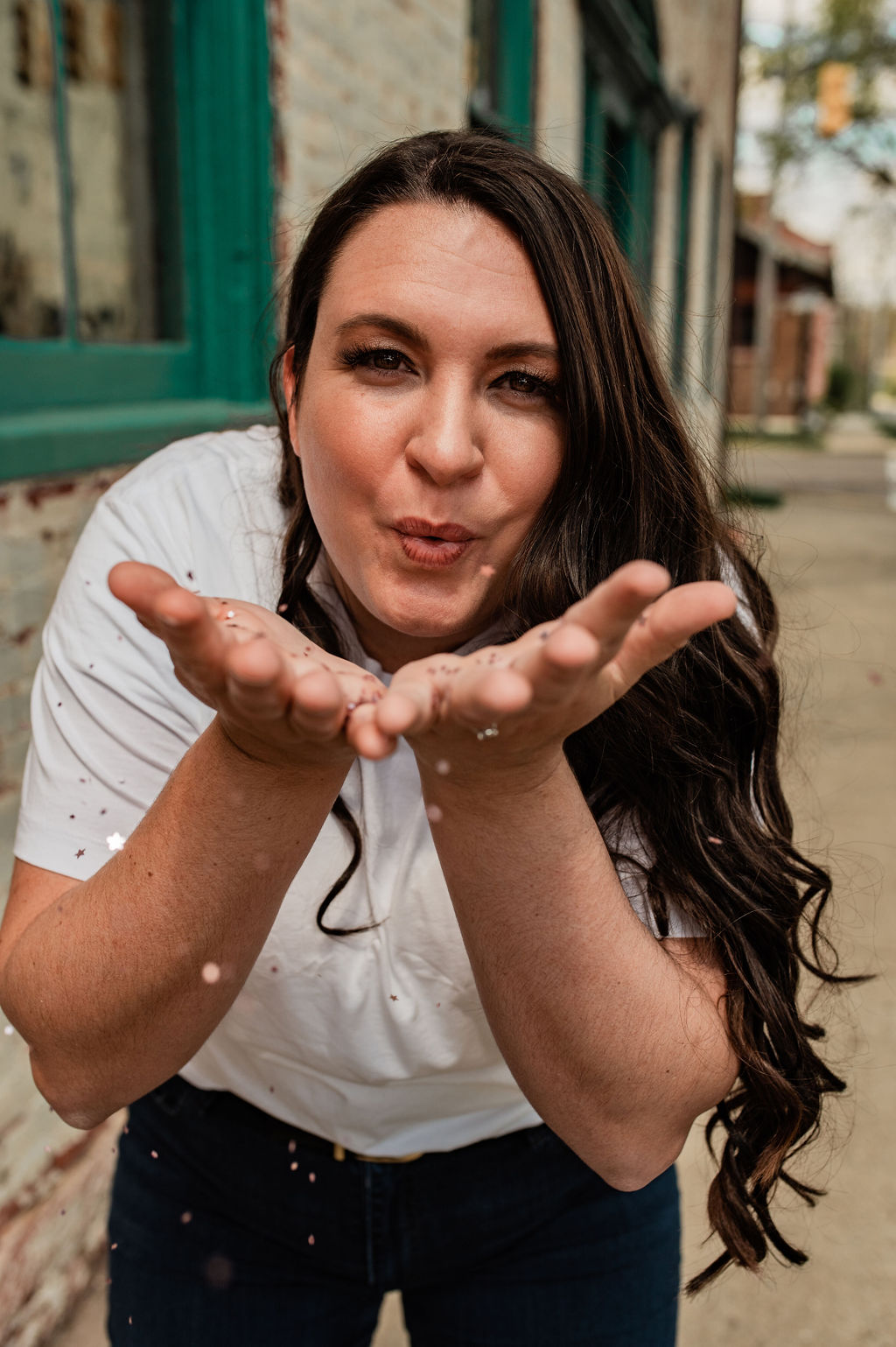
In episode 37 of The Podcast Podcast, I have Megan Yelaney joining me! Megan is a business coach that helps online coaches scale their business by identifying their unique standout method. She is also the host of The Pretty Awkward Entrepreneur podcast. I am so excited to have Megan joining me and sharing all about her story as well as her unique coaching methods that have gotten her massive success.
In case this is your first time tuning in, let me introduce myself. My name is Tara Counterman. I’m the founder and CEO of Profitable Podcast Productions, the creator of Profitable Podcast School and basically, 1000% obsessed with helping online entrepreneurs step out of the busywork, stop struggling for paying clients and actually get their message out there.
So if you’re ready to dive into this episode and hear more about Megan’s story and her top tips on how you can step into your zone of genius and authentic self, check out the points I share below! And for even more juicy details, listen to ALL of episode 37 of The Podcast Podcast on your fave streaming platform.
MEGAN SHARES HOW SHE GOT INVOLVED IN THE COACHING SPACE AND BECAME A BUSINESS COACH.

Megan got started with business back in 2012 through Network Marketing. She had joined a particular Network Marketing company and initially pursued it with a hobby mindset. She didn’t take it too seriously, but finally, something clicked when she attended an event. She realized she was sitting on a gold mine of opportunities. At this time she was complaining about her cocktail waitressing job and other jobs she’d do in between acting gigs. Megan says that she was pursuing acting at this time and a lot of her days were from 6:00 am to 9:00 pm doing things she hated. After that event, she finally treated her Network Marketing as a business. After about a year when she made that mindset shift, she was able to go full time and quit all her side jobs. Another year later, she made her first six figures with that Network Marketing company.
Megan realized she loved her business, but she knew she was meant to do something else. She went to school for marketing and had learned so much about social media through this Network Marketing company. But, she felt limited. After a while, she realized she couldn’t go out and attract certain clients or sell things she wanted to sell. This was when she realized she had to do her own thing. So she decided to go full in on her own business in 2017. In 2018, Megan focused on being a business coach. The rest is history! She shares that it’s been an incredible journey both financially and impact wise.
MEGAN ADMITS SHE WASN’T ALWAYS HER AUTHENTIC SELF, AND HOW SHE FINALLY STEPPED INTO IT.

I asked Megan more about how she learned to own her authentic and true self since this is such a huge part of her brand and success. Megan admits she wasn’t always so care-free and unapologetically herself! She shares that when she was involved with Beachbody, she tried to be like all the other top coaches. She wasn’t creating content or posting with the value behind it, she was simply doing what others were doing. I know for myself, I was so drawn to coaching industries as well from Network Marketing. I was also involved in Network Marketing companies like Megan, but I found that nothing ever felt quite right. Whenever I’d try to branch out and be creative, I would be shut down and told to follow along with my upline or what the company was doing. I can completely see Megan’s point here about that limiting opportunity to be yourself. It’s also easy to follow the crowd and do what the other top consultants are doing.
Megan does say that her Network Marketing business started to take off quite a lot more when she did own her authentic self. When she transitioned into health and fitness coaching, she couldn’t replicate the typical fitspo persona that many other coaches had either. She began to realize that you don’t have to do things like others to have a successful business. This was when Megan decided to leave that health and fitness industry to dive into business coaching instead.

LISTEN ON SPOTIFY | LISTEN ON APPLE PODCASTS | LISTEN ON GOOGLE PLAY
MEGAN’S ADVICE FOR THOSE WHO ARE STRUGGLING TO EMBRACE THEIR AUTHENTIC SELVES.
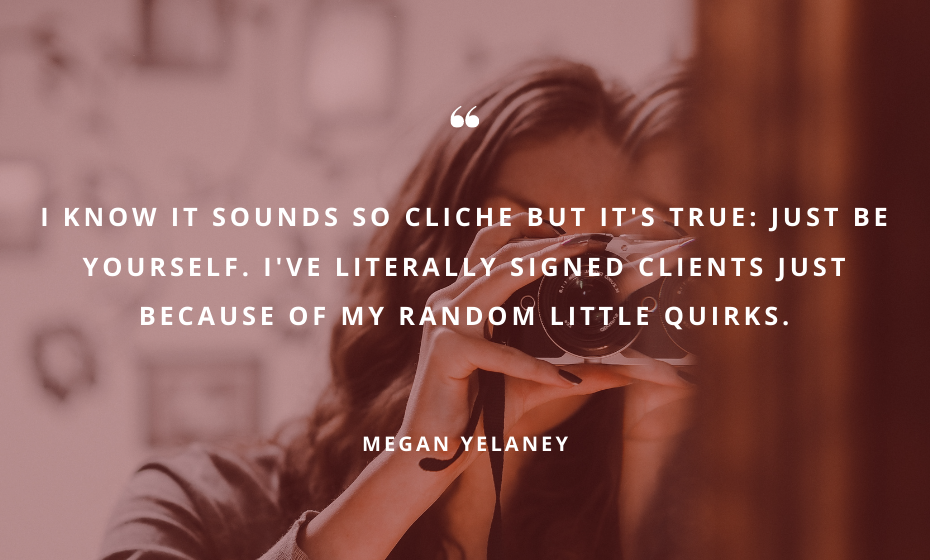
Megan points out to anyone who is struggling right now to embrace their authentic selves that it’s not an overnight process. Megan shares that it took about six months to finally start embracing herself. She says to give yourself some grace and take it slowly. Consider little things or weekly things you can start sharing with your audience that’s unique or different. Start thinking about ways you can build a connection to your audience! A lot of times we’re scared to put things out about ourselves and get judgment. You don’t have to get too personal, instead, share your interests. What TV shows do you like? What kind of music do you like? Share that with your audience.
Megan has implemented this even into her podcast, The Pretty Awkward Entrepreneur. She loves the name of it because she feels like it hones in on who she is. She also finds that the episodes that aren’t super planned or organized perform the best. She loves to be able to speak and share whatever comes to her mind. Over time, she’s found her podcast to be a great tool in growing her audience and attracting those ideal clients. She knows the success of her podcast is because of how authentic and genuine she is. It’s a great way to practice being authentic, speak what you have to say out loud. I know from experience as well, the best and deepest connections from podcasts come from exactly how Megan records her episodes. The more real and genuine you come off, the more trust your listeners will feel for you!
MEGAN BREAKS DOWN THE UNIQUE COACHING METHOD.
Megan says she’s been following a unique coaching method for years but never knew what to call it until recently. Once she sat down and realized that all these different coaches lead with a completely different style, she determined this concept to be a unique coaching method. Megan realized that there’s a difference between a coaching style and a niche. For example, you can be a business coach but also hone in on spiritual practices. You can still be within this category of coaching but add your special method. A unique coaching method is all about figuring out how you are different and determining what type of coach you are. The goal is to separate yourself from all the other coaches. Things to think about to determine this are analyzing what you do in your coaching container, thinking about the questions you ask your clients to inspire breakthroughs, as well as what strategy you take in your work.
By focusing on your strategy and how you approach your work, you will attract the right clients. This is what has helped Megan draw in her ideal clients. She’s also very vocal about this on every platform, from her social media to her podcast. She encourages everyone to do the same. The more open and vocal you are about your unique strategies, the more those ideal clients are going to come your way. It’s’ all about owning your method and how you do things differently. This also allows you to become an expert and known for something so specific. One of the biggest mistakes Megan sees other coaches making is the need to be good at all things. Instead, you should be focusing on the skills that come naturally to you. Rather than trying to be good at everything, make what you are good at EVEN BETTER. That is how you step into your zone of genius and authentic self.
STEPPING INTO YOUR ZONE OF GENIUS AND AUTHENTIC SELF WITH MEGAN YELANEY: THE BOTTOMLINE

I hope this episode was incredibly valuable for you all! Megan wraps up by mentioning that as you step into your zone of genius and own your authentic self, don’t stress about it. Instead, pay attention to what comes naturally to you and what lights up excitement for you. By being more self-aware you will develop your unique coaching method over time. Have fun with it and don’t rush the process!
So don’t forget to tune in to episode 37 of The Podcast Podcast to hear ALL the details about the points I just outlined above!
And if you love this episode as much as I do, don’t forget to take a screenshot, share it on your Insta stories and tag me @ceopwr so that we can spread this important message to even more entrepreneurs and online business owners!
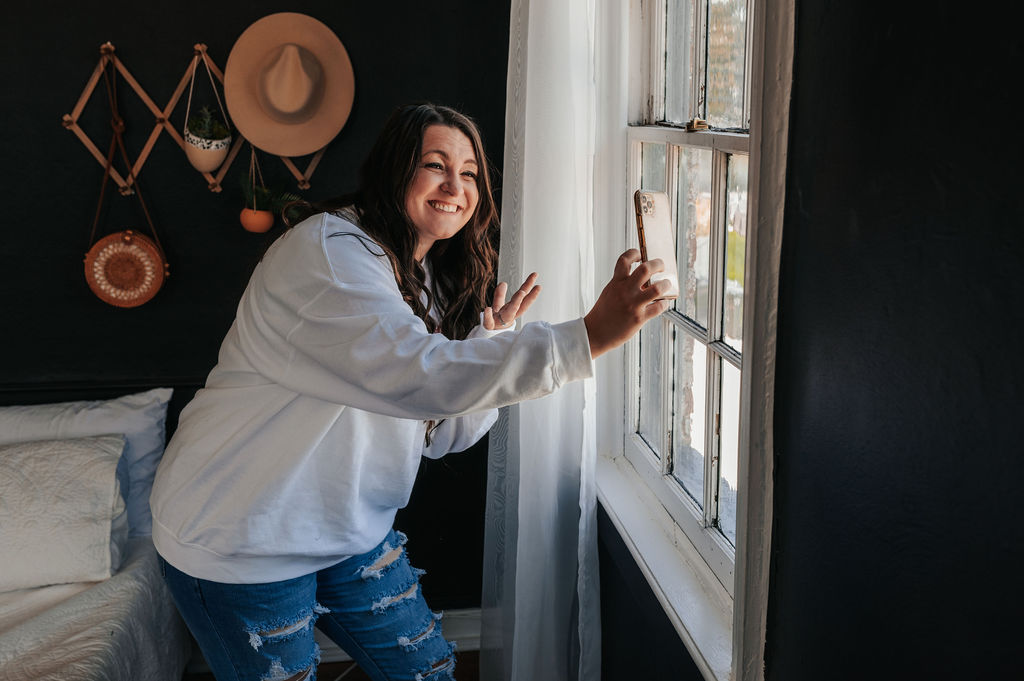
In episode 38 of The Podcast Podcast, I am giving you a sneak peek at Jeffrey Gitomer’s latest book, “Go Live”! Jeffrey and Jennifer both know the true power behind creativity and innovation. I am so happy to be a part of their breakthrough and to share some concepts and ideas that are in this book that’ll truly benefit all of you!
In case this is your first time tuning in, let me introduce myself. My name is Tara Counterman. I’m the founder and CEO of Profitable Podcast Productions, the creator of Profitable Podcast School and basically, 1000% obsessed with helping online entrepreneurs step out of the busywork, stop struggling for paying clients and actually get their message out there.
So if you’re ready to dive into this episode and hear more about the sneak peek on “Go Live” by Jeffrey Gitomer, check out the points I share below! And for even more juicy details, listen to ALL of episode 38 of The Podcast Podcast on your fave streaming platform.
MY PERSONAL EXPERIENCE BUILDING A SIX-FIGURE BUSINESS ON THE INTERNET

You and I are both living in a time in which innovation is your golden ticket to success and a time when technology creates opportunities. At the age of 18, I started my first business, which freed me from three retail jobs where I was working 90 plus hours a week. I picked up the entrepreneur bug and started learning how to leverage social media and the internet to sell products myself. I stumbled headfirst into podcasting but didn’t follow the usual pack. Instead of doing what everyone else does in the podcast industry, I asked myself, “Where is there room for innovation? Where can I make this an extremely effective space to connect with my audience?”, I questioned everything. Even as a college dropout, this mentality allowed me to build a multi six-figure business in just under a year and get the full picture.
The digital tools you have available as a business owner today are vast and far more superior for you as it was for me. The whole live digital and virtual game is shifting and you all have an amazing untapped opportunity. This opportunity allows you to learn how to leverage your time, creativity, and services to make a difference, all while finding financial freedom for yourself the same way I got mine. The key is you have to love what you do! Be willing to dive deeper and make mistakes, learn as you go. I learned all of this from Jeffrey, the king of sales himself.
WORKING WITH JEFFREY AND WHAT YOU WILL LEARN FROM HIS BOOK

I am never sure how the initial response is going to go when I deliver the news to someone about completely redoing the entire way they are using their podcast. Jeffrey and Jennifer knew the power of creativity and innovation, they understood the power of questioning the status quo to find a better way and take action. Weeks after our call, I would get messages from them referencing what we had worked through on our zoom. Big breakthroughs and shifts came through as we worked together in this new direction and we still continue to work better week by week. When you focus on your connections, numbers don’t matter. Popularity does not equal success. Always remember that! Jeffrey is going to teach you how to be the new rule in a world that has evolved more quickly than anyone could have imagined. If you master the concepts he shares in his book, you will be able to harness the power of social media, video, and podcasts. You’ll be able to sell from anywhere in the world, regardless of the number of followers you have. Go live with your vision and claim your version of success.

LISTEN ON SPOTIFY | LISTEN ON APPLE PODCASTS | LISTEN ON GOOGLE PLAY
THE REALITY BEHIND THE PROFITABLE PODCAST METHOD
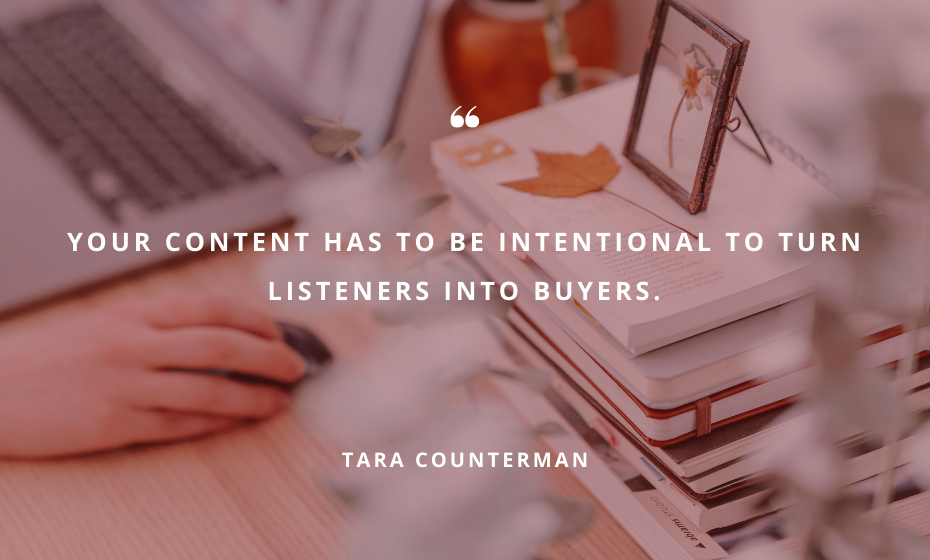
Time is the only resource that isn’t renewable for you so spend it on high-quality macro content. I will show you how to turn it into money making micro-content that works for you. The Profitable Podcast method was designed to get you off that hamster wheel and owning your valuable time. When I was evaluating what we did for our clients, I broke it down into five main categories. Purpose, plan, production, promotion, and profits. Each one of these pillars will not just bring you popularity, but it will produce sales and impact your bottom line. It is so important that you learn how to leverage macro content and this is what inspired Jeffrey’s book.
BREAKING DOWN THE 5 PILLARS
When podcasting for your business you must be focused on your purpose. Everything that you do for your show from naming, episode topics, formats, and ads needs to be focused around who your ideal clients are and the journey you are taking them on. When you know where you want to take them it makes it so much easier to get them there. Your content has to be intentional to turn listeners into buyers. It is imperative to know who you are talking to and what you are talking about. When you have your purpose clearly defined, you have to start focusing on your plan of action. Utilize your podcast as a tool to expand your reach and organize your process. You have to think about how you can take one piece of content and turn it into many.
The next pillar is all about production. Platforms are always evolving so if you want to step into a CEO role, get on the back end of your podcast. You want to be clear and sound professional but in no way does that mean you need to have a studio to record. Focus on your quality for your customers. The next pillar is promotion. This is where the process gets fun and allows you to work less while building relationships. The goal here is to build more relationships, nurture, and prime your listeners for what you offer. When you can master these things, podcasting will be the platform that keeps on giving. Podcasting can be a huge piece of your profit if you use the right strategy.
SNEAK PEEK FROM “GO LIVE” BY JEFFREY GITOMER: THE BOTTOMLINE

I hope this episode was incredibly valuable for you all! Jeffrey’s book was born to help you leverage the content in your business and I am so excited I got to share some points with you. I hope you take the time to master your podcast by following my five pillars to help you produce sales. If you’re looking to learn more about our services at Profitable Podcast Productions, click here.
Also, be sure to grab a copy of Jeffrey’s book, “Go Live!: Turn Virtual Connections into Paying Customers.”
Don’t forget to tune in to episode 38 of The Podcast Podcast to hear ALL the details about the points I just outlined above!
And if you love this episode as much as I do, don’t forget to take a screenshot, share it on your Instagram stories and tag me @ceopwr so that we can spread this important message to even more entrepreneurs and online business owners!
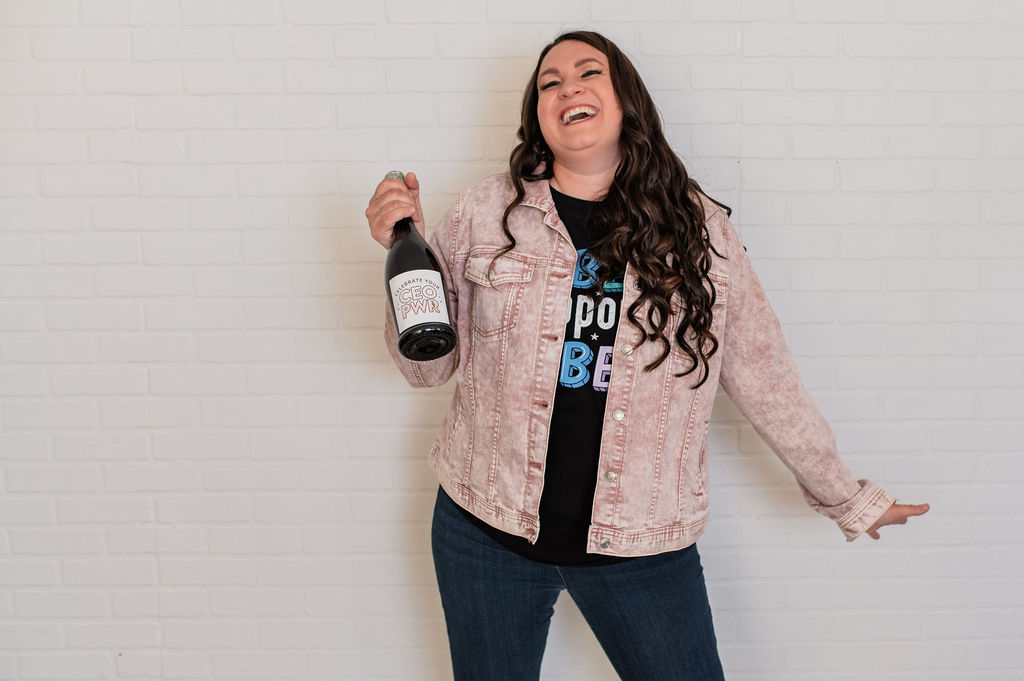
In episode 39 of The Podcast Podcast, I wanted to set the stage for you and share what could be possible with your very own podcasting platform. Whether it’s an idea or you’re ready to launch, knowing your intentions and knowing what is possible is going to help you this year. Today, I am going to be talking all about the strategies I used to book out my services in 2020!
In case this is your first time tuning in, let me introduce myself. My name is Tara Counterman. I’m the founder and CEO of Profitable Podcast Productions, the creator of Profitable Podcast School and basically, 1000% obsessed with helping online entrepreneurs step out of the busywork, stop struggling for paying clients and actually get their message out there.
So if you’re ready to dive into this episode and hear more about how I booked out my services last year, check out the points I share below! And for even more juicy details, listen to ALL of episode 39 of The Podcast Podcast on your fave streaming platform.
STRATEGY 1: MEETING THE NEEDS OF YOUR CLIENTS AND PROVIDING A GOOD EXPERIENCE.

When I sit down and look at why I booked out in 2020, the first reason is the client experience. Nothing else matters if you don’t have a high level of service and meet the needs of your client’s pain points. Your client’s experience should always be your focus. A year into my business, I started to dive into how we can make the client experience better. I asked myself what little things and processes are going to make the client feel more welcomed. I first started focusing on the client onboarding experience with different videos and pieces of training to help them get a better understanding and overall better experience. I even created a guided journal that I sent out to all our clients, where I invested a lot of my time, energy, and financial resources because I knew it would book us out as we moved forward.
I highly recommend making sure you are focusing on your client’s experience and what they are getting out of working with you. You have to understand that you can be a good salesperson but at the end of the day, if you’re not serving at the level that you’re selling, there is a major breakdown. This is something that is a huge problem in the podcasting industry. We are all becoming really good salespeople, but we have to think about how our service is going to be great. Once you nail your customer experience, then you can go in and focus on your content.
STRATEGY 2: BEING INTENTIONAL WITH YOUR CONTENT CREATION AND SPEAKING TO YOUR IDEAL CLIENT.
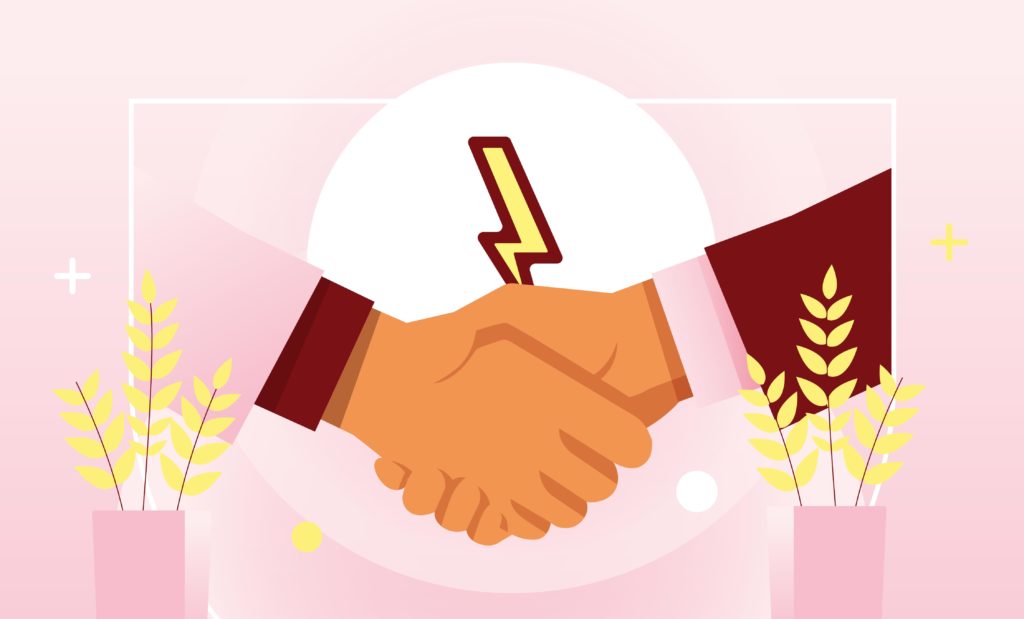
I know my community like the back of my hand, that is another reason why we booked out in 2020. I do so much market research that I know my client’s pain points, what they are struggling with, and how I can provide them with solutions. By knowing this, I can serve them content that is going to help them in some way, shape, or form. You have to know what your clients are struggling with and where they want to go so that you can create content around that. When I do that, I can position offers in front of them that will serve them at a high level. You want to always start with the longest form of content and then break it down from there. What I’ve done and what I teach my clients, is to map out what their community needs to see, hear, feel, and believe to say yes to their offer. When you get intentional about your long-form content, you’re able to step back and allow your team to step in so that you can stay in your zone of coaching, creating, and providing an innovative service. It is so important that you stay in that zone and create magic.
If you create micro-content over macro content, then you have to do everything. You have to write emails, posts, record, create offers, and create systems to support the offer. When we are able to step back and batch out content in a longer form, like a podcast for example, then your team is going to be able to support you. If you don’t have a team, you can still benefit. You just have to get clear and intentional on who you’re speaking to and why you’re speaking to them so that you can repurpose content. Once you create the big work, you can easily go in and break it down by yourself or with a team.

LISTEN ON SPOTIFY | LISTEN ON APPLE PODCASTS | LISTEN ON GOOGLE PLAY
FOCUS ON YOUR MESSAGE AND INTENTIONS IN 2021.
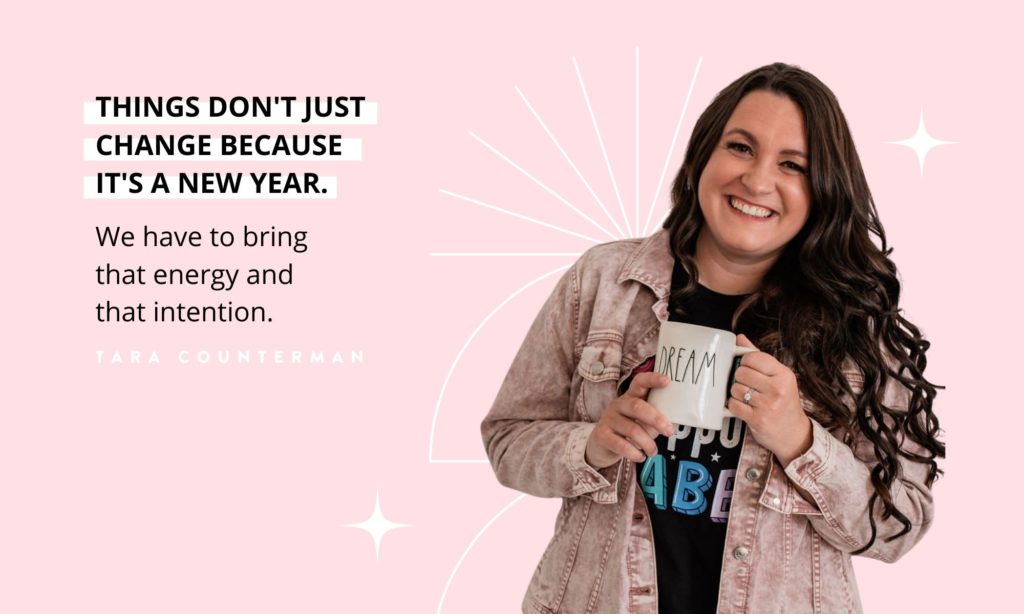
It can be easy to go week by week and keep the pressure on yourself. When you can focus and zoom out to see the bigger picture, you’re going to feel so much better about your show and all your content. The best part that I learned about batching is that you can literally apply this to every single thing in your business and your life. When I learned Focusing on client experience and content creation was seriously what helped me book out in 2020 and I want that for you too as we begin 2021! So, I have a little homework assignment to get you thinking. I want you to sit down and think about how long you are spending when it comes to content creation right now and what your process is like. I just want you to look at your overall process from brainstorming to writing to speaking and recording. Think about your flow and your routine. Ask yourself questions like how long it takes you to write an Instagram post and how long it takes you to create an image? When you break these things down, I challenge you to take two days to create epic content. Spend day one conducting market research on your social media channels and whatever your next offer is that you’re launching. Then I want you to create and batch four podcast episodes for your launch and use that batched content to create other content. When you create these four intentional episodes, you are priming your audience for your upcoming launch.
MY TOP TWO STRATEGIES TO GROW A BUSINESS TO FULLY BOOKED IN 2021: THE BOTTOMLINE
I hope this episode was incredibly valuable for you all! These two strategies are what genuinely helped me book out in 2020. Focusing on your clients’ experience and your content creation will benefit you and your business so much. I am so excited I got to share these strategies with you and I hope you use them to master your podcast.
Don’t forget to tune in to episode 39 of The Podcast Podcast to hear ALL the details about the points I just outlined above!
And if you love this episode as much as I do, don’t forget to take a screenshot, share it on your Instagram stories and tag me @ceopwr so that we can spread this important message to even more entrepreneurs and online business owners!
Are you on Clubhouse? If you are join us for an episode recap, Q&A, and interactive discussion to go deeper with me!! Even link & details through the link here.
Episode Resources:
Automatic Transcription Service
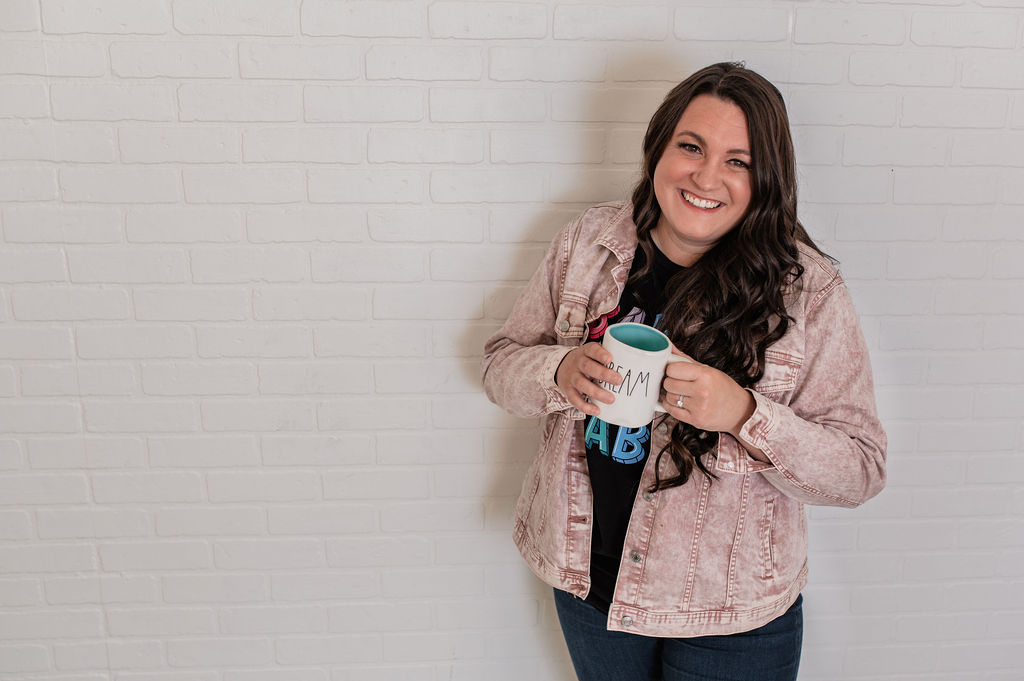
In episode 40 of The Podcast Podcast, I wanted to share with you guys some real-life examples about why batching is the greatest thing in the entire world. When you batch your content, you’re going to have so much more time on your hands. Today, I am going to be talking all about batching for your podcast and how to spend time getting in the zone!
In case this is your first time tuning in, let me introduce myself. My name is Tara Counterman. I’m the founder and CEO of Profitable Podcast Productions, the creator of Profitable Podcast School and basically, 1000% obsessed with helping online entrepreneurs step out of the busywork, stop struggling for paying clients and actually get their message out there.
So if you’re ready to dive into this episode and hear more about why batching is the greatest tool ever, check out the points I share below! And for even more juicy details, listen to ALL of episode 40 of The Podcast Podcast on your fave streaming platform.
A PERSONAL BATCHING STORY WITH MY HUSBAND AND I.

My husband and I love spending time in the kitchen whether that is cooking or baking. Sometimes we will take on a little bit more than we can chew, especially when days are really busy. Over the summer we were getting a lot of zucchini in our garden and we weren’t eating them fast enough. So, we decided to take a day and batch a whole bunch of zucchini lasagnas. We got our ingredients and made nine zucchini lasagnas. This was great and we thought about doing this more often because there are days where we are really busy and we were able to pull a zucchini lasagna out of the fridge to bake it. We wanted to figure out how else we can do this but of course, like anyone, it takes more than one time to learn something. I started to realize that what we were doing was literally just batching. I was doing what I preach in all my content creation tips but this time just in the kitchen.
WHY BATCHING IS THE GREATEST GIFT.

Batching is one of the best things you can do for yourself because it means more time. For example, when I make a loaf of bread, I have to get all the ingredients together before making it. In your podcast, this is just you getting your mic setup and getting your ideal recording situation ready if you do voice warm-ups. If you have talking points, you have to prepare that or if you’re recording with video, you have to get that ready. When you can batch, you’re able to save more time and create way less work for yourself. If you’re doing the editing, you can sit down and edit multiple videos at once so that it is done in one day and not four days. It takes time to mentally check in to a task and every time we switch tasks, we lose about 15 minutes of focused work time. I believe that when you create batched content, it’s a lot more intentional. You can really look at all your offers, your services, and what it is that you want to focus on creating and selling.

LISTEN ON SPOTIFY | LISTEN ON APPLE PODCASTS | LISTEN ON GOOGLE PLAY
THE BEST PART ABOUT BATCHING.
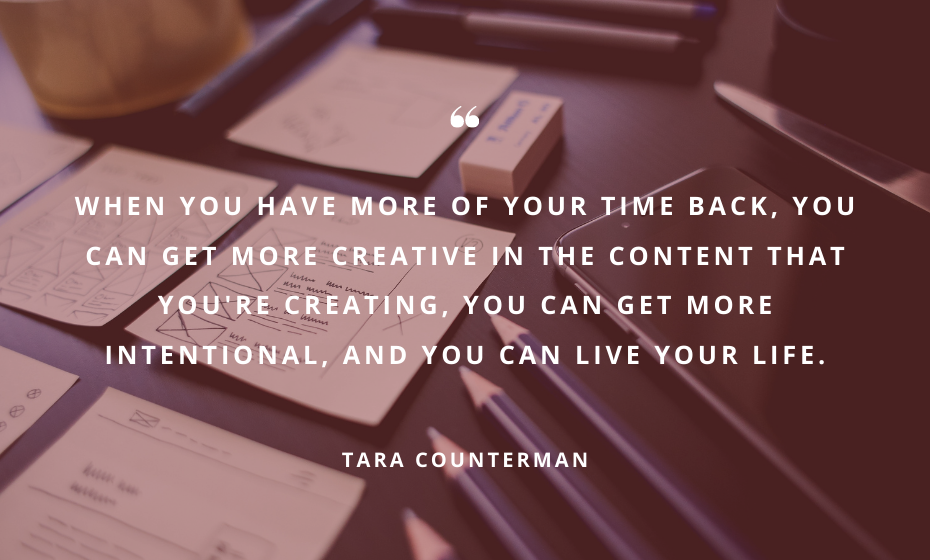
It can be easy to go week by week and keep the pressure on yourself. When you can focus and zoom out to see the bigger picture, you’re going to feel so much better about your show and all your content. The best part that I learned about batching is that you can literally apply this to every single thing in your business and your life. When I learned about batching, I batched everything I could, whether it was errands or laundry, it saved so much time. It’s the little things that can give us more of our time back just by batching. When you have more of your time back, you can get so much more creative in the content that you’re creating, you can get more intentional, and the best part – you can get your life back.
WHY BATCHING CONTENT IS THE GREATEST THING FOR YOUR BUSINESS: THE BOTTOMLINE

I hope this episode was incredibly valuable for you all! I want you to give batching a shot and stay consistent with it. You won’t see major results in your freedom in the first month, it’s going to take some time but I promise it’s worth it. I am so happy I got to share the idea behind batching with you and I guarantee that if you spend time batching your content, you are going to feel so much better and it’s going to be more holistically integrated into your podcast show.
Be sure to join me as I discuss all things batching on January 21st in Clubhouse!
Don’t forget to tune in to episode 40 of The Podcast Podcast to hear ALL the details about the points I just outlined above!
And if you love this episode as much as I do, don’t forget to take a screenshot, share it on your Instagram stories and tag me @ceopwr so that we can spread this important message to even more entrepreneurs and online business owners!
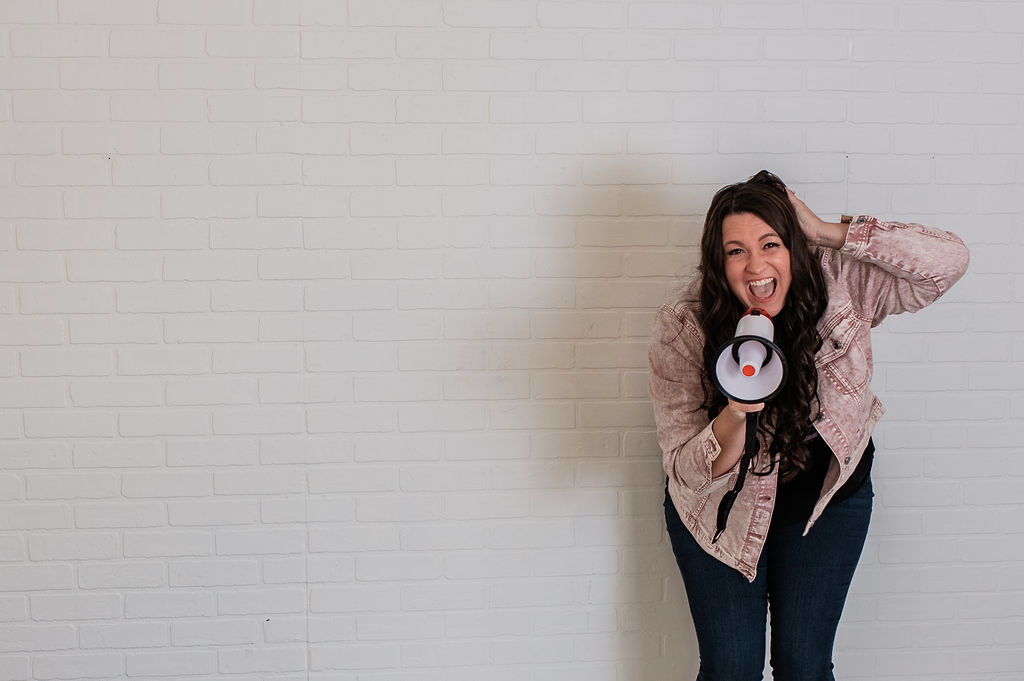
In episode 41 of The Podcast Podcast, we are talking all about leveraging freebies in your podcast. This is one of my favorite strategies when it comes to helping clients utilize their podcast holistically in their business. Today, I am going to be talking all about what freebies are and how to incorporate them into your business!
In case this is your first time tuning in, let me introduce myself. My name is Tara Counterman. I’m the founder and CEO of Profitable Podcast Productions, the creator of Profitable Podcast School and basically, 1000% obsessed with helping online entrepreneurs step out of the busywork, stop struggling for paying clients and actually get their message out there.
So if you’re ready to dive into this episode and hear more about why freebies can help support your launches and podcast, check out the points I share below! And for even more juicy details, listen to ALL of episode 41 of The Podcast Podcast on your fave streaming platform.
WHAT A FREEBIE IS AND HOW TO MAKE THEM IMPACTFUL.

A freebie is something that you can use to provide to your community in exchange for an email, phone number, or any information that you could use to market to them. They help you build your email list and having multiple places where you can connect with your audience is so important. What I love about an email list is you are the only one that owns that list. This is one of my favorite strategies for clients because it allows them to holistically integrate their launches into their business.
Freebies can be very impactful especially when you use them in your podcast. There are a lot of different strategies you can do when it comes to freebies. You can create a freebie, download, worksheet, or quiz and these are all really awesome if you have the time and space to do that or have a team to help. You can also be intentional with a very specific freebie for each launch and run that freebie ahead of time before you start running your ads for your webinar or series.
WHY SELF-QUALIFICATION IS AN IMPORTANT TOOL.

One of the most powerful tools in sales is self-qualification because you can talk to people but unless they are in a place where they see it and hear it they’re not going to do anything different. They have to take action. They have to have something that helps them qualify that they have the problem you can solve. If you can give your buyers a quick win, that’s going to benefit you in your sale process down the road. Usually, when a client wants to launch, we develop content that will prime their ideal audience to say yes to their offer. Through that content, the ad that we put in those episodes is the freebie that’s going to help them self qualify that they have a problem and need a solution. A freebie is a great place to give ideal clients a quick win. You know the people who interacted with those freebies are going to be interested and have to start to self-qualify.

LISTEN ON SPOTIFY | LISTEN ON APPLE PODCASTS | LISTEN ON GOOGLE PLAY
WHERE TO PUT FREEBIES.
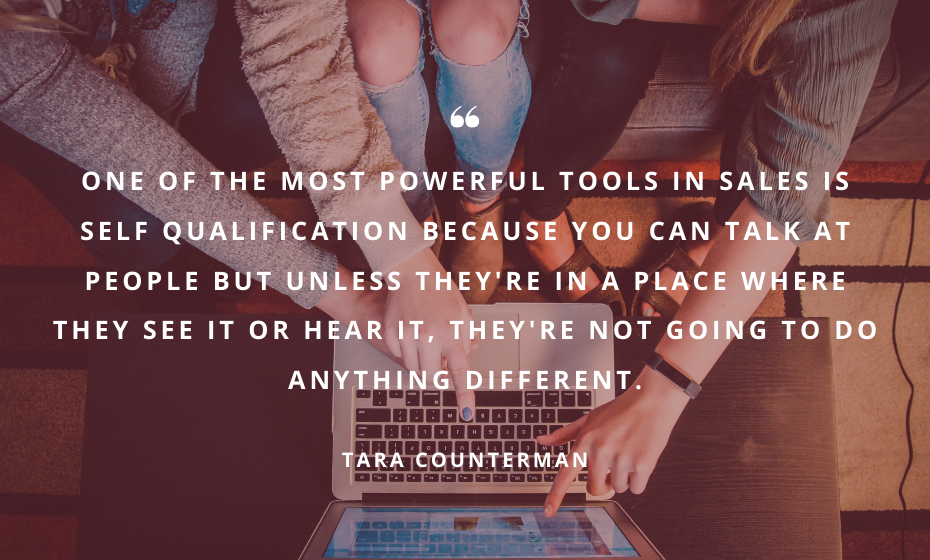
You can put your freebies in your show notes and decisions but you can also create ads that go in the middle of episodes. The middle of the episode is the best versus the beginning or end because when you listen to a podcast no one wants to go into an episode super excited and hear an ad. Have our clients serve through the first part of the episode, then place the ad in the middle, and then they can serve more at the end. The reason we do this is very intentional because we don’t want them to be hit with it at the beginning of the episode. A lot of people start podcast episodes but don’t finish them because they’re always on the go. By putting it in the middle, we’re increasing our chances that more people will see it.
HOW TO PROMOTE FREEBIES IN YOUR PODCAST TO SUPPORT YOUR LAUNCHES: THE BOTTOMLINE

I hope this episode was incredibly helpful for you all! I really wanted to bring it to your attention that you can always leverage those awesome freebies that you’ve created, especially in the sense of how they relate to your launch. Don’t just create a freebie, put it out there, and then do nothing with it. I want you to get really intentional with the way you’re using those leads for the benefit of your business. Don’t forget to tune in to episode 41 of The Podcast Podcast to hear ALL the details about the points I just outlined above! And if you love this episode as much as I do, don’t forget to take a screenshot, share it on your Instagram stories and tag me @ceopwr so that we can spread this important message to even more entrepreneurs and online business owners!

In episode 42 of The Podcast Podcast, I have Ariel Schiffer joining us, who is the incredible CEO, founder, and total brains behind Dream Pro. Today, we are going to be talking about how Ariel got to where she is today and how to create online courses that will attract and serve your dream clients! In case this is your first time tuning in, let me introduce myself. My name is Tara Counterman. I’m the founder and CEO of Profitable Podcast Productions, the creator of Profitable Podcast School and basically, 1000% obsessed with helping online entrepreneurs step out of the busywork, stop struggling for paying clients and actually get their message out there. So if you’re ready to dive into this episode and hear more about attracting those dream clients and giving them a major transformation, check out the points I share below! And for even more juicy details, listen to ALL of episode 42 of The Podcast Podcast on your fave streaming platform.
ARIEL’S STORY AND HOW SHE GOT TO WHERE SHE IS.

Ariel started her career working in corporate America, where she focused on developing training programs for professional and leadership development. Her whole career was focused on making learning interesting and far from boring so it was a very creative environment for her. After working in corporate America for over 10 years, she soon realized that she didn’t want to work for someone else anymore because deep down she knew that she was meant to be on her own. That’s when she started her own business as a career coach. She purchased a course that she thought would help her. When she entered the course, she was let down and realized that the content creation industry needed her. That’s what transitioned her into being the go-to person for helping entrepreneurs with done for your courses, course creation, and just providing them with useful resources that can help them create their courses.
WHY BEING INTENTIONAL IN YOUR PURPOSE IS IMPORTANT.

When talking about online course creating, Ariel says that you have to make sure that you’re not just unloading all your information on somebody. You have to have an intentional purpose behind what you do and look at it from different perspectives. When people take courses, they look at the aesthetics so pay attention to your visuals. You also have to look at it from other instructional design methodologies and look if the product is going to provide a transformation. It’s not just about giving everybody what you know, it’s more about making sure that they get the transformation that you promised at the beginning of the course. The point behind a course and why people create things that are self-led is to be able to help people complete a task and shift their mindset.
Even when you are intentional in your course creating, it’s possible that some things won’t go as planned. When that happens, it’s nothing to be ashamed of. That’s right there is your opportunity to step up and realize that you just learned so much more about your audience and what you need to do now. Ariel stresses that we shouldn’t take it personally, instead we should look at it as data. Sometimes we get so tied to things, we’re unable to see the bigger picture but it’s not about being an expert, it’s about the impact that you’re making.

LISTEN ON SPOTIFY | LISTEN ON APPLE PODCASTS | LISTEN ON GOOGLE PLAY
THE BEST WAY TO CREATE CONTENT AND CREATE PRODUCTS.
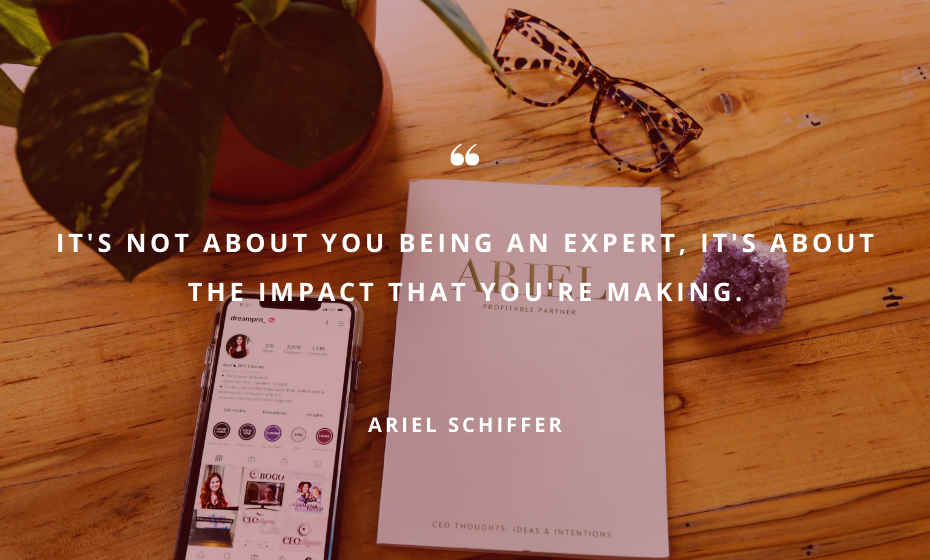
You have to know your audience! Knowing your audience will help create solutions that make sense for them. If you know that your audience are avid podcast listeners who are always on the go, then take that and make your content into an audible form. The best way to create content that actually helps your client is not forcing them into containers but instead giving them the transformation that they need in a way they are receptive to. Ariel says that you can’t build a successful business if your clients aren’t getting results. If your course isn’t providing the transformation, it doesn’t matter how good at sales you are, eventually that’s going to catch up. Another way to create courses in a super effective way is continuously update your course every six months so that you can give your audience updates. It is super in integrity to provide your audience with the most up to date information.
HOW TO CREATE ONLINE COURSES THAT ATTRACT AND SERVE YOUR DREAM CLIENTS, WITH ARIEL SCHIFFER: THE BOTTOMLINE

I hope this episode was incredibly valuable and eye-opening for you all! I want you to take all these points from Ariel and integrate them into your business if you want to experience massive massive growth. Create online courses that feel right to you and give your audience and dream clients that transformation they want and need! Don’t forget to tune in to episode 42 of The Podcast Podcast to hear ALL the details about the points I just outlined above! And if you love this episode as much as I do, don’t forget to take a screenshot, share it on your Insta stories and tag me @ceopwr so that we can spread this important message to even more entrepreneurs and online business owners!
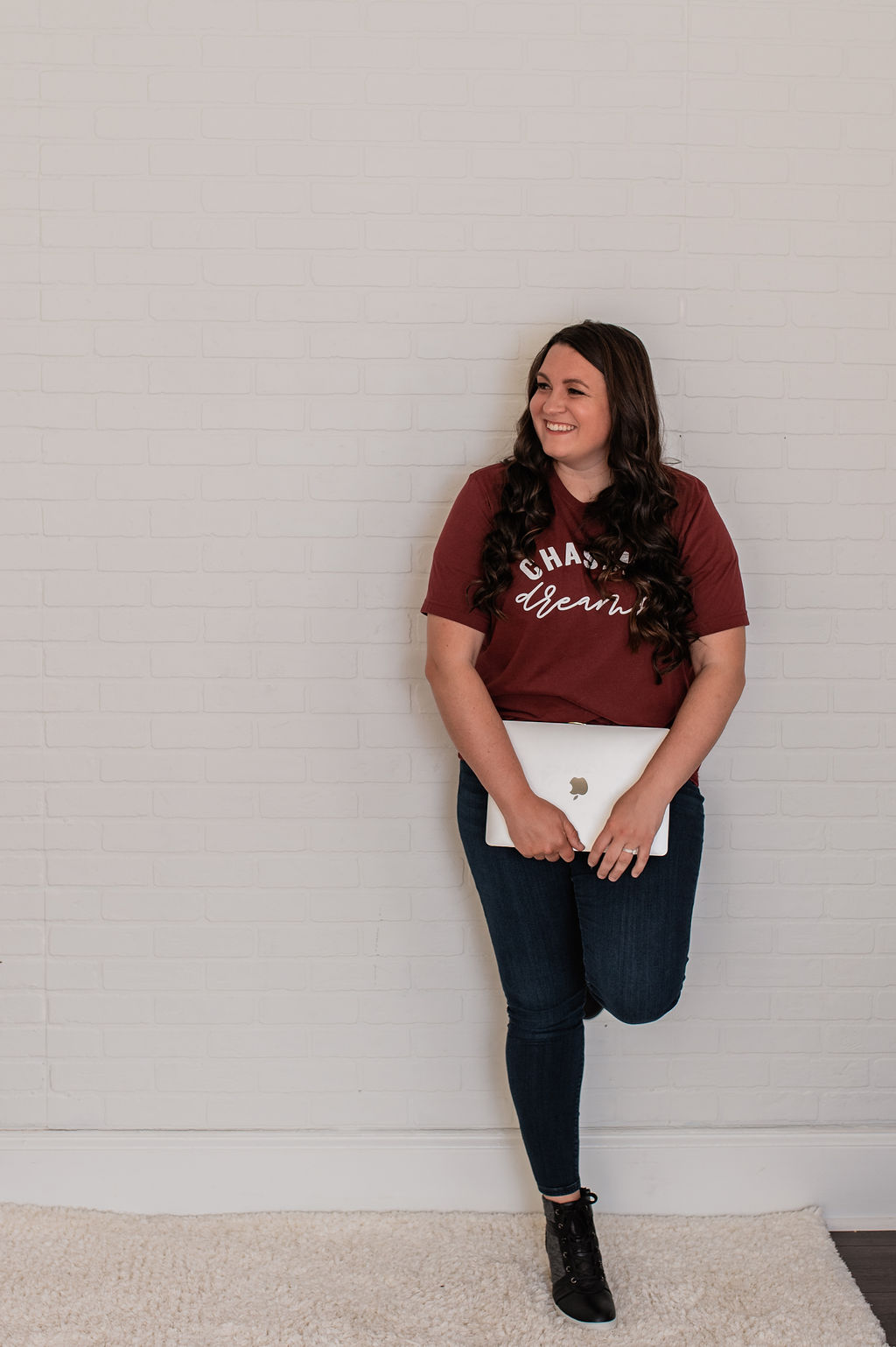
In episode 43 of The Podcast Podcast, I am joined by Kristin Molenaar to talk all about how you can leverage guest interviews to grow your business. Kristin is an entrepreneur enthusiast who lives by the mantra: Work less, Make more. This has enabled her to build a 6 figure business while only working about 5 hours a week. She is also the CEO and Founder of YesBoss Va where they help mission-oriented entrepreneurs generate leads and establish themselves as Thought Leaders through strategic podcast guest outreach.
I am super excited to have her on this episode and show you guys how to leverage your podcast guest interviews!
In case this is your first time tuning in, let me introduce myself. My name is Tara Counterman. I’m the founder and CEO of Profitable Podcast Productions, the creator of Profitable Podcast School and basically, 1000% obsessed with helping online entrepreneurs step out of the busywork, stop struggling for paying clients and actually get their message out there.
So if you’re ready to dive into this episode and hear more about how you can grow your business through guest interviews, check out the points I share below! For even more juicy details, listen to ALL of episode 43 of The Podcast Podcast on your fave streaming platform.
HOW KRISTIN GOT INVOLVED WITH HELPING ENTREPRENEURS LAND HUGE PODCAST GIGS.
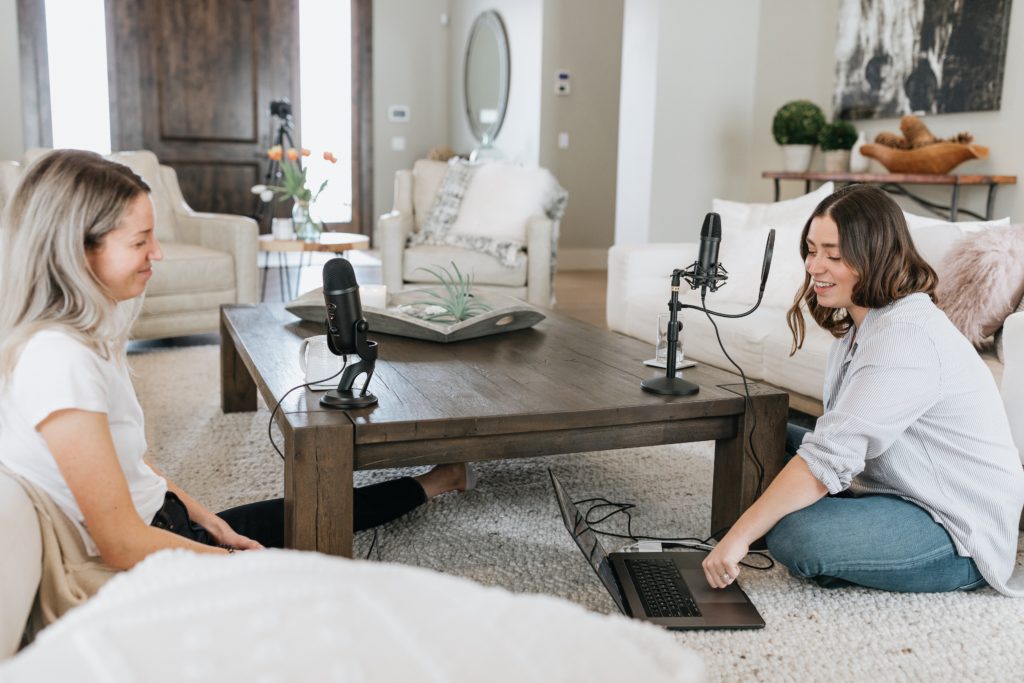
After struggling as an employee for 14 months, Kristin decided to become a virtual assistant mainly because she didn’t want to sacrifice her freedom, which is understandable. She started getting VA gigs, but couldn’t get herself to take off that entrepreneur hat. Because of this, she turned her job into an agency and in 2018, she built it up to six figures. She was very intentional when it came to building her team up because she wanted people that could provide a good service to her clients. She told her team that she wanted to go out and start talking on podcasts because she saw a huge difference between a struggling entrepreneur and a successful entrepreneur. She experienced both journeys herself and saw some major differences between the two.
When she got gigs, she felt like she was becoming a “wannabe guest” and not doing what she planned to do. Her team then took over for her and she started guesting like crazy – and loved it! She loved showing up and sharing her experiences. When she looked at the results of episodes that were airing, she and the team saw that it was the most profitable lead generation strategy to date. They started doing it for their clients and saw that guest interviews are an incredibly powerful strategy to get your message out there and connect with a larger audience. When she started to niche down, they realized they have to double down and start helping clients get booked on podcasts as guests.
THE BEAUTY OF TREATING YOUR BUSINESS LIKE A BUSINESS.

Kristin didn’t want to keep all the money for herself. She didn’t want to do all the tasks and had to hire people to help her write her blogs, etc. She needed to treat her business like a business. A lot of times, people start their own business and hoard all the tasks because it’s something they love. The beauty about treating your business like a business is that you can design your role in that company. When you can design your role in the company, you’re willing to bring other people in to help you fill the other roles. It’s super fulfilling because you get to do what you love, but only do the parts of your business that light you up. You have to be intentional about where you position yourself in your business.
WHAT IT MEANS TO BE A PODCAST GUEST.
To Kristin, being a podcast guest is not about your name or audience size. What’s important is meeting a host that you have genuine synergy with. Meeting new people is what it’s all about! New people can help bring value to your business and you can even create relationships that will last a lifetime. Being a guest is all about relationship building and showing up as genuine as possible to serve that person. When people go after the “big audiences” they probably won’t have as big of an impact because they already have so many people in their circle that probably already do what you do. Kristin explains that she doesn’t dismiss newer podcast hosts. New podcast hosts are some serious business owners who are super ambitious. It’s not about going after the hosts with the vanity metrics because there are people out there that are more open to building a connection with you and creating a relationship over time. Vanity metrics don’t serve your bottom line!

LISTEN ON SPOTIFY | LISTEN ON APPLE PODCASTS | LISTEN ON GOOGLE PLAY
KRISTIN SHARES THE FORMULA BEHIND SHOWING UP WITH INTENT TO GUEST INTERVIEWS.
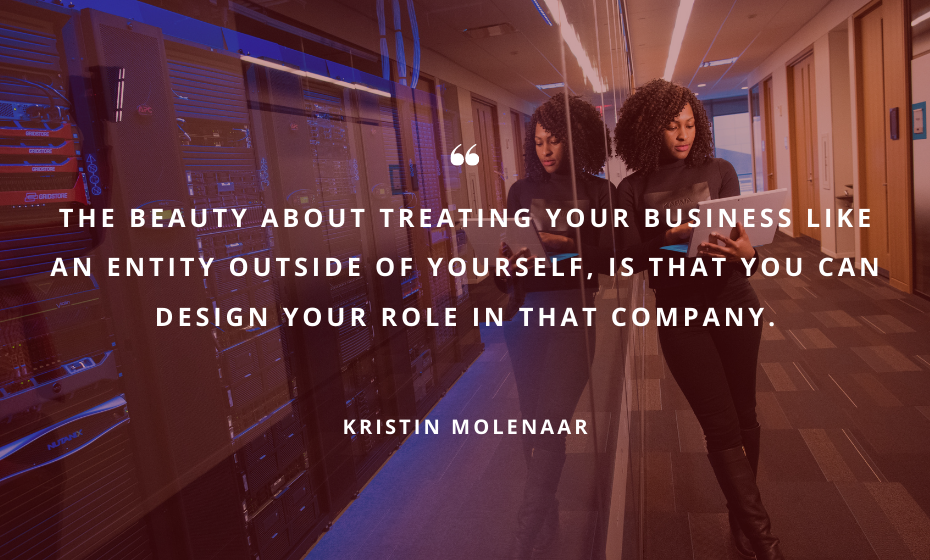
Kristin shares that the first phase to any intentional guest interview is through up-front prep work. When you are thinking about being a podcast guest you have to know exactly what you do, how you monetize your business, and how you bring actionable strategies and talking points to the table. This is the first part of really standing out as a podcast guest. In the talking points her team creates, she wants to make sure they are relevant and her clients are not just talking about something that doesn’t matter to somebody. As a service provider, Kristin puts all her cards out on the table. During an episode, it’s all about your methodology, sharing secrets, and being vulnerable by not holding anything back. There should be no cliffhangers – just answer the question and give it to them straight. She feels like sharing everything and being upfront with all her methodologies has helped her eliminate any bad clients. Just get out there and share everything you know to attract people that are of much higher quality to your business.
YOU ARE NOT GOING TO GET A RESPONSE FROM EVERY SINGLE HOST, AND THAT’S OKAY!
You are not going to get a response from every single person you send a pitch to. It has nothing to do with you and how awesome you are, it is simply a numbers game. Kristin shares that you’re not going to get a yes from everybody and that is okay! That just means it wasn’t the right fit anyway. The ones that do say yes are the ones you’re meant to go towards. This is all part of the process. A good tip Kristin gives is to look for new podcast hosts because they are always looking for guests. You’re going to get a lower response rate from the people who are more established because you’re trying to cut through and stand out among so many other pitches. With newer podcast hosts, you’re going to get a lot more promotion. If you look at bigger podcasts, there is no promotion at all. Someone newer is going to share your name so much more on social media posts. One of the things you can do to stay on somebody’s radar is to show up on their social media and sign up for their email list. Reply to their emails and tell them how much value you got from that email. Create connections with other hosts!
HOW TO LEVERAGE PODCAST GUEST INTERVIEWS TO GROW YOUR BUSINESS WITH KRISTIN MOLENAAR: THE BOTTOMLINE
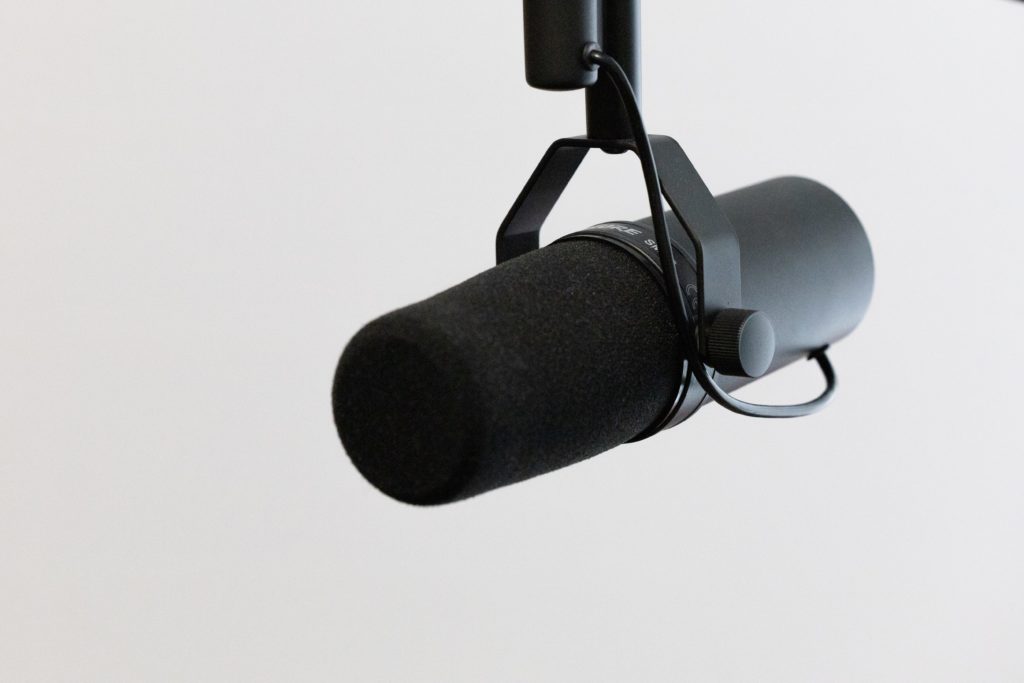
I hope this episode was incredibly valuable and helps you leverage podcast guest interviews more effectively! Keep putting yourself out there with genuine and real content. Show up, serve, and impact as much as you can. It is so important to enjoy what you’re doing so that you can build a profitable business!
Be sure to connect with Kristin over on her LinkedIn and check out her Masterclass to start increasing your visibility through podcast guesting!
Don’t forget to tune in to episode 43 of The Podcast Podcast to hear ALL the details about the points I just outlined above!
And if you love this episode as much as I do, don’t forget to take a screenshot, share it on your Instagram stories and tag me @ceopwr so that we can spread this important message to even more entrepreneurs and online business owners!

In episode 44 of The Podcast Podcast, we are talking all about how you can leverage your content to further nurture and prime your audience. With podcasting, people are always looking to connect on a deeper level. Today, I am going to discuss why that is and why you have to constantly be seen for your content to be working for you!
In case this is your first time tuning in, let me introduce myself. My name is Tara Counterman. I’m the founder and CEO of Profitable Podcast Productions, the creator of Profitable Podcast School and basically, 1000% obsessed with helping online entrepreneurs step out of the busywork, stop struggling for paying clients and actually get their message out there.
So if you’re ready to dive into this episode and hear more about leveraging your content for the benefit of your audience, check out the points I share below! And for even more juicy details, listen to ALL of episode 44 of The Podcast Podcast on your fave streaming platform.
WHY YOUR CONTENT IS CONSISTENTLY WORKING FOR YOU

The amount of exposure it takes to really understand someone’s methodologies and to feel connected to them takes a long time, especially when it’s written content. We’ve seen this with the Clubhouse app and even with podcasting. The trend is continuing to grow and it’s important to realize that it’s not just because people are hyping it up. It’s because people feel connected to these certain social media platforms and they have an attachment to the content that is put out on them.
CREATING AN EFFECTIVE NURTURE SEQUENCE
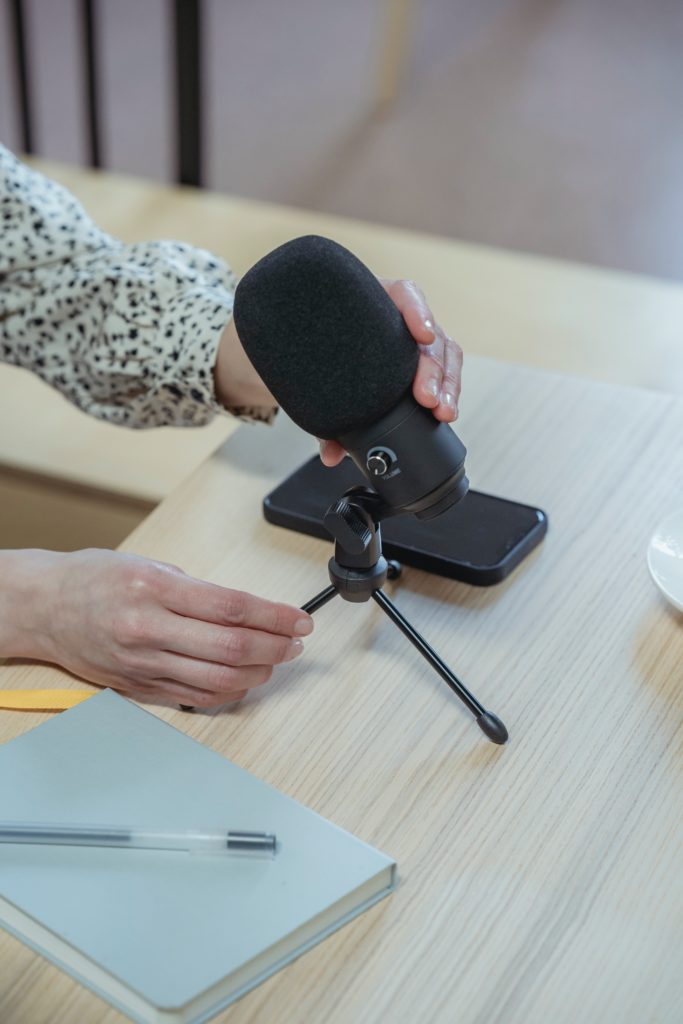
I highly recommend trying to grow your email list. At any moment, Mark Zuckerberg can delete your Facebook, at the end of the day, you don’t own that content. Therefore, you need to make sure that you are building a list of different ways that you can get in touch with people, especially your audience. When you have an email list, you’ll be able to serve and nurture your ideal clients there. An email list is not to just blast random things out now and then. Treat your email list like another social media platform. What you can do is drive people from your email list to your podcast episodes, but you have to give people a reason to subscribe to you and follow your emails first. You should put out high-value offers that solve your ideal client’s pain points. You want to offer them a transformation where they will feel valued and begin a customer journey.

LISTEN ON SPOTIFY | LISTEN ON APPLE PODCASTS | LISTEN ON GOOGLE PLAY
HERE ARE A FEW EXAMPLES OF GREAT OPT-INS THAT OFFER A HIGH-VALUE TO ATTRACT PEOPLE INTO JOINING YOUR EMAIL LIST!
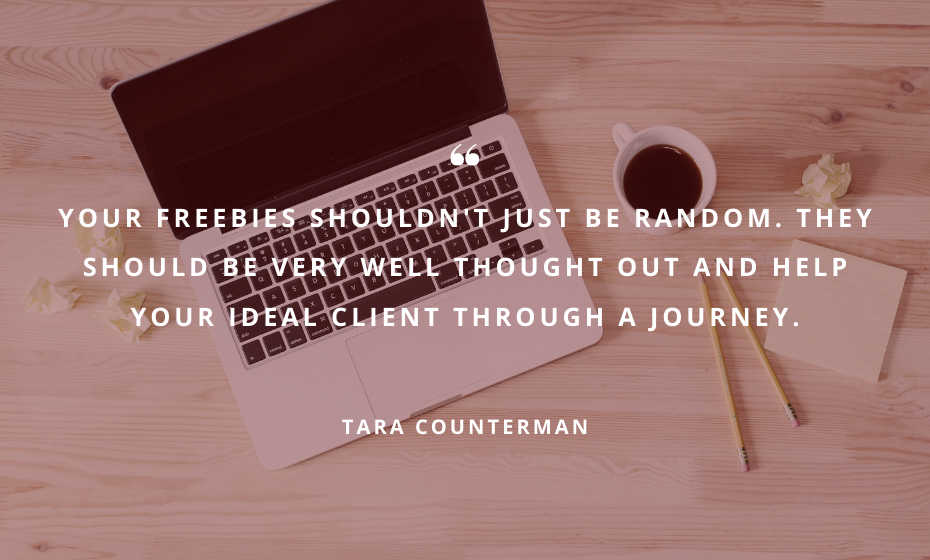
Example #1 – Instagram DM Freebie
This is a great one from Taylor Slango! Instagram is one of the most popular social platforms and with that in mind, this lead magnet is offering a solution to MANY problems. At a free value, it’s a no-brainer.

Example #2 – Monthly Tax Deadline and Bookkeeping Reminders
Another perfect example of an appealing freebie that’s very honed in on a solution to a problem. Katie Ferro does a great job of targeting her audience and offering a solution to a common pain point that most of them face.

Example #3 – Find Your Unique Coaching Method Masterclass
Megan Yelaney does a great job here with this freebie! She’s targeting a problem with her audience and offering a solution (see a pattern here?), not only that, she clearly defines what you’ll be getting from this freebie and the transformation.

With these examples in mind, remember that freebies should not be random. They should be thought out very well and help your ideal client through a transformation. This is going to help build and foster your relationship with your audience and build credibility. Pull people in with your emails by linking podcast episodes or creating a call to action so they are interested in finding out more!
WHAT TO DO IF YOU ALREADY HAVE A FREEBIE.
If you have a freebie, I want you to evaluate your nurture sequence, elevate the podcast episodes you already have, and create episodes that will help build relationships. Once you create those types of episodes, you can link them right into your email nurture sequence with a strong call to action. Don’t forget, these are people who have never met you but they’re going to be able to get massive value from your content. When you can warm them up in their inbox, they’ll get to know you better and become loyal fans. This is great because when you launch something, you will already have people who know and trust you! They’ll be ready to invest time into you.
USING YOUR PODCAST IN YOUR NURTURE SEQUENCE: THE BOTTOMLINE
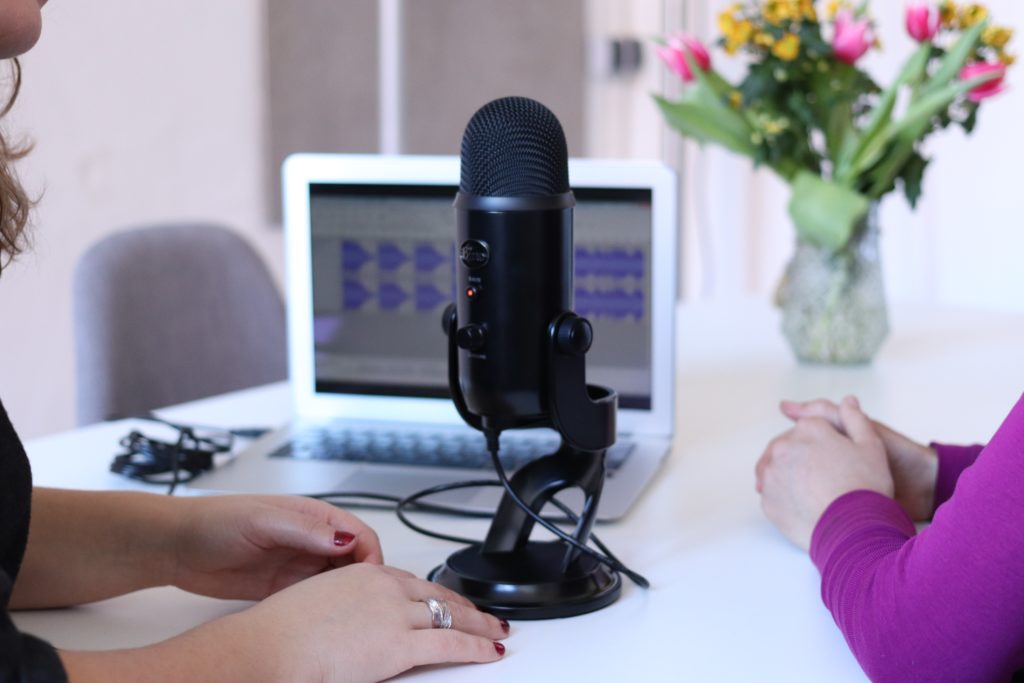
I hope this episode was incredibly helpful for you all! If you don’t have a freebie, your assignment is to look at your customer journey/feedback and create a freebie. For example, you can create a training, a masterclass, or a planner. Don’t be afraid to get creative and think about what is really going to help your ideal client take that first step. I hope this episode brought awareness to all the things you can leverage in your business that will help convert people into clients.
Don’t forget to tune in to episode 44 of The Podcast Podcast to hear ALL the details about the points I just outlined above!
And if you love this episode as much as I do, don’t forget to take a screenshot, share it on your Instagram stories and tag me @ceopwr so that we can spread this important message to even more entrepreneurs and online business owners!

Do you dream of launching a podcast to connect to your community? Ready to leverage long-form content for sales? Or have a podcast now but don’t think it’s working for you the way it could be?
In episode 45 of The Podcast Podcast, we are joined by Jen Gitomer to talk about all things profitable podcasting and give you the best sales tips! Jen has been obsessed with selling and sales her whole life and she’s sharing her story, advice, and how to search for the right opportunity. So stay tuned!
In case this is your first time tuning in, let me introduce myself. My name is Tara Counterman. I’m the founder and CEO of Profitable Podcast Productions, the creator of Profitable Podcast School and basically, 1000% obsessed with helping online entrepreneurs step out of the busywork, stop struggling for paying clients and actually get their message out there.
So if you’re ready to dive into this episode and hear more about the simple steps to profitable podcasting, check out the points I share below! And for even more juicy details, listen to ALL of episode 45 of The Podcast Podcast on your fave streaming platform.
WHAT TO LOOK OUT FOR WHEN STRUGGLING WITH SALES IN THE ONLINE SPACE.

Jen explains that there is this fear of making an offer and then becoming flooded with self-doubt. People think about things like, “What if no one buys from me?”, “What if no one contacts me?”, “What if no one likes it?” The truth is, you’re never going to know if you don’t put it out there. Just because no one contacts you doesn’t mean the offer is terrible. It means that the right person did not hear the message and it wasn’t the right time for them to purchase. Jen explains we need to retrain our brains on how to create more self-serving thoughts when it comes to the outcome of our sales. You can do this by creating a meaning that helps you and take your audience on a journey. Speak to them like they are any other human! It’s up to them to make a judgment of whether they like it or not. We need to pay attention to the mini micro sales along the way. Whatever product or service you’re putting out on a podcast is meant to serve people and is meant to get them further. Remember that when you’re creating a product, you’re not creating it for yourself.
THE DIFFERENCE JEN’S PODCAST HAS MADE IN HER INCOME AND WORK.
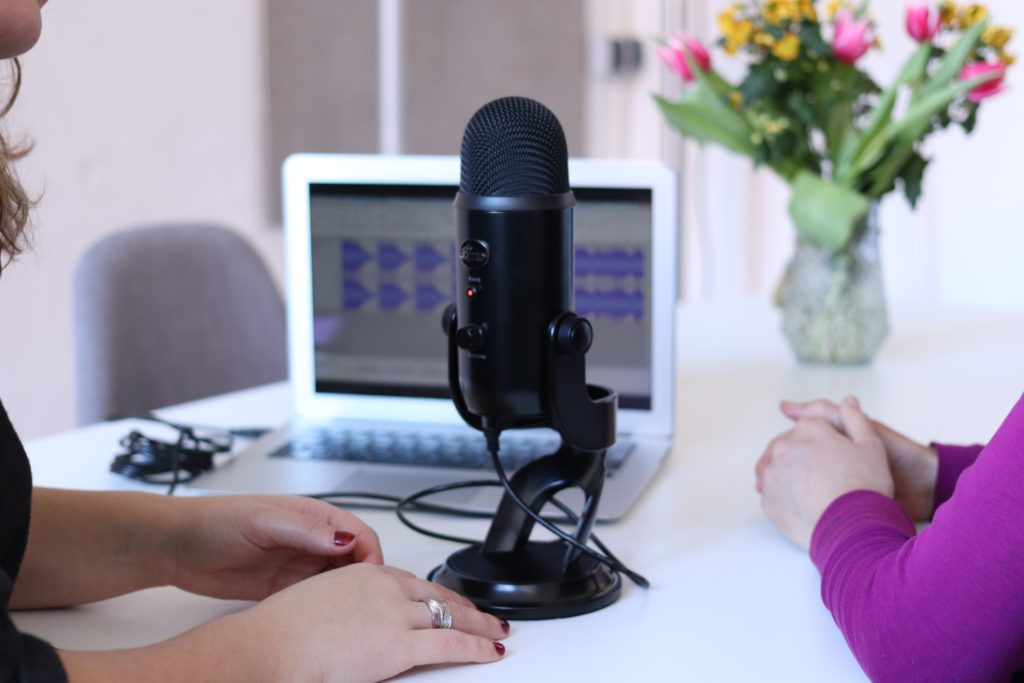
Podcasting is people downloading and listening, so you’re not actually in a room where you’re interacting with people. Podcasting is a very personal and private thing that leads to some of the best relationships because you’re able to do things at your own pace. At the beginning of podcasting, Jen and her husband had this mentality that more episodes were better. They later realized that it was not better because it was SO much more work, more energy, and more content. You would think with more content, that would mean more people would get to know you better but that wasn’t the case. What ended up happening was her listeners did not increase as much as they thought it would. This was because people started to fall behind so they stopped listening. With doing more, she didn’t see any bigger connection to money or followers. She wasn’t seeing any growth! Now since she is back to one episode per week, it is so much easier to promote it and share it with her followers! When she started doing less and focusing on where she put her energy, she started seeing a direct correlation to money. Jen always reminds herself that it is not about the number of downloads but instead it’s about targeting and finding the right people to listen to and cultivate those relationships with. Making that connection with people so that they want to buy and work with you is the most important aspect. Just because something is popular and has a lot of downloads, doesn’t mean it’s going to translate to automatic sales.

LISTEN ON SPOTIFY | LISTEN ON APPLE PODCASTS | LISTEN ON GOOGLE PLAY
THE IMPORTANCE OF JUST BEING YOURSELF.
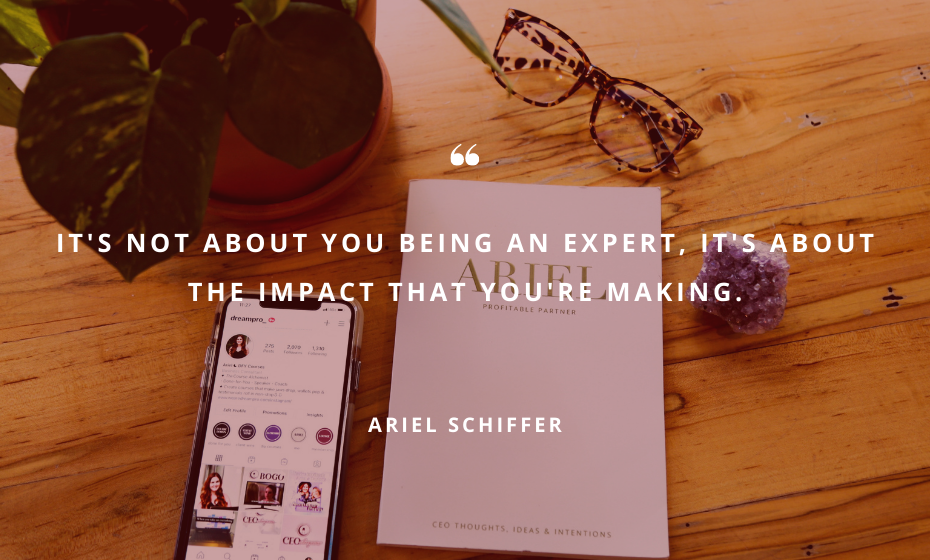
When you stop trying to be perfect and let yourself be, everything falls into place. That is the best thing about podcasting. By being yourself on social media, on your podcast, on your blog, whatever it is, that’s how you’re going to sell. Owning your voice so that you can share it with others is how you’re going to make more sales. Of course, a strategy is important but if you don’t have the right mindset, the strategy doesn’t even matter. Jen says that’s the biggest thing people don’t pay attention to. It is all about showing up, being consistent, and holding yourself accountable. Those are the things that create the foundation for an authentic relationship.
GETTING YOUR AUDIENCE OUT OF A PLATFORM AND INTO YOUR MESSAGES.
We don’t know what the future of any platform is but we know what the future is for the things we can control. We don’t know what’s out of our control but we know what’s in our control. Jen’s mentality to make the most sales is to get her followers out of the platform they’re on and into her DMs. You’re doing your audience a disservice if you don’t ask them to take the next step with you. Jen’s strategy consists of getting them off the show after they’ve listened and straight into her email list. It is your job to encourage them and find creative ways to get your audience to participate more. You have to do everything in your power to make them feel at home. Same with your podcast! Welcome new listeners and make them feel welcomed.
SIMPLE STEPS TO PROFITABLE PODCASTING AND BEST SALES TIPS WITH JEN GITOMER: THE BOTTOMLINE

I hope this episode was incredibly valuable for you all! My challenge for you is to sit down and evaluate how you can make your podcast inviting to welcome your audience in. Always be yourself because that is the best strategy to make the most sales. Nobody is perfect and people love genuine content and relationships. Be sure to get more juicy sales tips from Jen by joining her Sales Mini Course waitlist!
If you are interested in scaling your podcast, we can help you just like we helped Jen! Apply to work with us here.
Don’t forget to tune in to episode 45 of The Podcast Podcast to hear ALL the details about the points I just outlined above!
And if you love this episode as much as I do, don’t forget to take a screenshot, share it on your Instagram stories and tag me @ceopwr so that we can spread this important message to even more entrepreneurs and online business owners!
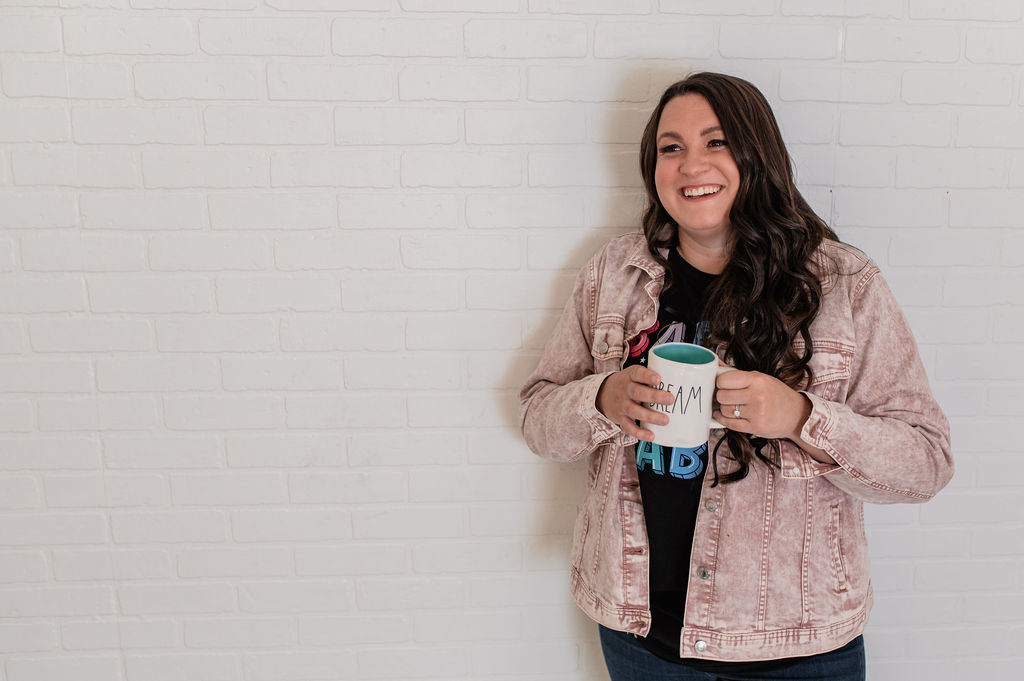
In episode 46 of The Podcast Podcast, I have special guest Sheila Masterson, who is a Philadelphia-based career and business tarot reader and teacher, energy healing facilitator, and host of the Living Tarot Podcast. She has been reading people her whole life practically! She believes that everyone can connect deeply to their intuition and that tarot is an excellent tool for learning to trust yourself and hearing your inner voice.
Sheila is on a mission to break the paradigm of old “fortune-telling readings” and instead, strives to empower clients through collaborative sessions that help them connect with their inner wisdom and move forward with confidence on aligned action steps. So stay tuned for more!
In case this is your first time tuning in, let me introduce myself. My name is Tara Counterman. I’m the founder and CEO of Profitable Podcast Productions, the creator of Profitable Podcast School and basically, 1000% obsessed with helping online entrepreneurs step out of the busywork, stop struggling for paying clients and actually get their message out there.
So if you’re ready to dive into this episode and hear more about tapping into your intuition, check out the points I share below! And for even more juicy details, listen to ALL of episode 46 of The Podcast Podcast on your fave streaming platform.
WHAT TAROT CARDS ARE AND THE EFFECTIVENESS IT HAS FOR SELF-REFLECTION AND ANXIETY.

Tarot cards are a deck of 78 cards that are used as a tool of reflection and force you to see any blind spots in your life. There are SO many different questions you can ask and the cards are open-ended so you can use them for anything.
Once you get in the flow of using the cards, Sheila says that the possibilities and validation you can get for your business are limitless. They help you pay attention in a way that is hard for most people. Sheila is not one of those people who believes the future is fixed. She wants to break the idea that tarot cards are just used for fortune-telling.
She has found that they can be way more effective for self-reflection and for people who have anxiety. Ever since she has become a business owner, Sheila has found that tarot is such an important tool to check in with yourself. A lot of anxiety comes up as a business owner and you second guess yourself A LOT.
Many people even get hit with imposter syndrome and she has found that tarot cards are an easy way to cut through that noise because your brain interprets that card and shifts out of panic mode. When you look at a tarot card, your brain switches into reflective mode and stops the anxiety to take a moment and digest the card and what it might mean.
So many people struggle to find a tool that offers self-reflection and tarot cards are an easy, yet affordable way to check in with yourself when other things aren’t accessible at that moment. It’s not about your relationship with the deck, it’s about your relationship with your higher self.
HOW TAROT CARDS AFFECT BUSINESSES AND BUSINESS OWNERS.
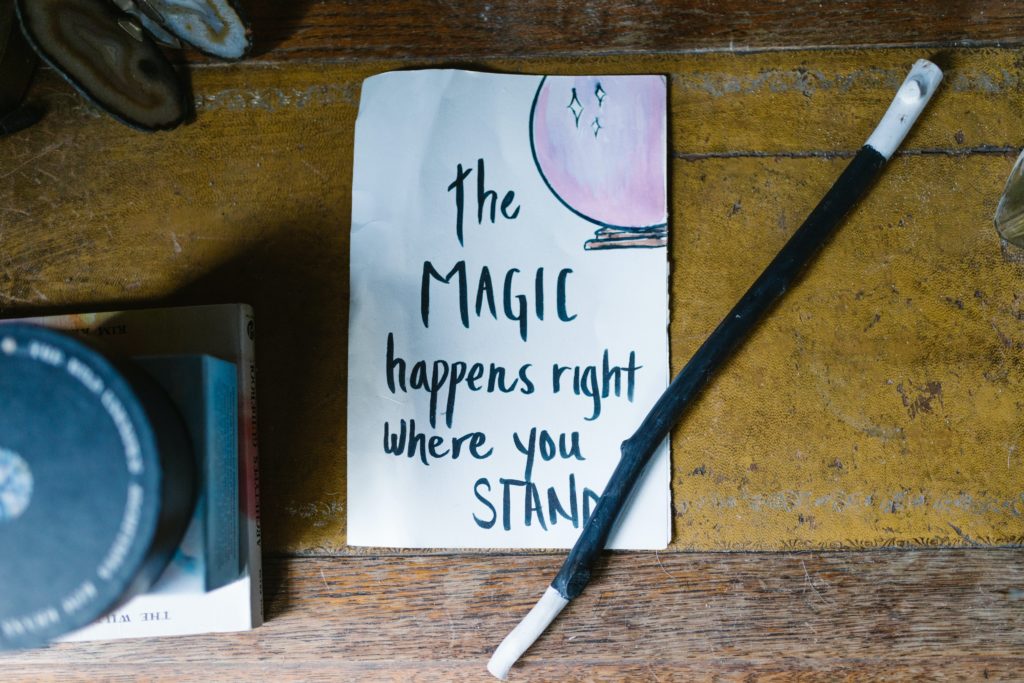
Sheila is always uncovering new ideas as she grows and develops new relationships. She has a really strong connection with her intuition, and always has. With clients and people on social media, she sees a lot of people trying to mimic what others are doing because in a business, it can be easy to get distracted.
We need to permit ourselves to do the things we want because our life path is not set. It’s okay to move things around and change them in your business instead of getting stuck in the 9-5 mentality. There is a shift that happens in a lot of her readings where people start to ask too many questions or ask for confirmation.
They seem too reliant on the card’s answers. After several sessions, they start to come in way more confident in their questions and they’ll stop second-guessing themselves. When you do more tarot card readings, you’ll come in looking for confirmation rather than detailed answers to all your business questions.
When Sheila sees people have that transformation and confidence in their own business, it is so powerful. It makes her love what she does and proves what can be done with tarot. For me, I know that tarot cards have been a HUGE help as well to my business. It also has a calming and reassuring effect to it.

LISTEN ON SPOTIFY | LISTEN ON APPLE PODCASTS | LISTEN ON GOOGLE PLAY
TIPS TO GET STARTED WITH TAROT AND HOW PODCASTERS CAN USE THEM.
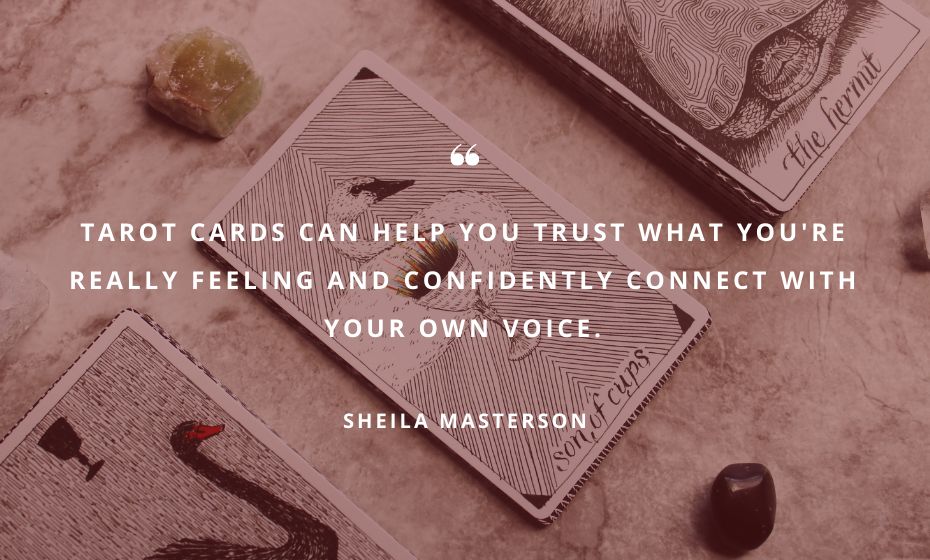
In terms of getting started, know that you never have to read to anyone else if you feel like you’ll be judged by family or friends. Sheila says it is something that can be totally private. Until you feel confident enough to share it, you don’t have to worry about anyone else’s opinions.
If you’re brand new, look at the picture, think about how it makes you feel and how it comes into your head. She says you can also write things down as you see new cards because it will help build your intuition and see what the actual meaning of the card is.
Sheila also tells us that you don’t need any type of certification! You can teach yourself or find a million things online. When it comes to podcasting, you can use tarot cards to drive ideas and episodes.
She says it’s a good way to check in on boundaries in your business. It can help you brainstorm and figure out what to talk about in your podcast too! They support you in any moment of your business to trust what you’re feeling and to confidently connect with your own voice.
PODCASTING AND TAROT CARDS: TOPIC IDEAS, INSPIRATION, AND MORE WITH SHEILA MASTERSON: THE BOTTOMLINE

I hope this episode has helped you see how tarot card reading can help you in your business and personal life. I have loved getting more insight on Sheila’s journey and I hope you enjoyed hearing all about the magic behind tarot cards. If you want to get started with tarot cards, there is no reason to be scared! You will gain so much more confidence and feel more empowered to connect with your inner wisdom.
If you want to get in touch with Sheila and learn more about her work, check out her website here. And to any beginners, I encourage you to purchase my favorite deck of cards, The Starchild Tarot Akashic.
You can launch your podcast mini-course here, which is what Sheila started her podcasting journey with, and if you want to scale your podcast even more check out the Profitable Podcast Membership!
Don’t forget to tune in to episode 46 of The Podcast Podcast to hear ALL the details about the points I just outlined above!
And if you love this episode as much as I do, don’t forget to take a screenshot, share it on your Instagram stories and tag me @ceopwr so that we can spread this important message to even more entrepreneurs and online business owners!
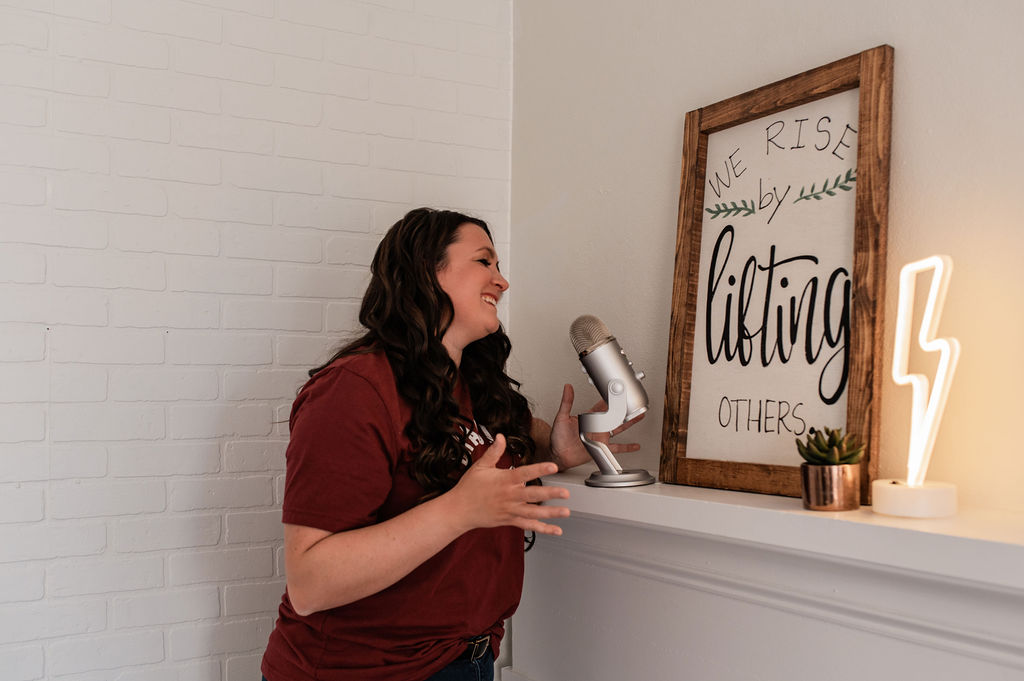
Which type of podcast host are you?
From my years of experience, I’ve been able to identify four types of podcast hosts that encompass the podcasting journey. Today, I’m breaking down what these types are and the podcast strategy each type needs to be more successful.
Type 1: The Want-To-Be Podcaster

What it is: This stage is pretty obvious; it’s when you don’t have a podcast but want one yet. I’ve found that this is the stage people stay in the longest. People want to start a podcast, but they are stuck in inaction.
The podcast strategy you need: If you’re a want-to-be podcaster, you need to start by taking action, even if it’s messy. I recommend sticking with the basics. Your goal should be planning your launch and getting 4-10 episodes ready to launch at once. You want to release several episodes at once and not just one so you can get your listeners “hooked” and build a bingeable platform.
Type 2: The Traditional Podcaster

What it is: The Traditional podcaster is someone who has already launched but hasn’t been strategic in doing so. They don’t have a lot of planning or strategies going on behind their podcast, and they tend to mimic what others are doing in the podcast space. Your podcast isn’t getting results for your business.
The podcast strategy you need: If you’re a traditional podcaster, it’s time to reevaluate what you’re doing. Ask yourself, are you addressing your ideal client in your podcast? Is your podcast content intentional and in line with your other content? Your goal should be to get to a place where you have systems for batching, organizing, and not wasting valuable time.

LISTEN ON SPOTIFY | LISTEN ON APPLE PODCASTS | LISTEN ON GOOGLE PLAY
Type 3: The Holistic Podcaster

What it is: The holistic podcaster is someone who is starting to incorporate launch strategy into their podcast. Utilizing your podcast in a holistic way for your business is all about taking a look at your entire business, the way you’re creating content, the way you’re showing up for your audience, and implementing your podcast into all those things.
The podcast strategy you need: Remember that launching is NOT only when your cart is open! It’s all the time. So your goal should be to get intentional with your content ALL the time, not just when your cart is open.
Type 4: The CEO Profitable Podcaster
What it is: The CEO podcaster is when the only thing they have their hands on in regards to their podcast is recording and planning. They’re only concerned with planning the content to align with launches, then having everyone else handle the rest. A CEO Profitable podcaster has a team of support that understands their vision, how to leverage the podcasting platform so they can be fully supported and not have to worry about all the details. A CEO podcaster can sit down when they’re planning their launch, batch record their episode content, and have their team create the rest of the launch content.
The podcast strategy you need: Keep doing what you’re doing 😉
The Four Types of Podcast Hosts and How It Affects Your Podcast Strategy: The Bottomline

Whatever type of podcast host you are, know you don’t have to stay there! You can take practical steps towards making your podcast work for your business.
And I’d love to help you do that! Every day I get to help badass entrepreneurs just like you turn their content into cash.
Thanks for reading!
If you want to become a CEO profitable podcaster, I’d love to help you get there! You can connect with me on Instagram. Catch you in the next post!
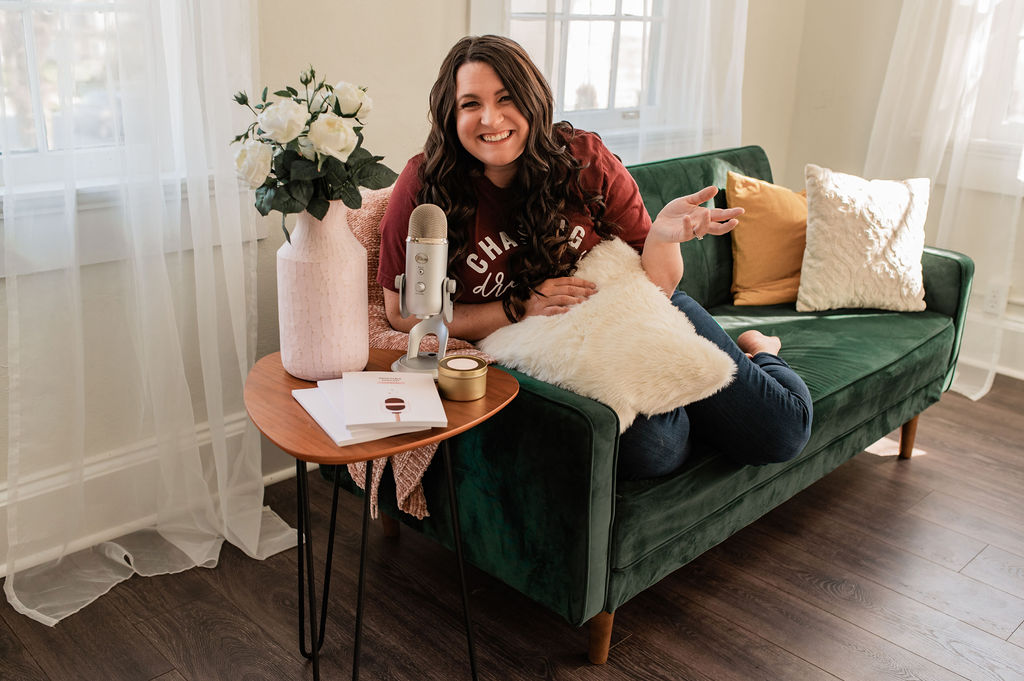
If you’ve got a podcast for your business, is it actually bringing you results?
I’m not talking about download numbers or reviews. I’m talking about results for your business. Are you getting more inquiries? More opt-ins? More sales?
If the answer is no, your podcast isn’t working for your business to its full potential. That might be tough to hear, but here’s the good news: you can change this! You just need to take a different approach.
Today, I’ll show you what the traditional approach to podcasting is, why it’s not working for you, and what you can do instead.
What is the traditional approach to podcasting?

The traditional approach to podcasting is focused on download numbers and unrelated paid sponsorships. It’s all about the podcast itself and not about what the podcast can do for your business.
In the traditional podcast approach:
- Podcast content lives separately from the rest of your content. It doesn’t match with what else you’re doing on social.
- You rely on interviews to fill in the gaps.
- Content feels random and unstrategic.
You have to remember that your podcast as a business owner is going to exist for a different purpose than an entertainer, news agency, etc. So you have to do things differently.
What’s wrong with the traditional approach to podcasting for businesses?

There are several issues with the traditional approach to podcasting that won’t work well for businesses.
- Sponsorships. The problem with paid sponsorships is that it takes the focus off what your listeners are there for anyway: YOU! If you have too many paid sponsorships, it can dilute your message and is distracting for your listeners. You, as an online coach, want to focus on bringing attention to your offers. When you offer something else on your podcast platform, people will subconsciously assume you can’t serve them in the areas you are talking about.
- Interviews. I believe in collaboration over competition, I am not saying you shouldn’t have guest experts on your podcast. However, when we are creating interviews simply to have new episodes come out on our podcast, that content is not working for you. Additionally, if you have a guest on your podcast talking about something completely different than your main content, it’s confusing for your audience.
Creating content for the sake of creating content. You want to make sure everything you do has a purpose behind it, whether it’s to entertain your audience, bring awareness to a problem, whatever it may be. It needs to be intentional to be effective.

LISTEN ON SPOTIFY | LISTEN ON APPLE PODCASTS | LISTEN ON GOOGLE PLAY
The approach to podcasting for businesses you should use instead.

Rather than relying on the traditional approach to podcasting, take a holistic approach.
The holistic podcast approach also positions the creator in their CEO role where they can be fully supported. Consistent messaging is so important when it comes to nurturing and priming, when we change our messaging and don’t stay consistent, then it won’t fully sink in and integrate for your audience.
If you tried to go live and post on every single social media platform organically, you would be creating content constantly. What’s great about macro content and podcasting is that you can maximize your online presence on all platforms by focusing on the macro content and doing it holistically. This way, it can bleed out into all the other places. You can connect with people who are different versions of your ideal client, who simply consume content differently.
You can make content work harder for you, but you must be intentional and look at it from a holistic lens. This is part of my business, not a separate entity.
Why Your Podcast Isn’t Working For Your Business (And How To Fix It): The Bottomline

When you focus on creating content and lean into a holistic podcast approach, your brand will have a next level of cohesiveness. Everything will be layered together and work together powerfully for you. This is why you need to look at your podcast through a more holistic lens.
Thanks for reading!
Want to chat more about building a podcast content strategy that actually works for you? I can help! Send me a DM on Instagram, @ceopwr.
Catch you in the next post!
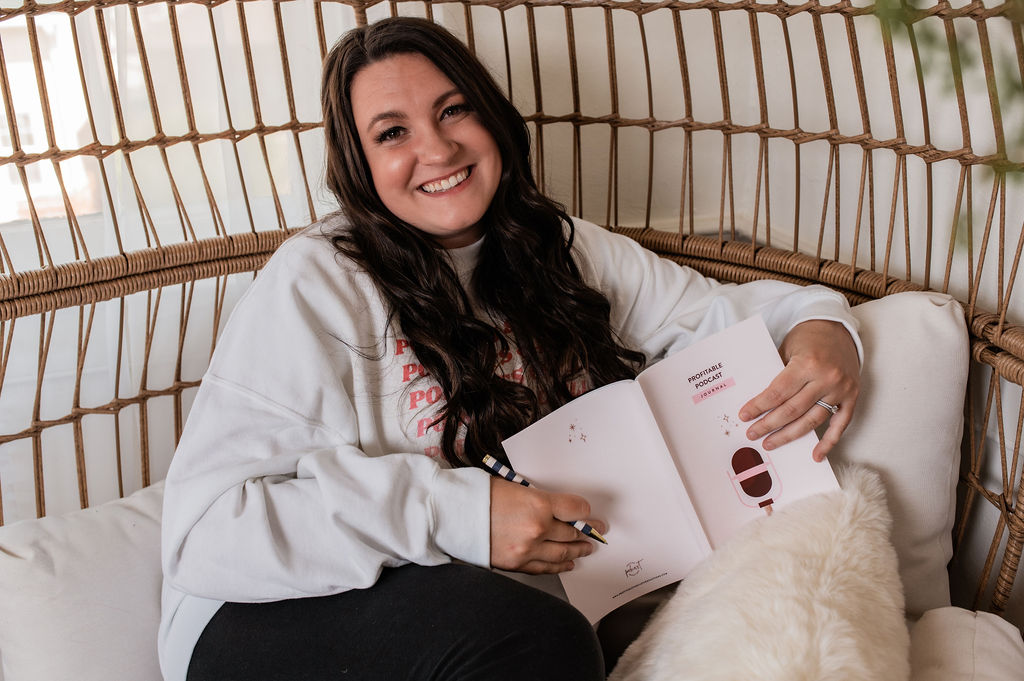
If you’re a business owner with a podcast, I have a very important question for you:
What is your podcast actually doing for your business?
If the answer is “nothing,” you’re not unlike most entrepreneurs I talk to. What I hear from so many business owners is that they’re creating podcast content just to create content, and there’s little to no strategy involved.
But listen: if you’re creating content without a podcast strategy, you’re wasting your time! There is a MUCH better way to create podcast content that actually helps grow your business.
So if you’re tired of spinning your wheels trying to create content week after week for your podcast, keep reading! I’m going to show why you need a podcast strategy with content that works for your business.
First things first: Understand that your time is valuable.

Time is a very valuable commodity. It’s the one thing you can’t get back.
Your time as a business owner is extremely valuable. You should only be spending it in places that make sense.
So if you’re spending tons of time on podcast content that doesn’t actually do anything for your business, why are you doing it???
If your podcasting experience is feeling like a toxic relationship, it’s time to stop and re-evaluate why you’re doing it.
Your podcast IS a strategy itself!

So many people don’t even realize that podcasting IS a business strategy!
It should be focused on helping your business grow. It’s not a separate or random thing.
So in all your podcast content, you should be focused on connecting with the people you want to serve in your business. What do they need to learn? What do they want to know?

LISTEN ON SPOTIFY | LISTEN ON APPLE PODCASTS | LISTEN ON GOOGLE PLAY
How to evaluate your current podcasting efforts.

A great way to think about this is to focus on input vs output. What are all the things you’re doing to invest in your podcast? And what are you getting out of it?
Here’s a great exercise you can use to evaluate how your podcast is (or isn’t) working for you.
First, write down your INPUT. Clock all the time you spend:
- Prepping
- Recording
- Editing
- Promoting
- Anything else involved with your podcast
Next, write down your OUTPUT. Think about what you’re getting out of your podcast. Is it leading to more:
- Connections?
- Leads?
- Sales?
Are you getting more out than you’re putting in? Or vice versa?
Your podcast should be giving you a return on your investment. If not, it’s time to reevaluate your strategy.
Why You Need a Powerful Podcast Content Strategy for Your Business: The Bottomline

I have built a whole business surrounding the idea that the time and energy you put into podcasting shouldn’t be like nurturing a toxic relationship, that it is something bringing you leads and sales.
This doesn’t happen when you’re winging it without any content strategy. There are solutions out there for you to learn to do podcasting profitably, you have to be willing to invest time, effort, energy, and maybe even finances to learn how you can do just that.
Thanks for reading!
Want to chat more about building a podcast content strategy that actually works for you? I can help! Send me a DM on Instagram, @ceopwr.
Catch you in the next post!
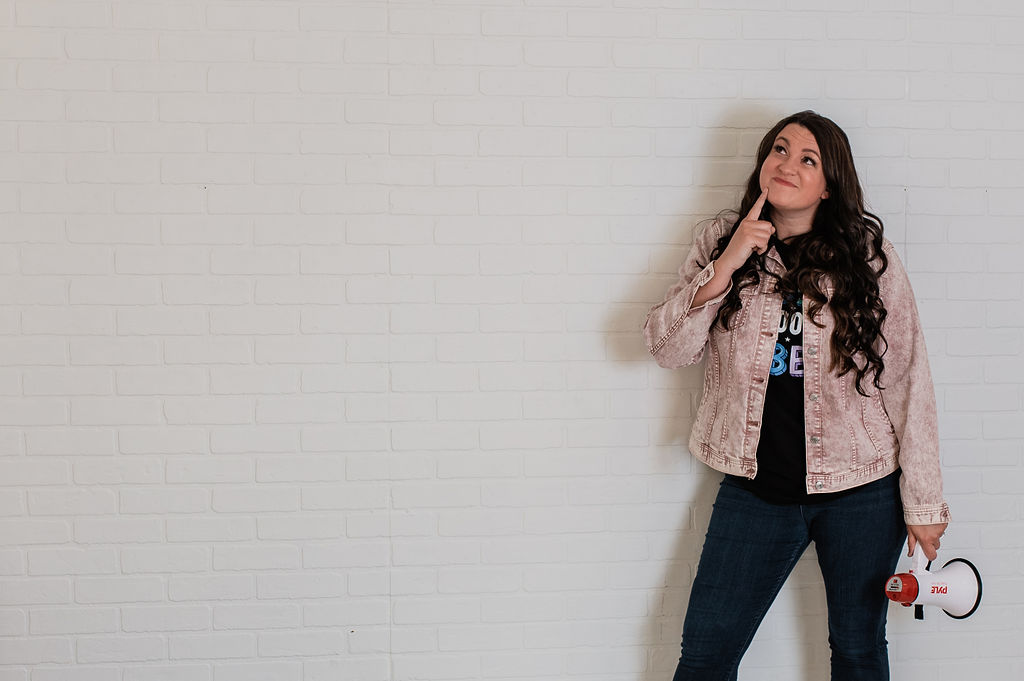
Why do you do what you do?
It’s a simple question, but actually answering it may be harder than you think.
The answer to this question is what determines your business’s mission. Being clear on your business’s mission is crucial because it will affect every decision you make in your business. To know who you help and how you help them, you first have to understand why.
So let’s dive in and talk about how to determine your mission for your business!
The importance of a strong mission for your business.

Your mission determines EVERYTHING you do in your business. If you want to show up powerfully, you have to have a powerful reason behind why you do what you do!
If you are constantly innovating in your business, you will constantly be thriving. Some things will fall flat and not perform the way you envisioned, but innovation above all else is what will truly bring out your specific magic.
But your mission doesn’t change. When you’re doing new things in your business, always come back to your mission.
Questions to ask yourself to determine your business’s mission.

Here are some questions to reflect on so you can answer why you do what you do:
- What are your core beliefs?
- What do you stand for? What do you stand against?
- What do you believe to be true?
- Where and how do you want to show up?
- What do you believe would happen if you showed up in the most powerful way possible?
Answering these questions will help you get clarity so you can be super sure of your mission!

LISTEN ON SPOTIFY | LISTEN ON APPLE PODCASTS | LISTEN ON GOOGLE PLAY
My example of how knowing my business’s mission helped me make a decision.

I want to give you a behind-the-scenes look at how all of this plays out in real life.
A big part of my business’s mission is to help entrepreneurs get the most out of their content so that it works for them (and not vice versa!) I want to help others achieve this, but first, I have to do it for myself.
So I’ve been looking at all my content to see what is and isn’t working for me. I realized that with my social media, I don’t have to be on every single platform. In fact, spreading myself to thin is incredibly draining and just waters down my message.
To serve my business’s mission, I’d be better off showing up powerfully on fewer platforms.
So I decided to shut down my free Facebook community. I realized that space wasn’t where I felt most comfortable and wasn’t where I felt the most committed to showing up consistently.
Connecting back to my business’s mission really helped me make that decision. I want everything I do to be serving that mission.
Shutting down my Facebook community was the best decision for me, but showing up powerfully in a Facebook group might be the perfect decision for someone else. It ALL works. It just depends on what’s best for you and YOUR business.
What will help you serve your business’s mission in the most powerful and effective way? That’s what you need to ask yourself, and don’t worry about what others are doing.
Thanks for reading!
I hope this post gave you some more insight on how to answer why you do what you do.
If you found this post helpful and you plan to finally dive into podcasting, I’d love to know more about it! You can connect with me on Instagram. Catch you in the next post!
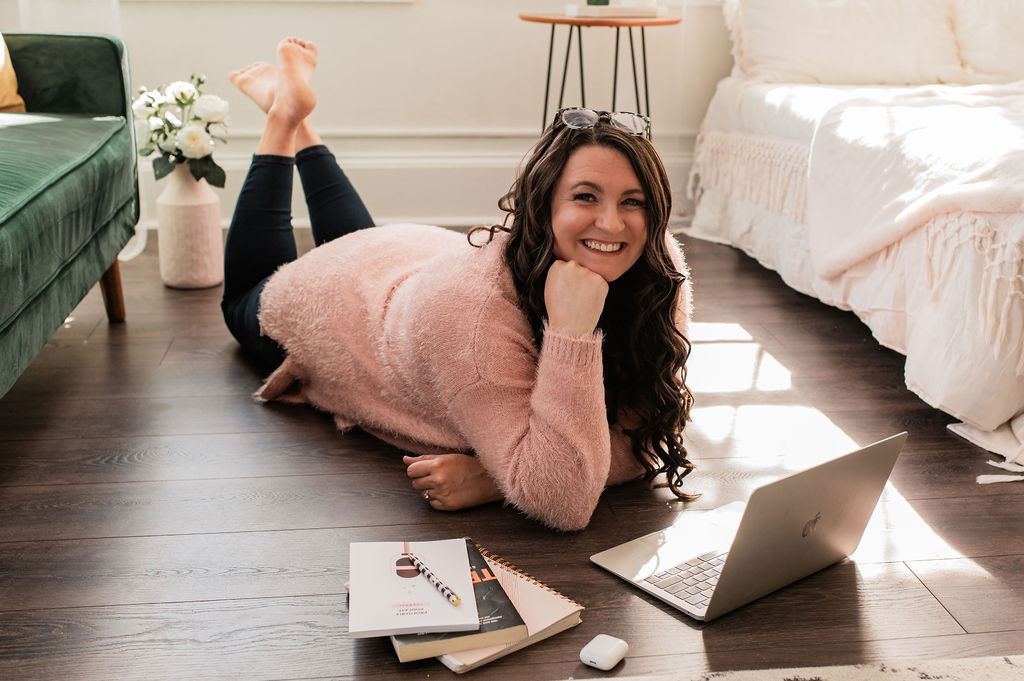
You want to launch a podcast… but don’t even know where to begin?
Stick around, because I’m going to share the 4 key things YOU need to know in order to launch a podcast and also set yourself up for success.
Keeping it super simple for you! Let’s dive right in.
Find a way to record and something to record with.
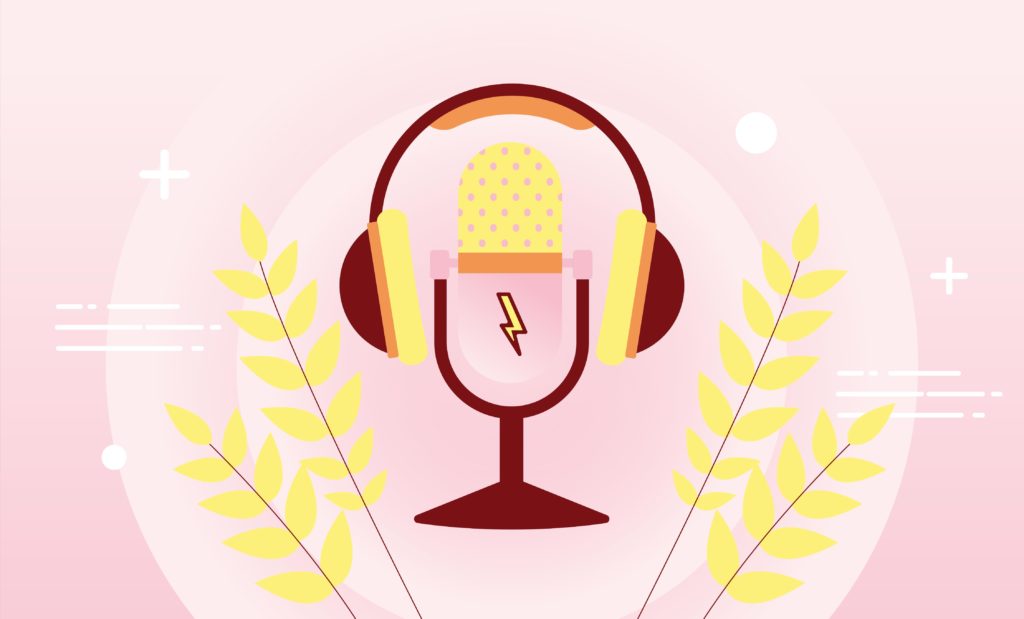
Listen, you DO NOT need to spend an arm and a leg on a microphone for your podcast.
SO many people let this common misconception hold them back from starting theirs, and don’t let that be you.
Here’s the reality – you can go super high-tech or you can stay super basic. Either way works!
When I first started podcasting, I used a $45 microphone. Hey, it got the JOB DONE.
Of course, I’ve upgraded since then but it’s totally not necessary, especially if you’re just starting your podcast.
When it comes to recording, keep it simple.

Here’s your new best friend for easy and hassle free recording… ZOOM.
I recommend Zoom for all of my clients and it’s what I use to record my own episodes too.
The best part is that Zoom is TOTALLY free, unless you want to upgrade for extra features.
When it comes to the quality of your podcast episodes, pay attention to HOW you are recording your podcast.
Of course you can go in and do edits afterwards, but might as well make sure you’re recording high-quality audio in the first place.
Top tip to make sure you get the best quality audio:
- Speak closely to the microphone!
- Record in a small room with low ceilings and preferably carpet to reduce any echos.
If you want to get even more tips on podcast audio quality, be sure to check out all my other blog posts on this topic!

LISTEN ON SPOTIFY | LISTEN ON APPLE PODCASTS | LISTEN ON GOOGLE PLAY
Set yourself up on your podcast hosting platform!
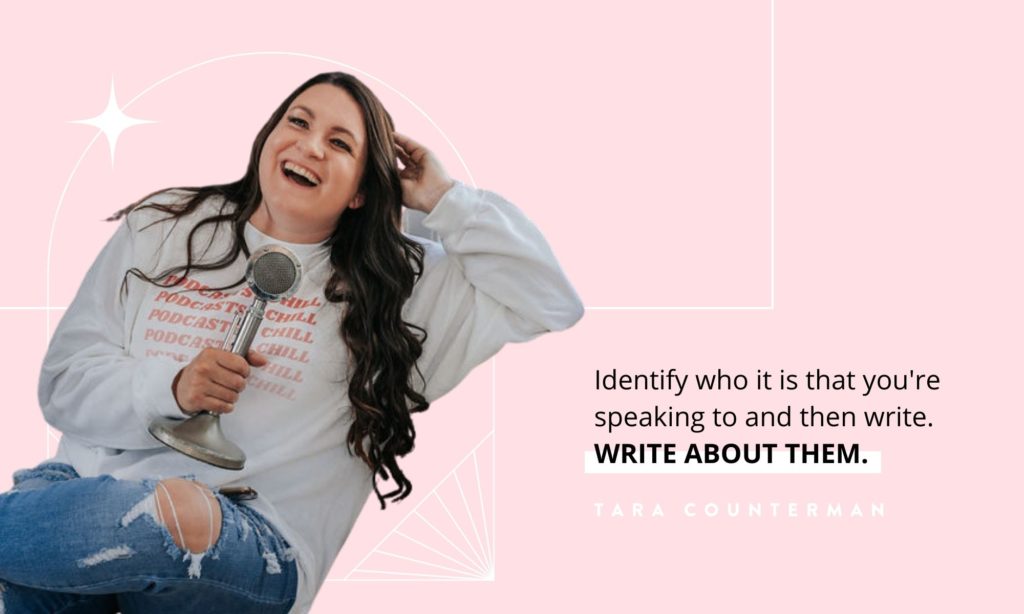
A podcast hosting platform is essentially like a website where all of your files are stored.
You can opt for a free site like anchor.fm or something similar. (However, I’m not a huge fan of these because they focus in on driving traffic to their platform rather than your own)
Instead, I HIGHLY recommend Libsyn. Libsyn is super affordable and totally worth it. Their plans vary from about $5-$15 a month.
Here’s how it all works –
When you have a podcast episode ready to go, you don’t upload it one by one to ALL the different streaming platforms. Instead, you upload to your host and that host pushes it out to ALL of the other streaming platforms. Pretty cool, right?
Get some editing software in place.
While you want to aim to initially record your podcasts in the best quality possible, sometimes you will just need to do some edits afterwards and that’s TOTALLY okay.
Oftentimes, this is an area of support that requires some outsourcing. As a podcaster, you can’t do ALL the things ALL the time. So, consider outsourcing for this aspect of your podcast.
KNOW who your ideal client is and WHAT they need!
Before you EVEN start your podcast, you HAVE to have a solid understanding of who’s going to be hearing your message.
A few ideas for you to start gaining a clear perspective on your ideal client…
- If you currently have some clients, ask them what pain points and areas of struggle they found themselves encountering before seeking your support!
- Poll your followers! Ask your social media audience what areas they feel they need help in.
- Pay attention to your analytics and insights on existing social media content. What’s out performing others?
Thanks for reading!
If you have been wanting to launch a podcast but letting ALL the extra techy details and common myths stop you, I hope this post has helped. Remember, starting your podcast does not have to be super complicated. It can actually be super simple, as long as you make it that way.
Grab your $45 mic and just get started!
If you found this post helpful and you plan to finally dive into podcasting, I’d love to know more about it! You can connect with me on Instagram. Catch you in the next post!

Today, I want to talk all about the four different types of podcast hosts. In this week’s blog, I am sharing insight on the four types of podcasters I’ve seen throughout my years of teaching and helping entrepreneurs grow their podcasting platform. This is an important topic because you should know where you’re currently at as a podcast host and where you want to go.
In case this is your first time tuning in, let me introduce myself. My name is Tara Counterman. I’m the founder and CEO of Profitable Podcast Productions, the creator of Profitable Podcast School and basically, 1000% obsessed with helping online entrepreneurs step out of the busywork, stop struggling for paying clients and actually get their message out there.
So if you’re ready to dive into this post and hear more about the four types of podcast hosts, check out the points I share below!
TYPES OF PODCAST: THE FIRST TYPE OF PODCASTER IS THE WANT TO BE.

This is the very first type of podcaster and an obvious one. It’s the Want to Be podcaster. In my experience, this stage is the longest stage most people keep themselves stuck. They have this idea of launching but they sit on it without taking action. So they sit and wait months and months. If you are in this category, the biggest thing you need to focus on is launching your podcast. Yes, there is planning and tech behind it. When I created my first program, the Profitable Podcast School, I threw so much information at my students and they struggled with being able to implement. They felt like they had to perfect everything before they could get started.
So if you feel you are the Want to Be podcaster, we must focus on the basics and we know we will go through this path and build. You have to start somehow, so go with the basics. Your goal is going to be planning your launch and getting between 4-10 episodes ready. When we think about podcasting, we want to think about it like Netflix. Netflix doesn’t release shows one at a time like cable tv, it’s a binge-able platform. They want you to get hooked and connect with the characters, the story, it takes more than one episode. This same principle can be applied when it comes to launching your podcast. You don’t want to launch with only 1-2 episodes, you want a built and binge-able platform.
This may seem like a lot of content, but what you can do is make sure you’re batching. The Want to Be podcaster needs to become a batching professional to get things done quickly and effectively. The more we take on one task at a time, we are losing efficiency. It’s not that you have to be a robot but you’ll want to get good at batching. When we can focus more on recording, graphics all at once, we’ll be so much more effective with our time. This is so important for you because you want to be sure you get your show launched and don’t get stuck in overwhelm. The person getting ready to launch can get overwhelmed really quickly, if this is you, I completely understand. I was there, it took me months of research and learning all the tech details to podcasting. The reason for that was because I thought I had to do everything at once, this is why in my membership I break down launching in 14 days.
PODCAST FOCUS: THE SECOND TYPE IS THE TRADITIONAL PODCASTER.

If you are a Want to Be podcaster, you go through any of our programs or courses, this won’t be you. However, the Traditional podcaster is someone who has already launched but hasn’t been strategic in doing so. They don’t have a lot of planning or strategies going on behind their podcast, and they tend to mimic what others are doing in the podcast space. I’ve been working on auditing a lot of podcasts and something I hardly see is that high-level business strategy.
The Traditional podcaster typically just launched to have a podcast or maybe they had a coach suggest that they create one. If you are in this stage, you have to focus on evaluating what your current elements are. Also, figure out whether those were intentionally created or if you’re truly addressing what your ideal client needs to hear. As a Traditional podcaster, this is your time to take a deep breath and evaluate what you have been doing, why you’ve been doing it, and how you can improve from this point. You also want to make sure you have effective systems in place for organization, batching, and not wasting valuable time. A lot of the same qualities for the Want to Be podcaster will apply to this because they’re both doing things without strategies or plans.
PODCAST FOCUS: THE THIRD TYPE IS THE HOLISTIC PODCASTER.

The Holistic podcaster is someone who is starting to incorporate launch strategy into their podcast. I just had a call recently with someone who I’d classify as a Traditional podcaster, and the whole time during our intensive, we focused on moving her from that traditional space to a more holistic approach. For me, utilizing your podcast in a holistic way for your business is all about taking a look at your entire business, the way you’re creating content, the way you’re showing up for your audience, and implementing your podcast into all those things. The Holistic podcaster is bringing that launch strategy and implementing ads for themselves. I see with a lot of podcasters, usually the traditional mindset, they are hoping to grow their show so that one day they can have sponsorships and people will pay them to put their ads within the show.
As for holistic, you are focusing on promoting your services and the things you offer. You have to evaluate, the Holistic podcaster is constantly evaluating what they are launching and working on to incorporate into their podcast strategy. They are also starting to think about leveraging guest interviews for affiliate marketing, appearing on other people’s podcasts with affiliate marketing, and they are being more strategic in the way they structure their episodes. A huge misconception that I see is that launching is only during that period where your cart is open. Launching happens so much more before that, we have to prime and nurture our audience to get them to a place where they can say yes to what your offer is.
PODCAST FOCUS: THE FOURTH TYPE IS THE CEO PROFITABLE PODCASTER.

The CEO podcaster is when the only thing they have their hands on in regards to their podcast is recording and planning. They’re only concerned with planning the content to align with launches, then having everyone else handle the rest. A CEO Profitable podcaster has a team of support that understands their vision, how to leverage the podcasting platform so they can be fully supported and not have to worry about all the details. A CEO podcaster can sit down when they’re planning their launch, batch record their episode content, and have their team create the rest of the launch content. When you are podcasting through the holistic lens, we’re always able to repurpose our content and promote our podcast.
I see this happen a lot where podcasters spend all this time recording and editing but then they don’t promote the show when it’s launch time. They are talking about separate topics and not strategically planning as they record their podcast content. So with the CEO Profitable podcaster, they can plan and map out their launches. They don’t have to keep saying the same thing over again. Their team knows how to take their voice and message and be able to amplify that even more. It’s so vital you stay in your zone of genius, and that doesn’t have to be worrying about repurposing content, you can outsource that to someone else. This is also when you’re able to spend 30 minutes up to an hour in front of the microphone and pull multiple social captions, emails, shownotes, or even a blog post all from that. You can also share the podcast on Pinterest, use it as a guest blog, or even a PR feature. You are taking that recording and also turning it into IGTV videos, repurposing that one piece of content in so many ways.
The CEO Profitable podcaster also knows time is something they can’t get back, therefore they are willing to invest. They’ve gone through the journey and they know they’re able to create more by being intentional when they sit down in front of the microphone. They also know they can leverage money to create more while saving more time. Especially with repurposing and podcasting, there’s so many things we could be doing. We could make our lives so much easier, but we let this mindset block of paying to get help stop us. Whether that’s someone like our agency, Profitable Podcast Productions, or you building your internal team to help. The CEO Profitable podcaster knows this investment is worth it because long-term they get their time back.
YOUR PODCAST FOCUS BASED ON YOUR PODCASTER TYPE: THE BOTTOMLINE
I hope you found this blog post helpful. I want you to make sure that if you are a Want to Be podcaster, you aren’t getting overwhelmed and keeping yourself from starting. Jump in and take action. If you are a Traditional podcaster, don’t be afraid to change things up. There is a way you can leverage your podcast so much more. If you’re a Holistic podcaster, I am so proud of you! I am so glad you’re able to leverage your podcast for your launches and structuring your episodes in a way that makes sense. If you’re ready to be a CEO Profitable podcaster, focus on leveraging your time, creating content, and making so much more from that.
And if you love this blog post as much as I do, don’t forget to take a screenshot, share it on your Insta stories and tag me @profitablepodcastproductions so that we can spread this important message to even more entrepreneurs and online business owners!
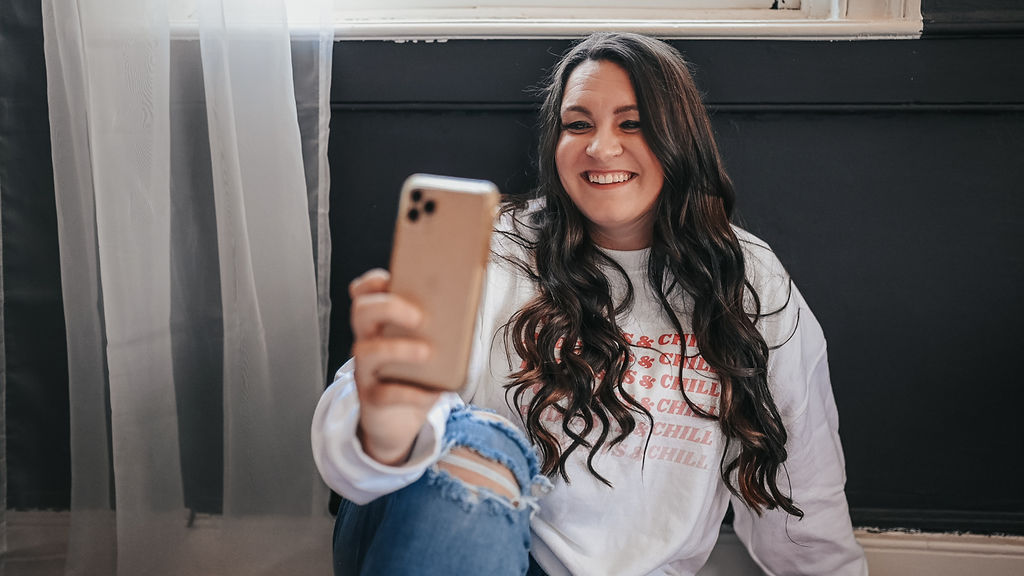
Today, we are going to dive behind the scenes with a special guest, Rachael Fisher. Rachael is a mindset and embodiment mentor for entrepreneurs. She is also an expert at helping entrepreneurs drop limiting beliefs and overcome imposter syndrome. In this week’s blog, Rachael and I chat more about behind the scenes of what goes on in her podcast and podcast strategy.
In case this is your first time tuning in, let me introduce myself. My name is Tara Counterman. I’m the founder and CEO of Profitable Podcast Productions, the creator of Profitable Podcast School and basically, 1000% obsessed with helping online entrepreneurs step out of the busywork, stop struggling for paying clients and actually get their message out there.
So if you’re ready to dive into this post and learn more about Rachael’s story behind her podcast and strategies to be put into place for podcast growth, check out the points I share below!
PODCAST OPTIMIZATION: RACHAEL SHARES HER BACKGROUND OF GETTING INTO THE ONLINE COACHING SPACE AND STARTING HER PODCAST.

For Rachael, understanding the significance of her podcast was something she hadn’t acknowledged at first. She realized there was so much she didn’t know behind podcasting and she had to look at it from a new perspective. Rachael’s story involves being in an online program to become a certified coach, she graduated in January of last year. All of last year, her business was like a hobby to her. Rachael was working through her inner struggles that were ultimately holding her back. In January, she left her corporate job and went full in with her business.
When it comes to her podcast, it’s been a dream of hers to start the last few years. Through doing lives and videos, people told her she should start a podcast. It was an idea of being able to reach people all over the world who would otherwise never find her on social media that grabbed her attention. She approached podcasting initially from an “I’m just winging it” mindset, without any strategy or knowledge on how to go about it profitably. What Rachael found after speaking directly to me about this was realizing how easy it can be to procrastinate recording for her podcast. Keeping in mind that it can be time-consuming and it may not be profitable right away makes it harder to stay consistent. Rachael got to the point where she began seeing her podcast as a tool for her business, rather than just a hobby.
PODCAST OPTIMIZATION: RACHAEL BREAKS DOWN THE STRUCTURE BEHIND HER PODCAST.

Rachael has an intro and outro within her podcast, however, when it comes to the actual episodes, there’s no structure. She never knows exactly how long the podcast episodes will take. When it comes to deciding topics and content to discuss, Rachael would say it’s a mixture of mindset. It’s specific to entrepreneurs, all things around embodiment, energy work, and manifestation. All the things that encompass Rachael’s business are found in her podcast. She shares personal stories and things she’s worked through with clients, as well as tools and resources.
Rachael naturally finds that talking and sharing her thoughts to people is something she’s confident in, but issues always come back about how there’s so much more she could be doing and doesn’t know. She feels although the podcast episodes have a lot of value, there’s not a clear path to lead people. In some episodes, there’s a starting point, but the whole show in general doesn’t take people down a journey. When Rachael records the podcast, her partner edits and improves audio quality, and creates a graphic to share on social media. From there, Rachael would share the graphic on her IG feed and stories. In the last few weeks, Rachael admits she hasn’t been sharing the graphics to her social platforms.
PODCAST OPTIMIZATION: A COMMON MISTAKE MANY PODCASTERS MAKE IS THE LACK OF SOCIAL MEDIA AWARENESS ABOUT THEIR PODCAST. RACHAEL SHARES MORE ON WHY SHE’S MADE THIS MISTAKE HERSELF.

Rachael isn’t too clear as to why she doesn’t promote the podcast as much as she should. She believes due to not having many directions with her podcast creates resistance to wanting to promote. She finds that she doesn’t feel fired up or excited enough to share due to that lack of planning, so when it comes to sharing on social media she takes a more passive approach. She recognizes she needs to adjust this approach because she is sharing her value and spending valuable time to record the podcast episodes. For me, it’s very interesting because at the beginning of the call with Rachael she was very fired up about how special her show is and how she pours her heart into the value she provides. However, when it comes to promoting, she is closed off to the idea.
A lot of where this comes from for Rachael is that it’s fairly new, it’s vulnerable, and she’s out of her comfort zone. On top of that, not knowing her direction makes her insecure to share and promote. She finds herself wondering whether people will like what she has to say on her podcast. She finds she’s not fully confident in her podcast and that creates a shy approach. A common theme that Rachael has noticed in where she feels she needs attention in her business is more planning and prepping. This also shows up in her podcast, there’s no planning and that’s why there’s weeks or months where she doesn’t have episodes airing. She finds she resists the idea of planning and it’s a cycle of self-sabotage.
PODCAST OPTIMIZATION FOR YOUR BUSINESS GOALS: THE BOTTOMLINE
I am so grateful that Rachael was able to be featured in this post and allowed me to do market research on her and her podcast. I wanted to show you guys how easy market research can be, market research doesn’t have to be super complicated. It can just be in conversations. We want to make sure we can take those limiting beliefs our ideal clients may be feeling, dissect them, and create content surrounding it. It’s our job as course creators and coaches to take those fears and the way they look at things to direct to a new lens.
And if you love this blog post as much as I do, don’t forget to take a screenshot, share it on your Instagram stories and tag me @profitablepodcastproductions so that we can spread this important message to even more entrepreneurs and online business owners!
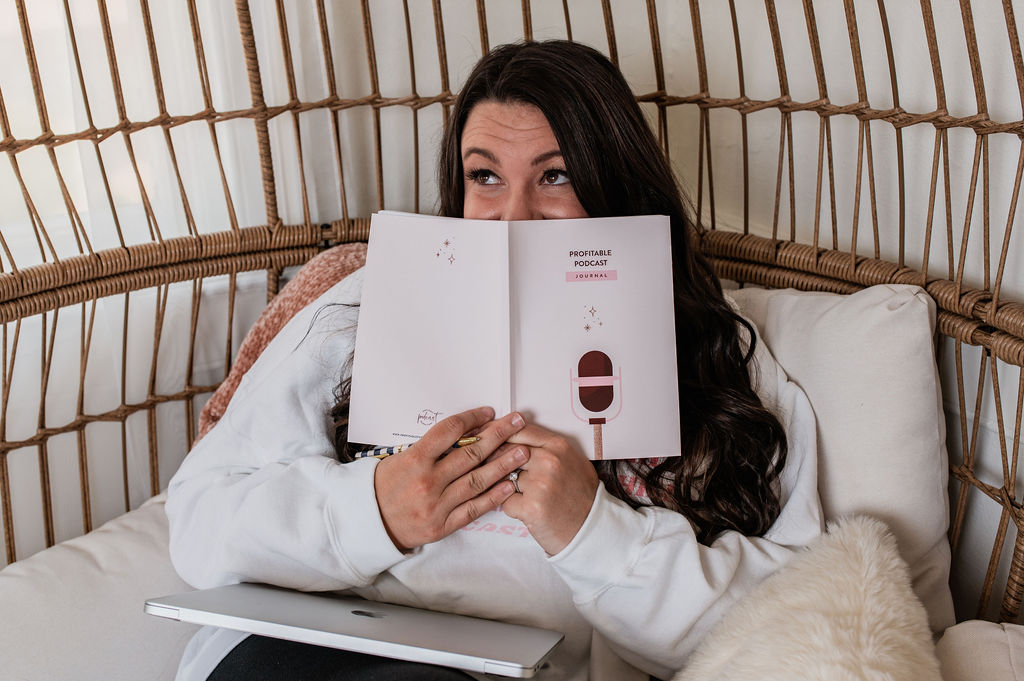
Today, I want to talk to you about tips for podcasting and why a holistic approach will serve you in your business. In this week’s blog, we are diving into the benefits of a holistic approach with your podcast, and why a traditional approach won’t serve your business in the long run.
In case this is your first time tuning in, let me introduce myself. My name is Tara Counterman. I’m the founder and CEO of Profitable Podcast Productions, the creator of Profitable Podcast School and basically, 1000% obsessed with helping online entrepreneurs step out of the busywork, stop struggling for paying clients and actually get their message out there.
So if you’re ready to dive into this post and get my top tips for podcasting and why the traditional approach to podcasting isn’t serving your business, check out the points I share below!
TIPS FOR PODCASTING: A BREAKDOWN OF WHAT THE TRADITIONAL PODCAST APPROACH IS.

My first tip for podcasting is to avoid a traditional podcast approach. I will break down what the traditional podcast approach looks like and why you should wipe it out of your brain completely. This approach focuses on download numbers and unrelated paid sponsorships. If you have been around awhile, you know I’m anti-paid sponsorships when it comes to online coaches, course creators, and service providers. You want to keep the attention and the focus of your listeners, your listeners are a warm market and pool of people gobbling up what you have to say. These are people who are ready for you to offer something for them.
When you focus on what your download numbers are and securing unrelated paid sponsorships, what we’re doing is distracting our audience from what they are there for – you. They are there for your expertise, knowledge, and experience. When you dilute that with all of these different paid sponsorships, your message gets lost. You, as an online coach, want to focus on bringing attention to your offers. When you offer something else on your podcast platform, people will subconsciously assume you can’t serve them in the areas you are talking about.
TIPS FOR PODCASTING: WHEN YOU CREATE CONTENT FOR THE SAKE OF CREATING CONTENT, A LOT OF TIMES YOU ARE DISTRACTING YOUR AUDIENCE.

I believe in collaboration over competition, I am not saying you shouldn’t have guest experts on your podcast. However, when we are creating interviews simply to have new episodes come out on our podcast, that content is not working for you. You want to make sure everything you do has a purpose behind it, whether it’s to entertain your audience, bring awareness to a problem, whatever it may be. Another one of my tips for podcasting is to ensure you aren’t creating content for the sake of creating content. Everything should have a purpose behind it. Another common theme with traditional podcasting is relying on interviews to fill episode gaps. You may have found yourself recording an interview because you didn’t know what to talk about or it’s just easier than planning out your episode. When you do this, you are probably distracting your audience. Think about this, whether you are a business coach, health coach, when you have people come onto your show but they talk about something you’re not, that distracts your audience on a subconscious level. For example, you’re launching a course on Instagram, but that same week you have a guest on your show who’s talking about LinkedIn. When you are talking about the content you’re putting out, but now you also have an episode about something completely different, it can be confusing. The more we confuse our audience or pull them into different directions, the less clarity they’ll have on the investments they need to make.
TIPS FOR PODCASTING: WHEN YOU FOLLOW THE HOLISTIC PODCAST APPROACH, IT HELPS YOU MAXIMIZE ONLINE PRESENCE ON ALL PLATFORMS.

One of my top tips for podcasting is to follow a holistic podcast approach. If you tried to go live and post on every single social media platform organically, you would be creating content constantly. What’s great about macro content and podcasting is that you can maximize your online presence on all platforms by focusing on the macro content and doing it holistically. This way, it can bleed out into all the other places. You can connect with people who are different versions of your ideal client, who simply consume content differently. You can make content work harder for you, but you must be intentional and look at it from a holistic lens. This is part of my business, not a separate entity.
The holistic podcast approach also positions the creator in their CEO role where they can be fully supported. So many management clients that come to me are burnt out from podcasting and creating content over and over again. If you say something once, you shouldn’t have to say it again. Consistent messaging is so important when it comes to nurturing and priming, when we change our messaging and don’t stay consistent, then it won’t fully sink in and integrate for your audience. This is important to remember, we should be repeating the same messaging but you can say it once and maximize it on all platforms in multiple ways.
TIPS FOR PODCASTING WITH A HOLISTIC APPROACH TO SERVE YOUR BUSINESS: THE BOTTOMLINE
I hope these tips for podcasting and more insight on a holistic approach was valuable for you! When you focus on creating content and lean in to a holistic podcast approach, your brand will have a next level of cohesiveness. Everything will be layered together and work together powerfully for you. I wanted to provide you a breakdown of the traditional podcast approach and why it’s so important we break away from it and not follow that approach anymore. You need to look at your podcast through a more holistic lens. And if you love this blog post as much as I do, don’t forget to take a screenshot, share it on your Instagram stories and tag me @profitablepodcastproductions so that we can spread this important message to even more entrepreneurs and online business owners!
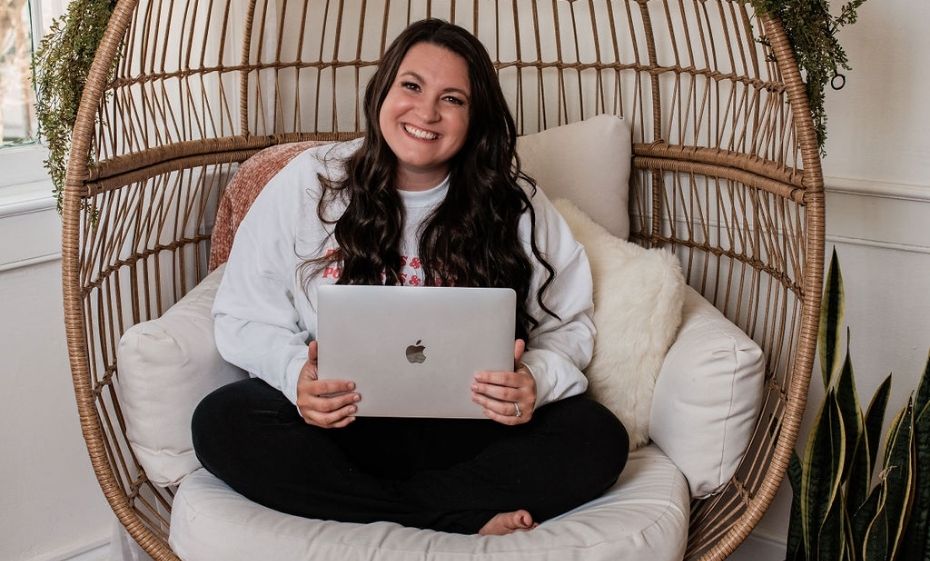
Today, I want you to take a hard look and evaluate what it is you’re doing in your business and where you are putting your energy. In this week’s blog post, we are diving deeper into developing a content strategy focused on growing your podcast. In case this is your first time tuning in, let me introduce myself. My name is Tara Counterman. I’m the founder and CEO of Profitable Podcast Productions, the creator of Profitable Podcast School and basically, 1000% obsessed with helping online entrepreneurs step out of the busywork, stop struggling for paying clients and actually get their message out there. So if you’re ready to dive into this blog post and get my top tips on how you can implement a content strategy that works effectively and grows your podcast, keep reading!
INVESTING TIME ON A STRATEGY, POINT #1: IF YOUR CONTENT ISN’T WORKING FOR YOU, THERE’S NO REASON TO INVEST ALL THIS TIME AND ENERGY THAT CONTENT CREATION REQUIRES.

When it comes to time investment, something that I see a lot in this industry that I want to help bring more change and awareness to is spinning in circles creating content that isn’t working for us. If your content isn’t working for you, there’s no reason to invest all this time and energy that content creation requires. We must step back and check-in with ourselves. We need to evaluate how we are showing up in different areas for our business. As a growing business owner, you will always reach new levels and have to adjust or make changes. This is normal and we are always evolving.
It’s so important that we don’t continue doing things just because we’ve always done it that way or just because everyone else is doing it that way. One of the biggest areas that I see this pop up is when it comes to our overall strategy for podcasting. Most of us don’t realize that podcasting is a platform for you to implement strategy. Strategy is so important when it comes to the places that we show up to grow our business. With podcasters, I see that most tend to keep it separate from their business.
INVESTING TIME ON A STRATEGY, POINT 2: IF YOU ARE PODCASTING WITH NO STRATEGY, YOU’RE NOT GOING TO BE GETTING THE RESULTS YOU COULD BE WITH YOUR SHOW.

I want you to sit down and evaluate your show right now, and your time investment. The truth is that if you are podcasting with no content strategy and winging it, you are not going to get the results you could be with your show. You won’t bring in clients, and especially if you’re in a place where you are editing the podcast yourself, creating content, promoting it, writing the copy, it is mentally and physically exhausting. You will slip into this pattern where you start to question why you’re even showing up to podcast in the first place. Or you may get caught up in vanity numbers instead of what will help your business move forward.
We have to sit with the fact that it’s okay to start something and wing it, figure it out as you go, but right now I want you to gut check and evaluate how you are showing up. Ask yourself how much time investment you are giving to something that may not be giving you back what it could. You can make more money but you can’t get your time back. If you aren’t investing your time smartly and into things that will bring a return to you, why are you doing it? This is something that can work for you but we have to have some sense of a strategy or plan to follow and implement.
INVESTING TIME ON A STRATEGY, POINT 3: YOUR TIME IS VALUABLE AND YOU SHOULD ONLY BE SPENDING IT IN PLACES THAT MAKE SENSE.

We all know podcasting is a labor of love, but you can be strategic about the time investment you are putting in and incorporating business strategy so that it does have a return. It all starts with you first evaluating yourself in the mirror – are you a part of a toxic relationship with your podcast? What is your podcast doing for your business? If the answer is nothing, that is a whole lot of time you could be spending somewhere else. That’s time you could spend with your family, clients, and launching programs.
It’s so important that you understand that your time is valuable. You should only be spending it in places that make sense. I have built a whole business surrounding the idea that the time and energy you put into podcasting shouldn’t be like nurturing a toxic relationship, that it is something bringing you leads and sales. This doesn’t happen when you’re winging it without any content strategy. There are solutions out there for you to learn to do podcasting profitably, you have to be willing to invest time, effort, energy, and maybe even finances to learn how you can do just that.
INVESTING TIME ON A STRATEGY THAT GETS RESULTS: THE BOTTOMLINE
I want you to look at the time investment you put into your podcast. I want you to physically clock yourself on the time you spend prepping, recording, editing, social media promotion, everything involved with your podcast. Compare this time to what you are getting out of it. Does that input and output feel good for you? Are you getting a return on your investment? Remember, you can always make more money but you can’t make more time. And if you love this blog post as much as I do, don’t forget to take a screenshot, share it on your Instagram stories and tag me @profitablepodcastproductions so that we can spread this important message to even more entrepreneurs and online business owners!
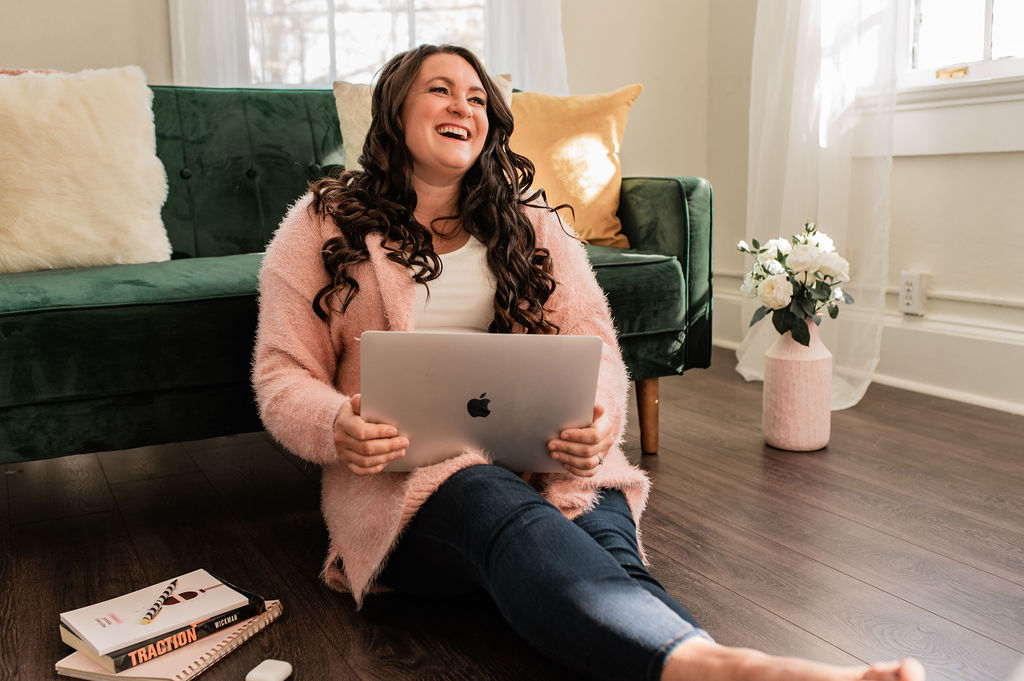
Are you a business owner looking to seriously take things to the NEXT level?
Well, I’ve got just the strategy for you.
It’s a total game-changer and it brings INSANE rewards to any business whether you’re a coach, course creator, service provider, entrepreneur, you name it!
Can you guess what that strategy is….?
Podcasting!
Having a podcasting platform can do SO much for your business and that’s exactly what we’re covering in today’s post. I’ll be diving into 6 reasons that you should jump into podcasting and start incorporating it into your current biz strategy. Sound good? Let’s dive right in then!
Podcasting is really popular, if you haven’t noticed.

Listen to this crazy statistic – over the last 5 years, the number of podcast listeners has jumped from 25 million to over 75 million. That’s A LOT of podcast listeners if you ask me.
There’s a lot of potential right now in this industry and while some may say it’s becoming oversaturated, I can assure you that’s definitely not the case.
Right now is totally the PRIME time to be jumping in and starting to build your podcast!
People are BUSY! We’re constantly on the go, and podcasting is the best tool for that.
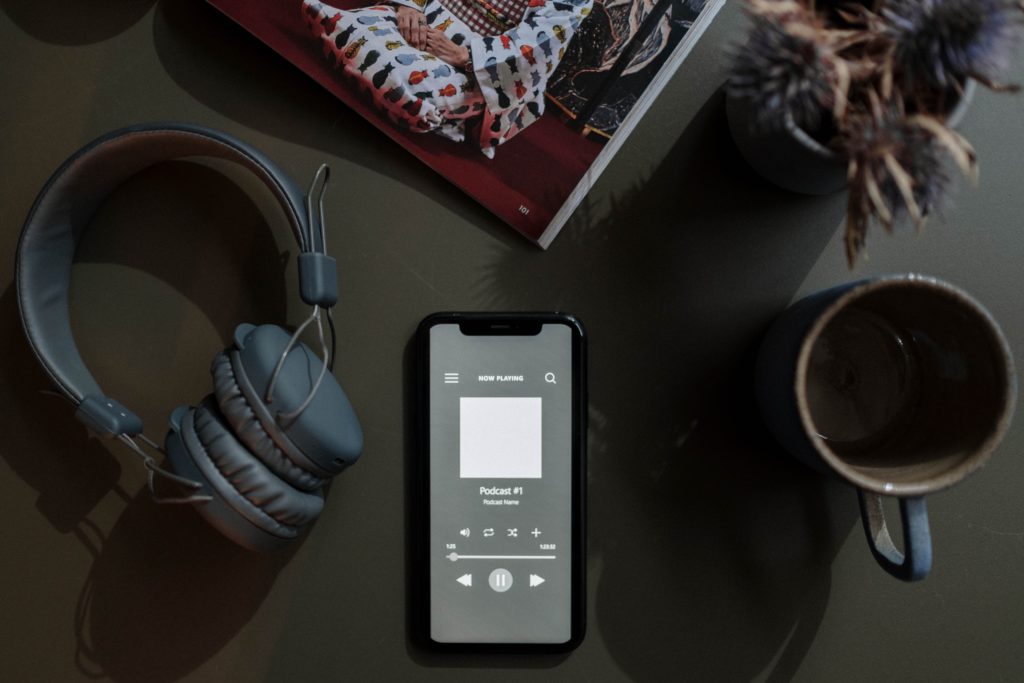
So aside from the fact that podcasting is INSANELY popular right now, let’s talk about how on demand it is.
Right now, people are plugging in their headphones and tuning into their favorite podcast shows while they grocery shop, clean the house, workout, take the dog for a walk, I mean the list goes on and on.
This is REALLY powerful if you think about it. There’s no better way to build such a strong connection than literally speaking right to your ideal client through their earbuds.
While Facebook and Instagram live are great tools, sometimes people just don’t have the time to sit down and watch your live videos! So instead, podcasting solves the problem and still allows them to absorb your value while dealing with their day-to-day life chaos!

LISTEN ON SPOTIFY | LISTEN ON APPLE PODCASTS | LISTEN ON GOOGLE PLAY
Podcasting is equivalent to Netflix. Bingeable good old Netflix.

Come on, who doesn’t love a GOOD binging session on Netflix? It’s one of my favorite weekend past-times!
Well, the same goes for a podcast.
How great would it be to have your ideal clients listening to HOURS of your content without even having to click Next?
That’s the powerful key behind a podcast that NO other social media platform offers.
Not only that, podcasting is the only place people go to listen to OLDER content. Every episode you record and air will literally live forever and can reach your ideal clients YEARS later. How cool is that?!
Long-lasting content FOR THE WIN!

Touching a bit on my last point, having a podcast sets you up for LONG-TERM and LONG-LASTING shelf life.
These days, an Instagram post has virtually no life, a story lasts 24 hours, and our feeds are constantly being flooded with new images, videos, and content! It never ends.
Whereas with a podcast, people can search and come across your episodes from years back. Not only that, when they do come across your podcast and finish an episode, they’ll automatically be directed to listen to ANOTHER one of your episodes.
The relationship you build between yourself and your podcast listener is unbeatable.
As great and inspiring as an Instagram caption can be, NOTHING beats hearing someone speak to you through your earbuds.
A podcast is truly the place to build that deeper and authentic connection with your ideal clients. Why? First of all, your ideal clients are voluntarily seeking out your podcast! Whereas we sometimes get flooded with unwanted content on Instagram, a Podcast is much more intentional.
This is really the place to build that trust and to finally reach your target audience in ways you never would have imagined.
You ALWAYS want to incorporate shareable content into your business strategy – and podcasting does JUST that.
As great and inspiring as an Instagram caption can be, NOTHING beats hearing someone speak to you through your earbuds.
A podcast is truly the place to build that deeper and authentic connection with your ideal clients. Why? First of all, your ideal clients are voluntarily seeking out your podcast! Whereas we sometimes get flooded with unwanted content on Instagram, a Podcast is much more intentional.
This is really the place to build that trust and to finally reach your target audience in ways you never would have imagined.
If you’re really looking to maximize your voice and your mission, podcasting is the place to be!
Especially these days as podcasting grows in popularity, people are often sharing their current favorite shows to stream! It’s very likely that yours will come up in a conversation or maybe be re-shared on social media, therefore reaching EVEN more people. Pretty cool right?
Thanks for reading!
Now you have the FULL tea on why you need a podcast incorporated into your business strategy like… ASAP. There’s so many benefits and it’s really worth your energy as a business owner if you’re seeking that authentic and powerful connection with your ideal clients.
So, stop hesitating and make the plunge!
If you found this post helpful and you plan to finally dive into podcasting, I’d love to know more about it! You can connect with me on Instagram. Catch you in the next post!
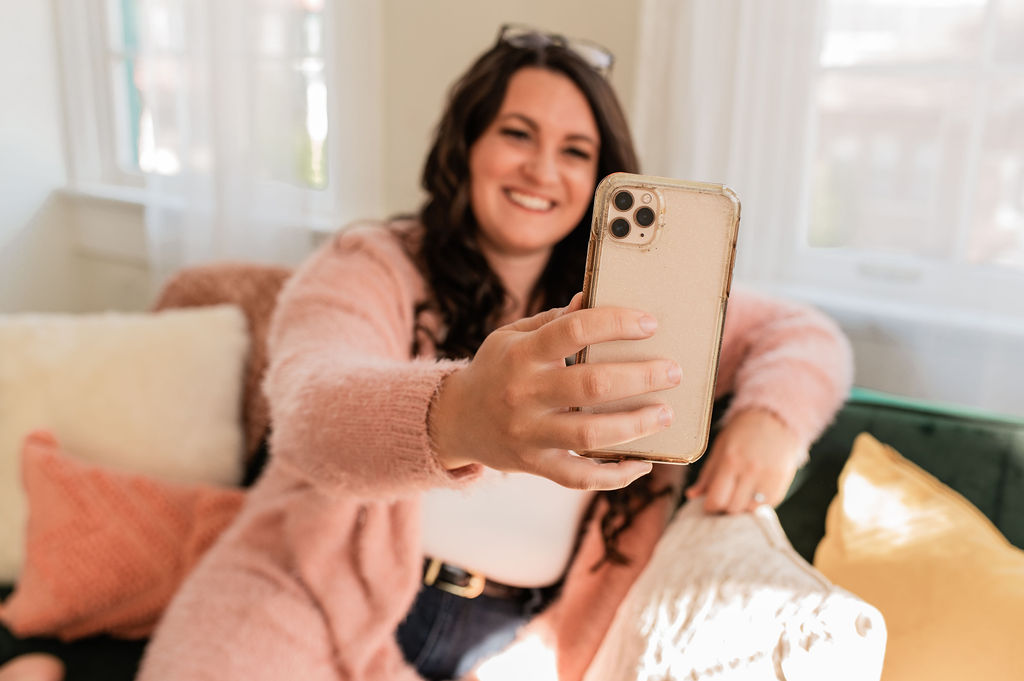
Has starting a podcast been on your mind?
Wondering how having a podcast can leverage and scale your business?
…. but not sure where to even BEGIN?
Look no further! In this post, we’re diving into the ultimate step-by-step guide to starting a podcast and ALL the juicy details. Including tools and tricks, as well as the mindset YOU need to have in order to set yourself up for success with your podcast! Let’s jump right in.
All the different roles and responsibilities to expect with your podcast. (And how I can help!)

I like to set REALISTIC expectations and make it CLEAR to my clients before they start a podcast as to what it all entails. Believe it or not, there’s a WHOLE lot more that goes into podcast creation aside from sitting down and talking into a microphone.
Not only do you need to develop creative ideas for your podcast, record the audio, edit, and publish, but you also need to think about things like…
-Writing copy for your show notes
-Writing promotional material for social media
-Planning your entire show AROUND your business
-Establishing a strong personal brand, and so on..
I do NOT share this to scare you! In fact, quite the opposite. By entering the podcasting world with these expectations, you can clearly set yourself up for success and map out your plan effectively.
If you find yourself needing some support in these various roles, don’t worry! That’s where I come in to save the day. Check out all of my other content right here on the blog for more on building your podcast in a holistic and profitable way, you can also check out our services and get more information on how our team can assist with your podcast launch or ongoing management.
Thinking to do interviews on your podcast? Stop and read this first!

Interviews can be an AWESOME feature for your podcast. However, it can go totally sideways too.
For example, have you ever been listening to an interview on one podcast and then heard another very similar on another? You’re not alone. It happens way more often than it should.
When it comes to interviews, it’s easy to get into a routine of asking predictable questions and relying on the same tried-and-true structure for an interview.
While that’s great… I’m here to tell you that you can do SO much more with your interviews!
As a prime example of what I mean, check out our other content right here in this blog where I feature incredible industry leading coaches and entrepreneurs. You’ll get a sense of what I mean by taking a unique approach to an interview and really get to know the guests on a TOTALLY different level than you ever imagined.
Take this as a reminder to get creative, keep it fun, and definitely don’t feel the pressure to follow the same pattern every other podcaster is doing with their interviews.

LISTEN ON SPOTIFY | LISTEN ON APPLE PODCASTS | LISTEN ON GOOGLE PLAY
You gotta treat your podcast like a business. And here’s why:

A lot of times, people start podcasts just to start one.
They don’t really have a clear mission or goal behind the podcast.
I will tell you RIGHT now, if you enter the podcasting world with that mentality, it’s going to be a rough journey.
Trust me, I GET IT. I have BEEN THERE, DONE THAT.
When I first started podcasting, I just poured all of my energy and love into it. I didn’t necessarily have a plan in mind of how it was going to actually help my business.
The result? Exhaustion, burn out, and a lack of clarity.
I don’t want that for you! So instead, I urge you to be intentional. Map out your plan, think about your goals, and wrap all of that into a powerful and meaningful podcast strategy.
Your podcast is NOT about you.
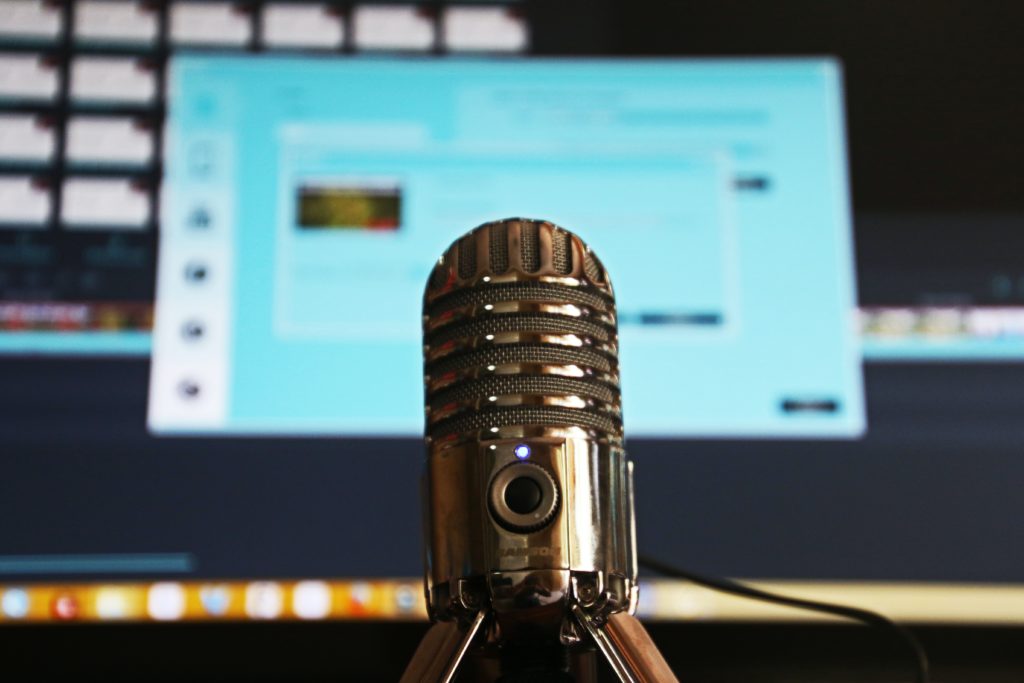
Sounds weird, right?
Let me explain.
If you want to grow a successful podcast that’s going to reach the top of the charts in iTunes, you HAVE to hone in on your target audience.
WHO is the person that’s going to be putting in their earbuds listening to your voice?
That is the person you are talking to, that is WHO your podcast is about. It’s not about you, it’s about the listener.
This will come into play when you’re also determining your podcast episode topics or promoting your podcast via social media. You need to get to a place where you’re constantly asking yourself if your IDEAL listener needs this. Would this benefit that listener?
Get into a habit of checking in with yourself to ensure you’re not producing content that’s focused on your own needs, rather, the listener’s needs.
Thanks for reading!
I sincerely hope this post brings you so much value as you embark on this very exciting new chapter with your podcast! I am rooting and cheering for you. It’s a big step but it’s also going to bring MASSIVE rewards to your business and your audience.
There’s nothing more powerful than connecting with someone through their headphones, remember that.
If you found this post helpful, I’d love to hear your feedback! You can connect with me on Instagram. See you in the next one!